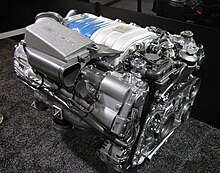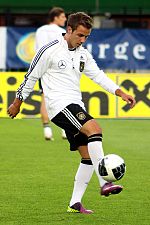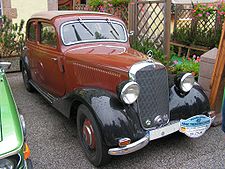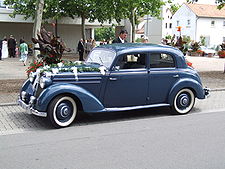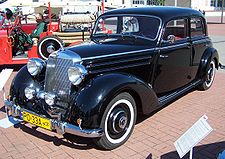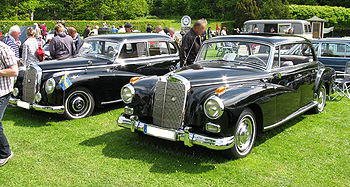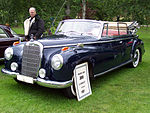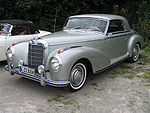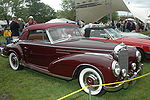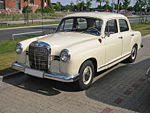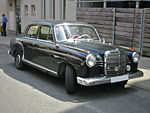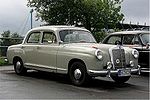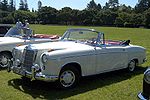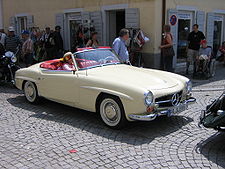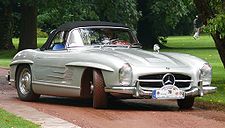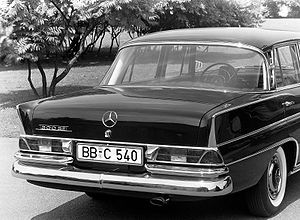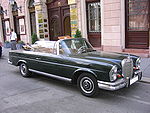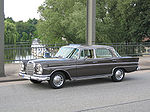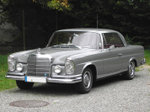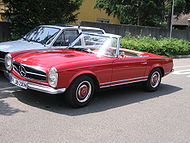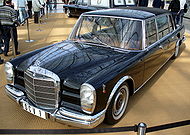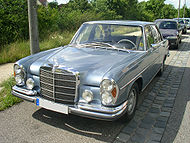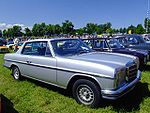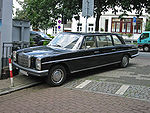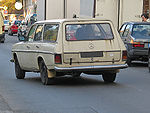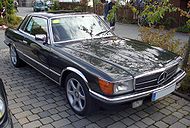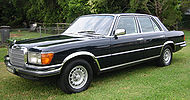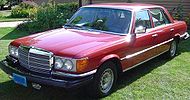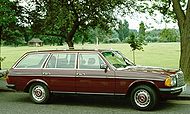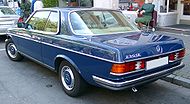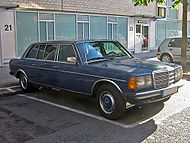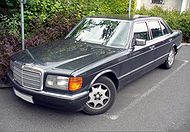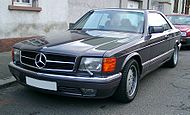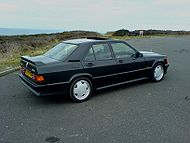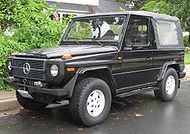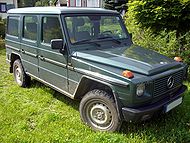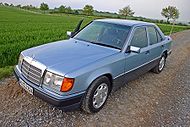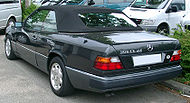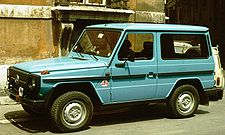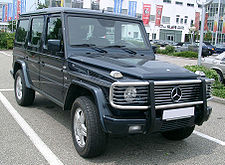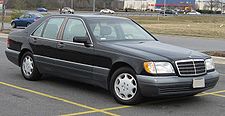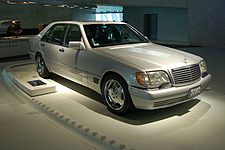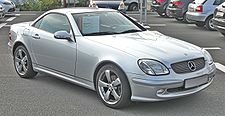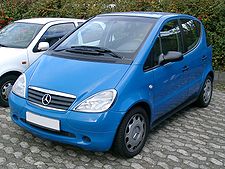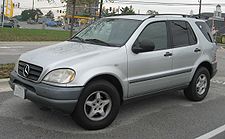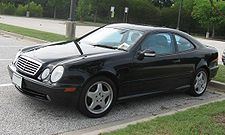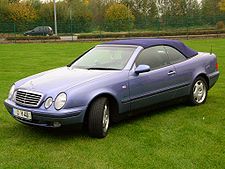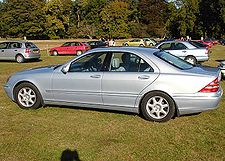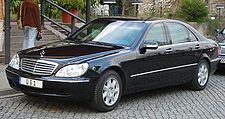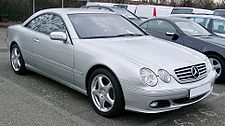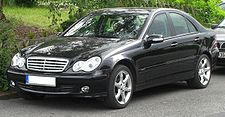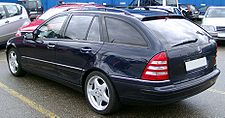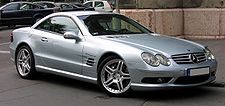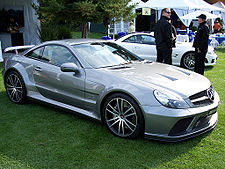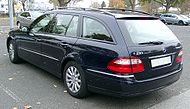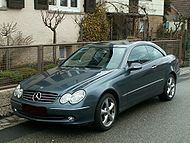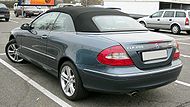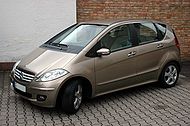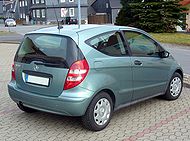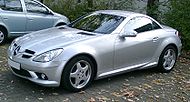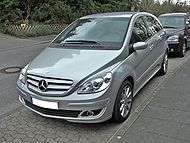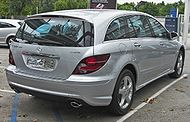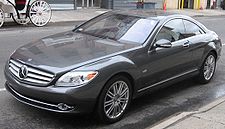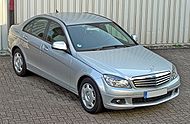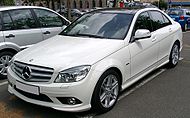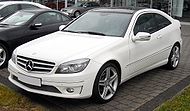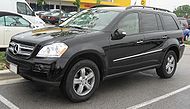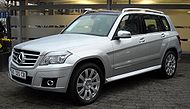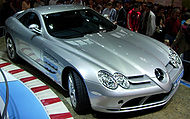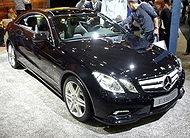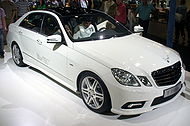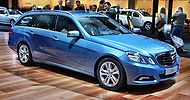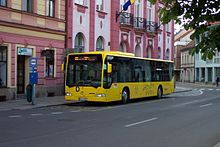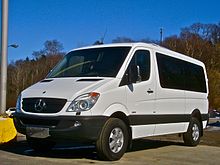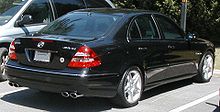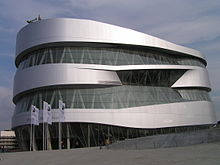Как правильно пишется слово ««Мерседес-Бенц»»
«Мерседе́с-Бе́нц»
«Мерседе́с-Бе́нц», «Мерседе́са-Бе́нц» (марка автомобиля) и мерседе́с-бе́нц, мерседе́са-бе́нц (автомобиль)
Источник: Орфографический
академический ресурс «Академос» Института русского языка им. В.В. Виноградова РАН (словарная база
2020)
Делаем Карту слов лучше вместе
Привет! Меня зовут Лампобот, я компьютерная программа, которая помогает делать
Карту слов. Я отлично
умею считать, но пока плохо понимаю, как устроен ваш мир. Помоги мне разобраться!
Спасибо! Я стал чуточку лучше понимать мир эмоций.
Вопрос: денационализация — это что-то нейтральное, положительное или отрицательное?
Ассоциации к слову «мерседес-бенц»
Синонимы к слову «мерседес-бенц»
Предложения со словом «мерседес-бенц»
- Но денег, которых им удалось наскрести, хватило только на старый, разбитый «Мерседес-Бенц».
- Первоначально танк 2С был оснащён двумя трофейными двигателями «Мерседес-Бенц» GIII, ранее использовавшихся в германских дирижаблях.
- Даже по территории завода «Мерседес-Бенц» рабочие передвигаются на велосипедах, и у каждого подразделения они своего цвета!
- (все предложения)
Отправить комментарий
Смотрите также
-
Но денег, которых им удалось наскрести, хватило только на старый, разбитый «Мерседес-Бенц».
-
Первоначально танк 2С был оснащён двумя трофейными двигателями «Мерседес-Бенц» GIII, ранее использовавшихся в германских дирижаблях.
-
Даже по территории завода «Мерседес-Бенц» рабочие передвигаются на велосипедах, и у каждого подразделения они своего цвета!
- (все предложения)
- сидеть за рулём
- тонированные стёкла
- номерные знаки
- повышенная проходимость
- автоматическая коробка передач
- (ещё синонимы…)
- машина
- дорога
- марка
- автомобиль
- Мерседес
- (ещё ассоциации…)
This article is about the brand and the namesake vehicle manufacturer. For other uses, see Mercedes-Benz (disambiguation).
 |
|
| Product type | Automotive |
|---|---|
| Owner |
|
| Country | Germany |
| Introduced | 28 June 1926; 96 years ago |
| Website | mercedes-benz.com |
 |
|
| Type | Subsidiary (AG)[1] |
|---|---|
| Industry | Automotive |
| Predecessor | Mercedes-Benz division of Daimler AG |
| Founded | November 2019; 3 years ago |
| Headquarters |
Stuttgart , Germany |
|
Area served |
Worldwide |
|
Key people |
Ola Källenius, Chairman of the Board of Management and CEO[2] |
| Products |
|
|
Production output |
2,164,187 cars worldwide (2020)[3] |
| Brands |
|
| Services |
|
| Parent | Mercedes-Benz Group[1] |
| Divisions |
|
| Subsidiaries |
|
| Website | mercedes-benz.com |
Mercedes-Benz (German pronunciation: [mɛɐ̯ˈtseːdəsˌbɛnts, -dɛs-] (listen)),[6][7] commonly referred to as Mercedes and sometimes as Benz, is a German luxury and commercial vehicle automotive brand established in 1926. Mercedes-Benz AG (a Mercedes-Benz Group subsidiary established in 2019) is headquartered in Stuttgart, Baden-Württemberg, Germany.[1] Mercedes-Benz AG produces consumer luxury vehicles and commercial vehicles badged as Mercedes-Benz. From November 2019 onwards, Mercedes-Benz-badged heavy commercial vehicles (trucks and buses) are managed by Daimler Truck, a former part of the Mercedes-Benz Group turned into an independent company in late 2021. In 2018, Mercedes-Benz was the largest brand of premium vehicles in the world, having sold 2.31 million passenger cars.[8]
The brand’s origins lie in Daimler-Motoren-Gesellschaft’s 1901 Mercedes and Carl Benz’s 1886 Benz Patent-Motorwagen, which is widely regarded as the first internal combustion engine in a self-propelled automobile. The slogan for the brand is «the best or nothing».[9]
History[edit]
Mercedes-Benz traces its origins to Karl Benz’s creation of the first internal combustion engine in a car, seen in the Benz Patent Motorwagen – financed by Bertha Benz’s dowry[10] and patented in January 1886[11] – and Gottlieb Daimler and their engineer Wilhelm Maybach’s conversion of a stagecoach, with the addition of a petrol engine, introduced later that year. The Mercedes automobile was first marketed in 1901 by Daimler Motoren Gesellschaft (DMG).
Emil Jellinek, a European automobile entrepreneur who worked with DMG, registered the trademark in 1902, naming the 1901 Mercedes 35 hp after his daughter Mercedes Jellinek. Jellinek was a businessman and marketing strategist who promoted «horseless» Daimler automobiles among the highest circles of society in his adopted home. At the time, it was a meeting place for the haute volée of France and Europe, especially in winter. His customers included the Rothschild family and other well-known people, but Jellinek’s plans went further, and as early as 1901, he was selling Mercedes cars in the «New World», as well, including United States billionaires Rockefeller, Astor, Morgan, and Taylor. At the Nice race he attended in 1899, Jellinek drove under the pseudonym «Monsieur Mercédès» as a way of concealing his less fancy real name. Many consider that race the birth of Mercedes-Benz as a brand. In 1901, the name «Mercedes» was re-registered by DMG worldwide as a protected trademark.[12] The first Mercedes-Benz branded vehicles were produced in 1926, following the merger of Karl Benz and Gottlieb Daimler’s companies into the Daimler-Benz company on 28 June of the same year.[11][13]
Gottlieb Daimler was born on 17 March 1834 in Schorndorf. After training as a gunsmith and working in France, he attended the Polytechnic School in Stuttgart from 1857 to 1859. After completing various technical activities in France and England, he started working as a draftsman in Geislingen in 1862. At the end of 1863, he was appointed workshop inspector at a machine-tool factory in Reutlingen, where he met Wilhelm Maybach in 1865.[14]
Throughout the 1930s, Mercedes-Benz produced the 770 model, a car that was notably popular throughout Germany’s Nazi period. Adolf Hitler was known to have driven in a model of this car during his time in power, with modified custom bulletproof windshields.[15] Most of the currently surviving 770 models were sold at auctions to private buyers. One of the cars is currently on display at the War Museum in Ottawa, Ontario. The pontiff’s Popemobile has often been sourced from Mercedes-Benz.[16]
From 1937 onward, Daimler Benz focused increasingly on military products such as the LG3000 lorry and the DB600 and the DB601 aero engines. To build the latter, in 1936, it built a factory hidden in the forest at Genshagen around 10 km south of Berlin. By 1942, the company had mostly stopped producing cars, and was now devoted to war production. According to its statement, in 1944, almost half of its 63,610 employees were forced labourers, prisoners of war, or concentration-camp detainees.[17] Another source quotes this figure at 46,000. The company later paid $12 million in reparations to the labourers’ families.[18]
In 1958, the two companies began a partnership to sell their cars in the United States with Studebaker. A few American-based Daimler Benz dealerships were converted into Mercedes-Benz dealerships when Daimler’s non-Mercedes-partnered company closed in 1966.
Over the decades, Mercedes-Benz has introduced many electronic and mechanical innovations and safety features that later became common.[19] Currently, Mercedes-Benz is one of the best-known and longest-standing automotive brands in the world.
In November 2019, Daimler AG announced that Mercedes-Benz, until that point a company marque, would be spun off into a separate, wholly owned subsidiary called Mercedes-Benz AG. The new subsidiary would manage the Mercedes-Benz car and van business. Mercedes-Benz-badged trucks and buses would be part of the Daimler Truck AG subsidiary.[1]
For information relating to the three-pointed star symbol of the brand, see under the title Daimler-Motoren-Gesellschaft, including the merger into Daimler-Benz.
In May 2022, Mercedes-Benz announced that it has recently sold the most expensive car at the price of $142 million. The car is a very rare 1955 Mercedes-Benz SLR that has been kept in the German automaker’s collection and bought by a private owner. Mercedes in an announcement said that the sale will be used to establish the Mercedes-Benz Fund.[20]
In June 2022, Mercedes-Benz recalled almost one million vehicles built between 2004 and 2015, due to potential problems with their braking system, caused by possible «advanced corrosion».[21]
Subsidiaries and alliances[edit]
As of the Daimler AG company split, the Mercedes-Benz Cars division now handled the Mercedes-Benz- and the Smart-branded cars’ production.[22]
Mercedes-AMG[edit]
Mercedes-AMG became a majority-owned division of Mercedes-Benz in 1999.[23] The company was integrated into DaimlerChrysler in 1999,[24] and became Mercedes-Benz AMG on 1 January 1999.[25]
Mercedes-Maybach[edit]
Daimler’s ultraluxury Maybach brand was under the Mercedes-Benz Cars division until December 2012, when production was stopped due to decreased sales.[26] It now exists under the Mercedes-Maybach name, with the models being luxury-focused, enhanced models of Mercedes-Benz cars, such as the 2016 Mercedes-Maybach S600.[27] The Mercedes-Maybach GLS 600 SUV debuted in November 2019.[28]
China[edit]
Daimler partnered with BYD Auto to make and sell a battery-electric car called Denza in China.[29] In 2016, Daimler announced plans to sell Mercedes-Benz-badged fully electric battery cars in China.[30] Beijing Benz is a joint venture with the BAIC Group to produce the Mercedes-Benz branded cars in China.[31] In 2018, Mercedes-Benz voluntarily apologized for sparking controversy within China by quoting the Dalai Lama on one of their promotional Instagram posts.[32]
Production[edit]
Factories[edit]
Other than in its native birthplace, Germany, Mercedes-Benz vehicles are or have been partly manufactured or assembled in:
| Sovereign state | Continent | Note |
|---|---|---|
| Algeria | Africa | Manufactures buses and trucks in cooperation with SNVI (Actros, Zetros, Unimog, and G-Class, Sprinter). |
| Argentina | South America | Manufactures buses, trucks, the Vito and the Sprinter van. This is the first Mercedes-Benz factory outside of Germany. Built in 1951.[33] |
| Australia | Australia | Various models were assembled at the Australian Motor Industries facility in Port Melbourne from 1959 to 1965.[34] |
| Austria | Europe | G-Class[35] |
| Bosnia and Herzegovina | Europe | |
| Brazil | South America | Manufactures trucks and buses. Established in 1956. The A-Class (W168) was produced from 1999 to 2005 and the C-Class was produced until 2010 as well.[36] |
| Canada | North America | Fuel cell plant in Burnaby, British Columbia, opened 2012. |
| Colombia | South America | Assembly of buses, Established in Soacha 2012 and Funza 2015 |
| China | Asia | Beijing Benz, manufactures A-Class, C-Class, E-Class, GLA, GLB, GLC and EQC for mainland China market. |
| Denmark | Europe | Bohnstedt-Petersen A/S assembled the models 130 and W136 between 1935 and 1955, although no production took place during the Second World War. Between 1955 and 1966 the models W120, W121 and W110, together with the van L319 and a number of trucks and buses, were assembled by the company in Hillerød. Assembly of special variants of Mercedes-Benz trucks continued until 1984.[37] |
| Egypt | Africa | Via Egyptian German Automotive Company E-Class, C-Class and GLK |
| Finland | Europe | Valmet Automotive, New A-series (W176) is manufactured in Uusikaupunki since late 2013, being the first Mercedes-Benz passenger car ever built in that country. |
| Hungary[38] | Europe | Manufacturing plant in Kecskemét, making B-Class and CLA.[39] |
| Jordan | Asia | Bus company factory, Elba House, Amman. |
| India | Asia | Pune (C-Class, E-Class, S-Class, GLA, GLE and some AMG models).[40] Chennai (Daimler India Commercial Vehicles Pvt. Ltd.) Buses, Trucks & Engine Manufacturing unit, Bangalore (R&D), Jamshedpur with Tata Motors at Tata Motors.[41] |
| Indonesia[42] | Asia | Assembly of Axor, A, C, E, GLA, GLC, GLE, GLS, S class vehicles and select entry level AMG models. Manufactures coach buses. |
| Iran[43] | Asia | |
| Malaysia | Asia | Assembly of C, E and S class vehicles by DRB-HICOM. |
| Mexico | North America | Mercedes-Benz Mexico fully manufactures some Mercedes and Daimler vehicles completely from locally built parts (C-Class, E-Class, M-Class, International trucks, Axor, Atego, and Mercedes Buses), manufactures other models in complete knock down kits (CL-Class, CLK-Class, SL-Class, SLK-Class) and manufactures a select number of models in semi knockdown kits which use both imported components and locally sourced Mexican components (S-Class, CLS-Class, R-Class, GL-Class, Sprinter). |
| Nigeria | Africa | Assembly of buses, trucks, utility motors and the Sprinter van[44] |
| Russia | Eurasia | Joint venture Mercedes-Benz Car Trucks Vostok in Naberezhnye Chelny (jointly Kamaz). Available in trucks Actros, Axor, multi-purpose auto four wheel drive medium trucks Unimog. Mercedes-Benz Sprinter Classic is also produced in Russia. |
| Serbia | Europe | FAP produces Mercedes-Benz trucks under license. |
| Spain | Europe | Factory at Vitoria-Gasteiz Mercedes-Benz Vito, Viano and V-Class have been built there. |
| South Africa[45] | Africa | The assembly plant is located in East London, in the Eastern Cape province, where both right and left hand versions of the C-class are built. |
| South Korea | Asia | Mercedes-Benz Musso and MB100; Ssangyong Rexton Mercedes-Benz models manufactured by SsangYong Motor Company. |
| Taiwan | Asia | Assembly of Actros by the Shung Ye Group[46] |
| Thailand | Asia | Completely Knocked Down (CKD) production of A, GLA, C, E, S Classes and Semi-Knocked Down (SKD) production of C-coupe, GLC, GLC-coupe, GLE and CLS.[47] Additionally, local production of Mercedes-AMG such as C43, E53 and CLS53 have been integrated to the existing production lines[48] making it unofficially regarded as the largest Mercedes-Benz factory by number of classes produced under a single roof. The factory is operated by contract manufacture the Thonburi Group under supervision of Mercedes-Benz Manufacturing (Thailand).[49] |
| Turkey | Eurasia | Mercedes-Benz Türk A.Ş.[50] |
| United Kingdom | Europe | The SLR sports car was built at the McLaren Technology Centre in Woking. Brackley, Northamptonshire, is home to the Mercedes Grand Prix factory, and Brixworth, Northamptonshire is the location of Mercedes-Benz HighPerformanceEngines |
| United States | North America | The Mercedes-Benz GLE-Class Sport Utility, the full-sized GL-Class Luxury Sport Utility and the Mercedes-Benz C-Class vehicles are all built at the Mercedes-Benz U.S. International production facility near Tuscaloosa, Alabama.[51] Trucks (6,000 per year in the early eighties) were once assembled in Hampton, Virginia.[52] |
| Vietnam | Asia | Assembly of E-Class, C-Class, S-Class, GLK-Class and Sprinter. Established in 1995.[53] |
Quality rankings[edit]
Mercedes-Benz dealer in Munich, Germany
Mercedes-Benz normally has a strong reputation for quality and durability. Some objective measures looking at passenger vehicles, such as J. D. Power surveys, demonstrated a downturn in reputation in these criteria in the late 1990s and early 2000s. By mid-2005, Mercedes temporarily returned to the industry average for initial quality, a measure of problems after the first 90 days of ownership, according to J. D. Power.[54] In J. D. Power’s Initial Quality Study for the first quarter of 2007, Mercedes showed dramatic improvement by climbing from 25th to 5th place and earning several awards for its newer models.[55] For 2008, Mercedes-Benz’s initial quality rating improved by yet another mark, to 4th place.[56] On top of this accolade, it also received the Platinum Plant Quality Award for their Mercedes branded Sindelfingen, Germany body assembly plant.[56] J. D. Power’s 2011 US Initial Quality and Vehicle Dependability Studies both ranked Mercedes-Benz vehicles above average in build quality and reliability.[57][58] In J. D. Power’s United Kingdom Survey in 2011, Mercedes cars were rated above average.[59] Additionally, iSeeCars.com study for Reuters in 2014 found Mercedes to have the lowest vehicle recall rate out of competitors.[60]
Models[edit]
Current model range[edit]
Mercedes-Benz offers a versatile range of consumer-passenger, light commercial and heavy commercial equipment. These vehicles are manufactured in multiple countries worldwide. The Smart marque of city cars are also produced by Daimler AG.
Models[edit]
- A-Class – Subcompact luxury Hatchback and Sedan
- B-Class – Subcompact luxury Multi Purpose Vehicle
- C-Class – Compact executive luxury Sedan/Saloon, Estate, Coupé and Cabriolet
- CLA – Subcompact luxury 4-Door Coupé and Estate
- CLS – Mid-size luxury 4-Door Coupé
- E-Class – Mid-size executive luxury Sedan/Saloon, Estate, Coupé and Cabriolet
- G-Class – Luxury off-road vehicle
- GLA – Subcompact luxury Crossover
- GLB – Compact luxury Crossover
- GLC – Compact luxury Sport utility vehicle
- GLE – Mid-size luxury Sport utility vehicle
- GLK — Compact luxury Sport utility vehicle
- GLS – Full-size luxury Sport utility vehicle
- S-Class – Full-Size luxury Sedan/Saloon, Coupé and Cabriolet
- V-Class – Luxury Multi Purpose Vehicle
- AMG GT – Luxury sports car
- AMG GT 4-Door – Luxury sports 4-Door Coupé
- AMG SL – Luxury grand tourer roadster
- AMG ONE – Super sports car
- EQA — Luxury electric Crossover
- EQB — Luxury electric Crossover
- EQC — Luxury electric Crossover
- EQE — Luxury electric Sedan/Saloon
- EQS — Luxury electric Sedan/Saloon
- EQE SUV — Luxury electric Sport utility vehicle
- EQS SUV — Luxury electric Sport utility vehicle
- EQV — Luxury electric Multi Purpose Vehicle
- EQG — Luxury electric Off-road vehicle
Vans[edit]
Mercedes-Benz currently offers three types of vans; Citan, Vito, and Sprinter. They are all produced by Daimler AG.
Trucks[edit]
Unimog, a famous allround vehicle by Mercedes-Benz
Since December 2021, the Mercedes-Benz Trucks division is part of the Daimler Truck company and includes other sub-companies that were part of the DaimlerChrysler merger. Gottlieb Daimler sold the world’s first truck in 1886.[61] Their first factory to be built outside Germany after World War II was in Argentina. They originally built trucks, many of which were modified by third parties to be used as buses, popularly named Colectivo.
Buses[edit]
Mercedes-Benz has been producing buses since 1895 in Mannheim, Germany. Since 1995, the brands of Mercedes-Benz’s buses and coaches are under the umbrella of EvoBus GmbH, since December 2021 belonging to Daimler Truck AG. EvoBus, through its regional subsidiaries, markets them in European countries, while in other regions of the world marketing and sales duties are passed to regional subsidiaries of Daimler Truck. Mercedes-Benz produces a wide range of buses and coaches, mainly for Europe and Asia. The first model was produced by Karl Benz in 1895.[62]
A STRAN Citaro (second generation) in June 2014
Significant models produced[edit]
- 1928: SSK racing car
- 1930: 770 «Großer Mercedes» state and ceremonial car
- 1934: 500 K
- 1936: 260 D World’s first diesel production car
- 1936: 170
- 1938: W125 Record-breaking experimental
- 1939: 320A
- 1951: 300, known as the «Adenauer Mercedes»
- 1953: «Ponton» models
- 1954: 300SL «Gullwing»
- 1956: 190SL
- 1959: «Fintail» models
- 1960: 220SE Cabriolet
- 1963: 600 «Grand Mercedes»
- 1963: 230SL «Pagoda»
- 1965: S-Class
- 1966: 300SEL 6.3
- 1968: W114 «new generation» compact cars
- 1969: C111 experimental vehicle
- 1972: W107 350SL
- 1974: 450SEL 6.9
- 1977: W123 — Mercedes’ first station wagon
- 1978: 300SD — Mercedes’ first turbo diesel
- 1979: 500SEL and G-Class
- 1983: 190E 2.3–16
- 1989: 300SL, 500SL
- 1990: 500E
- 1991: 600SEL
- 1993: C-Class
- 1995: C43 AMG
- 1995: SL73 AMG, 7.3 V12
- 1996: SLK
- 1997: A-Class and M-Class
- 2004: SLR McLaren and CLS-Class
- 2007: BlueTec E320, GL320 Bluetec, ML320 Bluetec, R320 Bluetec
- 2010: SLS AMG
- 2013: CLA-Class
- 2016: AMG GT
- 2019: Mercedes-Benz EQ
- 2021: Mercedes-Benz EQA
- 2022: Mercedes-Benz EQS
The Mercedes-Benz 600 or 600S Pullman Guard limousines offer the option of armour-plating and have been used by diplomats worldwide.[63]
Car nomenclature[edit]
Pre-1994[edit]
Until 1994, Mercedes-Benz utilized an alphanumeric system for categorizing their vehicles, consisting of a number sequence approximately equal to the engine’s displacement in liters multiplied by 100, followed by an arrangement of alphabetical suffixes, indicating body style and engine type.
- «C» indicates a coupe or cabriolet body style (for example, the CL and CLK models, though the C-Class is an exception, since it is also available as a sedan or station wagon).
- «D» indicates the vehicle is equipped with a diesel engine.
- «E» (for «Einspritzung») indicates the vehicle’s engine is equipped with petrol fuel injection. Also used for electric models and plug-in hybrids.
- «G» was originally used for the Geländewagen off-road vehicle, but is now applied to Mercedes SUVs in general (G, GLA, GLC, GLE, GLK, and GLS).
- «K» was used in the 1930s, indicating a supercharger («Kompressor») equipped engine. Three exceptions : the SLK, SSK and CLK, where K indicates «Kurz» (short-wheelbase) (though the SLK[64] and SSK had a supercharger).
- «L» indicates «Leicht» (lightweight) for sporting models and «Lang» (long-wheelbase) for sedan models.
- «R» indicates «Rennen» (racing), used for racing cars (for example, the 300SLR).
- «S» Sonderklasse «Special class» for flagship models, including the S-Class, and SL-Class, SLR McLaren, and SLS sports cars.
- «T» indicates «Touring» and an estate (or station wagon) body style.
Some models in the 1950s also had lower-case letters (b, c, and d) to indicate specific trim levels. For other models, the numeric part of the designation does not match the engine displacement. This was done to show the model’s position in the model range independent of displacement or in the price matrix. For these vehicles, the actual displacement in litres is suffixed to the model designation. An exception was the 190-class with the numeric designation of «190» as to denote its entry-level in the model along with the displacement label on the right side of the boot (190E 2.3 for 2.3-litre 4-cylinder petrol motor, 190D 2.5 for 2.5-litre 5-cylinder diesel motor, and so forth). Some older models (such as the SS and SSK) did not have a number as part of the designation at all.
1994 to 2014[edit]
For the 1994 model year, Mercedes-Benz revised the naming system. Models were divided into «classes» denoted by an arrangement of up to three letters (see «Current model range» above), followed by a three-digit (or two-digit for AMG models, with the number approximately equal to the displacement in litres multiplied by 10) number related to the engine displacement as before. Variants of the same model such as an estate version or a vehicle with a diesel engine are no longer given a separate letter. The SLR and SLS supercars do not carry a numerical designation.
Today, many numerical designations no longer reflect the engine’s actual displacement, but more of the relative performance and marketing position. Despite its engine displacement in two litres, the powerplant in the A45 AMG produces 355 brake horsepower so the designation is higher as to indicate the greater performance. Another example is the E250 CGI having greater performance than the E200 CGI due to the different engine tuning even though both have 1.8-litre engines. From the marketing perspective, E200 seems more «upscale» than E180. Recent AMG models use the «63» designation (in honor of the 1960s 6.3-litre M100 engine) despite being equipped with either a 6.2-litre (M156), a 5.5-litre (M157) or even a 4.0-litre engine.
Some models carry further designations indicating special features:
- «4MATIC» indicates the vehicle is equipped with all-wheel-drive.
- «BlueTEC» indicates a diesel engine with selective catalytic reduction exhaust aftertreatment.
- «BlueEFFICIENCY» indicates special fuel economy features (direct injection, start-stop system, aerodynamic modifications, etc.)
- «CGI» (Charged Gasoline Injection) indicates direct gasoline injection.
- «CDI» (Common-rail Direct Injection) indicates a common-rail diesel engine.
- «Hybrid» indicates a petrol- or diesel-electric hybrid.
- «NGT» indicates a natural gas-fueled engine.
- «Kompressor» indicates a supercharged engine.
- «Turbo» indicates a turbocharged engine, only used on A-, B-, E- and GLK-Class models.
- «AMG Line» indicates the interior or engine, depending which car, has been fitted with the luxuries of their AMG sports cars.
Model designation badges can be removed at the request of the customer.
2015 and beyond[edit]
Rationalisation of the model nomenclature was announced in November 2014 for future models.[65][66] The changes consolidate many confusing nomenclature and their placements in the model range such as CL-Class is now called the S-Class Coupé. The naming structure is divided into four categories: core, off-road vehicle/SUV, 4-door coupé, and roadster. AMG GT and V-Class are unaffected by the change. In October 2016, Mercedes unveiled the X-Class; a pickup truck built on the Nissan Navara.[67][68] At the 2016 Paris Motor Show, the company announced the EQ, a family of upcoming battery electric vehicles based on a modular platform, expected to represent up to 25% of its global sales by 2025.[69]
| Core | Off-Road Vehicles/SUV | 4-Door Coupé | Roadster |
|---|---|---|---|
| A | GLA | CLA | |
| B | GLB | ||
| C | GLC | SLC | |
| E | GLE | CLS | |
| S | GLS | SL | |
| — | G | — | — |
Note: The CLA is positioned between the A- and B-Class models, while the CLS sits between the E- and S-Classes.
In addition to the revised nomenclature, Mercedes-Benz has new suffix nomenclature for the drive systems.
| Current | New | Example |
|---|---|---|
| Natural Gas Drive | c for «compressed natural gas» | B 200 c |
| BlueTec
CDI |
d for «diesel» | E 350 d
GLA 200 d |
| PLUG-IN HYBRID
Electric Drive |
e for «electric» | S 500 e
B 250 e |
| Fuel Cell | f for «fuel cell» | B 200 f |
| HYBRID
BlueTEC HYBRID |
h for «hybrid» | S 400 h
E 300 h |
| 4MATIC | 4MATIC (all-wheel drive) | E 400 4MATIC |
The revised A45 AMG for 2016 model year on has shifted the model designation to the right side while AMG is on the left side.[70] This trend commenced with Mercedes-Maybach with MAYBACH on the left and S500/S600 on the right.[71]
Environmental record[edit]
Mercedes-Benz has developed multi-concept cars with alternative propulsion, such as hybrid-electric, fully electric, and fuel-cell powertrains. At the 2007 Frankfurt motor show, Mercedes-Benz showed seven hybrid models, including the F700 concept car, powered by a hybrid-electric drivetrain featuring the DiesOtto engine.[72] In 2009, Mercedes-Benz displayed three BlueZERO concepts at the North American International Auto Show. Each car features a different powertrain — battery-electric, fuel-cell electric, and gasoline-electric hybrid.[73][74] In the same year, Mercedes also showed the Vision S500 PHEV concept with a 19 miles (31 km) all-electric range and CO2 emissions of 74 grams/km in the New European Driving Cycle.[75]
Since 2002, Mercedes-Benz has developed the F-Cell fuel cell vehicle. The current version, based on the B-Class, has a 250-mile range and is available for lease, with volume production scheduled to begin in 2014. Mercedes has also announced the SLS AMG E-Cell, a fully electric version of the SLS sports car, with deliveries expected in 2013.[76] The Mercedes-Benz S400 BlueHYBRID[77] was launched in 2009, and is the first production automotive hybrid in the world to use a lithium-ion battery.[78][79][80] In mid-2010, production commenced on the Vito E-Cell all-electric van.
In 2008, Mercedes-Benz announced that it would have a demonstration fleet of small electric cars in two to three years.[81] Mercedes-Benz and Smart are preparing for the widespread uptake of electric vehicles (EVs) in the UK by beginning the installation of recharging points across their dealer networks. So far 20 Elektrobay recharging units, produced in the UK by Brighton-based Elektromotive, have been installed at seven locations as part of a pilot project, and further expansion of the initiative is planned later in 2010.[82]
In the United States, Mercedes-Benz was assessed a record US$30.66 million fine for their decision to not meet the federal corporate average fuel economy standard in 2009.[83] Certain Mercedes-Benz cars, including the S550 and all AMG models sold in the United States, also face an additional gas guzzler tax.[84] However, newer AMG models fitted with the M157 engine will not be subject to the gas-guzzler tax, due to improved fuel economy,[85] and newer models powered by the M276 and M278 engines will have better fuel economy. In 2008, Mercedes also had the worst CO2 average of all major European manufacturers, ranking 14th out of 14 manufacturers.[86] Mercedes was also the worst manufacturer in 2007 and 2006 in terms of average CO2 levels, with 181 g and 188 g of CO2 emitted per km, respectively.[87]
Mercedes-Benz paid an additional US$38 million for failing to meet its CAFE standards for model years 2008–2011.[88]
In May 2017, Mercedes partnered with Vivint Solar to develop a solar-energy home storage battery.[89]
In February 2018, it was announced that Mercedes cabin air filters earned the Asthma and Allergy Friendly Certification.[90]
Electric cars[edit]
Mercedes opened its sixth battery factory in 2018. Critics deemed the marque’s EQS sedan a tough competitor to Tesla, Inc.[91][92] The six factories are established across three continents.
The brand has also launched its electric EQ brand with the EQC SUV which was set for production in the year 2019. In September 2018, Mercedes unveiled the EQC, its first fully electric car, at an event in Stockholm.[93][94]
Mercedes unveiled the VISION AVTR at the 2020 Consumer Electronics Show in Las Vegas.[95] The car was inspired by the 2009 science fiction film Avatar.[96] Whilst the AVTR is a concept car, it is said to «hold clues on features bound for next-generation Mercedes-Benz cars».[97]
2022 will be the year in which Daimler has said that the company will have invested $11 billion to ensure that every Mercedes-Benz has a fully electric or hybrid version available on the market.[98]
While releasing details of the project, Markus Schäfer said,
«Our electric vehicles will be built in six plants on three continents. We address every market segment: from the smart fortwo seater to the large SUV. The battery is the key component of e-mobility. As batteries are the heart of our electric vehicles we put a great emphasis on building them in our own factories. With our global battery network, we are in an excellent position: As we are close to our vehicle plants we can ensure the optimal supply of production. In case of a short-term high demand in another part of the world our battery factories are also well prepared for export. The electric initiative of Mercedes-Benz Cars is right on track. Our global production network is ready for e-mobility. We are electrifying the future.»[99] After Audi declared that it would cut more than 9,000 jobs by 2025, the owner of Mercedes-Benz announced that the company will shed around 10,000 jobs worldwide to focus on electric cars.[100]
In January 2021, Mercedes-Benz revealed its new electric SUV, the EQA, which will have a range of 426 kilometres and will be on sale in Europe starting 4 February.[101]
Motorsport[edit]
The two companies which were merged to form the Mercedes-Benz brand in 1926 had both already enjoyed success in the new sport of motor racing throughout their separate histories. A single Benz competed in the world’s first motor race, the 1894 Paris–Rouen, where Émile Roger finished 14th in 10 hours 1 minute. Throughout its long history, the company has been involved in a range of motorsport activities, including sports car racing and rallying. On several occasions, Mercedes-Benz has withdrawn completely from motorsport for a significant period, notably in the late 1930s, and after the 1955 Le Mans disaster, where a Mercedes-Benz 300 SLR rammed another car (an Austin-Healey), took off into the stands, and killed more than 80 spectators. Stirling Moss and co-driver Denis Jenkinson won the 1955 Mille Miglia road race in Italy during a record-breaking drive with an average speed of almost 98 mph in a Mercedes-Benz 300 SLR.[102]
Although there was some activity in the intervening years, it was not until 1987 that Mercedes-Benz returned to front line competition, returning to Le Mans, Deutsche Tourenwagen Meisterschaft (DTM), and Formula One with Sauber. The 1990s saw Mercedes-Benz partner with British engine builder Ilmor (now Mercedes-Benz High Performance Engines), and campaign IndyCars under the USAC/CART rules, eventually winning the 1994 Indianapolis 500 and 1994 CART IndyCar World Series Championship with Al Unser Jr. at the wheel. The 1990s also saw the return of Mercedes-Benz to GT racing with the Mercedes-Benz CLK GTR, which took the company to two titles in FIA’s GT1 class.
Mercedes-Benz is currently active in three motorsport categories, Formula E, Formula One and GT racing.
Formula One[edit]
Mercedes-Benz took part in the world championship in 1954 and 1955, but despite being successful with two championship titles for Juan-Manuel Fangio,[103] the company left the sport after just two seasons.
Mercedes-Benz returned as an engine manufacturer in 1994, with the engines being designed and manufactured by Ilmor in Brixworth.[104] It initially partnered with Sauber, before switching to McLaren in 1995. Although the Mercedes engines were not successful at first, they later won drivers’ championships for Mika Häkkinen in 1998 and 1999, and for Lewis Hamilton in 2008, as well as a constructors’ championship in 1998. Mercedes part-owned McLaren, and the collaboration had been extended into the production of road-going cars such as the Mercedes-Benz SLR McLaren.
In 2007, McLaren-Mercedes was fined a record US$100 million for stealing confidential Ferrari technical data.[105]
In 2009, Ross Brawn’s newly conceived Formula One team, Brawn GP used Mercedes engines to win the titles. At the end of the season, Mercedes-Benz sold its 40% stake in McLaren to the McLaren Group and bought 70% of the Brawn GP team jointly with an Abu Dhabi-based investment consortium. Brawn GP was renamed Mercedes GP for the 2010 season and became the main team for Mercedes-Benz. The company continued providing engines to other teams under customer relationships.[106]
After major rule changes in 2014, Mercedes clinched the drivers’ and constructors’ titles with drivers Lewis Hamilton and Nico Rosberg, after dominating much of the season. Mercedes repeated the feat in 2015, winning 16 out of 19 races, and again in 2016, winning 19 of the 21 races. In the following years, Mercedes continued their success by winning the drivers’ championships from 2017 to 2020 and the constructors’ championships from 2017 to 2021, becoming the first team to win seven consecutive «double-championships».[107][108][109] In these years, Hamilton was the champion in 2014, 2015, 2017, 2018, 2019 and 2020, while Rosberg won in 2016.[107] Their unbeaten streak was broken in 2021, when Max Verstappen of Red Bull-Honda won the drivers’ championship.
Formula E[edit]
Prior to pre-season testing of the 2019–20 Formula E Championship, it was announced that Mercedes, through its EQ branch, would join the championship with drivers Stoffel Vandoorne and 2019 FIA Formula 2 champion Nyck De Vries. The team named their Spark Gen2 challenger the Mercedes EQ Silver Arrow 01.
Logo history[edit]
In June 1909, Daimler Motoren Gesellschaft (DMG) registered both a three-pointed and a four-pointed star as trademarks, but only the three-pointed star was used. To DMG, the star symbolized Gottlieb Daimler’s aims for universal motorization: on land, water and in the air.[110]
-
1902–1909[note2 1]
-
1909–1916[note2 1]
-
1909–1916[note2 1]
-
1916–1926[note2 1]
-
1926–present
-
1930–1989
-
1989–2008
-
2010–present
- Notes
- ^ a b c d Logo of the Mercedes automobile brand by Daimler Motoren Gesellschaft.
Noted employees[edit]
- Paul Bracq – major designer of automobiles in the 20th century
- Adolf Daimler – chief engineer, COO and member of the board of directors 1899–1913. Son of Gottlieb Daimler and developer of the brand logo.[111]
- Béla Barényi – car safety pioneer (rigid passenger safety shell), joined Daimler-Benz in 1937[112]
- Wilhelm Maybach – automotive pioneer, first met Gottlieb Daimler in 1865[113]
- Ferdinand Porsche – founder of Porsche, joined Mercedes in 1923 and developed the Kompressor[114]
- Bruno Sacco – joined Daimler-Benz as a designer in 1958. Head of Design in 1975, retired in 1999[115]
- Rudolf Uhlenhaut – joined Daimler-Benz in 1931, his designs included the Silver Arrows, the 300 SL and 300SLR[116]
- Adolf Eichmann – Nazi leader and war criminal. Worked in Argentina’s factory after WWII[117]
- Rudolf Caracciola – one of the greatest GP drivers in history drove MB Silver Arrows in competition.
- Josef Ganz — Technical consultant and «Godfather» of the *Mercedes-Benz W136, with the revolutionary Independent suspension, Swing axle layout.
- Juan Manuel Fangio — Five-time Formula 1 World Champion, honorary president of Mercedes-Benz Argentina from 1987 until his death in 1995.
- Michael Schumacher — Seven-time Formula 1 World Champion, drove for Mercedes in the World Endurance Championship in the 80s and then in their Formula One Team from 2010 till 2012.
- Lewis Hamilton — Seven-time Formula 1 World Champion, current driver for their Formula One Team since 2013 who holds the all-time record for most pole positions (103) and race victories (103).[118] Despite being a Mercedes driver since 2013, Hamilton has competed his entire career using Mercedes engines since 2007 and has been affiliated with Mercedes since he was 13 years old.
- Nico Rosberg — 2016 Formula 1 World Champion, drove for Mercedes in their Formula One Team from 2010 till 2016. Rosberg won all his races and achieved all his pole positions with Mercedes and is currently a brand ambassador for Mercedes.
Innovations[edit]
Numerous technological innovations have been introduced on Mercedes-Benz automobiles throughout the many years of their production, including:
- The internal combustion engine automobile was developed independently by Benz and Daimler & Maybach in 1886.
- Daimler invented the honeycomb radiator of the type still used on all water-cooled vehicles today.
- Daimler invented the float carburetor which was used until replaced by fuel injection.
- The «drop chassis» – the car originally designated the «Mercedes» by Daimler was also the first car with a modern configuration, having the carriage lowered and set between the front and rear wheels, with a front engine and powered rear wheels. All earlier cars were «horseless carriages», which had high centres of gravity and various engine/drive-train configurations.
- The first passenger road car to have brakes on all four wheels (1924).[119]
- In 1936, the Mercedes-Benz 260 D was the first diesel-powered passenger car.
- Mercedes-Benz were the first to offer direct fuel injection on the Mercedes-Benz 300SL Gullwing.
- The «safety cage» or «safety cell» construction with front and rear crumple zones was first developed by Mercedes-Benz in 1951. This is considered by many as the most important innovation in automobile construction from a safety standpoint.[19][verification needed]
- In 1959, Mercedes-Benz patented a device that prevents drive wheels from spinning by intervening at the engine, transmission, or brakes. In 1987, Mercedes-Benz applied for its patent by introducing a traction control system that worked under both braking and acceleration.
- An anti-lock braking system (ABS) was first offered on the W116 450SEL 6.9. They became standard on the W126 S-Class starting production in 1979 and first sold in most markets in 1980.
- Airbags were first introduced in the European market, beginning with the model year 1981 S-Class.
- Mercedes-Benz was the first to introduce pre-tensioners to seat belts on the 1981 S-Class. In the event of a crash, a pre-tensioner will tighten the belt instantaneously, removing any ‘slack’ in the belt, which prevents the occupant from jerking forward in a crash.
- In September 2003, Mercedes-Benz introduced the world’s first seven-speed automatic transmission called ‘7G-Tronic’.
- Electronic Stability Programme (ESP), brake assist,[120] and many other types of safety equipment were all developed, tested, and implemented into passenger cars – first – by Mercedes-Benz. Mercedes-Benz has licensed some of its innovations for use by competitors. As a result, crumple zones and ABS are now standard on all modern vehicles.[19][verification needed]
- The (W211) E320 CDI which has a variable geometry turbocharger (VGT) 3.0-litre V6 common rail diesel engine (producing 224 hp or 167 kW), set three world endurance records. It covered 100,000 miles (160,000 km) in a record time, with an average speed of 224.823 km/h (139.70 mph). Three identical cars did the endurance run (one set above record) and the other two cars set world records for time taken to cover 100,000 kilometres (62,137 mi) and 50,000 miles (80,000 km) respectively. After all three cars had completed the run, their combined distance was 300,000 miles (480,000 km) (all records were FIA approved).[121][clarification needed]
- Mercedes-Benz pioneered a system called Pre-Safe to detect an imminent crash – and prepares the car’s safety systems to respond optimally. It also calculates the optimal braking force required to avoid an accident in emergency situations and makes it immediately available for when the driver depresses the brake pedal. Occupants are also prepared by tightening the seat belt, closing the sunroof and windows, and moving the seats into the optimal position.
- At 181 horsepower per litre, the M133 engine installed in Mercedes-Benz A45 AMG was (as of June 2013) the most powerful series-production four-cylinder turbocharged motor, and has one of the highest power densities of a passenger vehicle.[122]
Mercedes-Benz won the Safety Award at the 2007 What Car? Awards.[119]
Robot cars[edit]
In the 1980s Mercedes built the world’s first robot car, together with the team of Professor Ernst Dickmanns at Bundeswehr University Munich.[123] Encouraged in part by Dickmanns’ success, in 1987 the European Union’s EUREKA programme initiated the Prometheus Project on autonomous vehicles, funded to the tune of nearly €800 million. In 1995 Dickmanns’ re-engineered autonomous S-Class Mercedes took a long trip from Munich in Bavaria to Copenhagen in Denmark, and back. On highways, the robot achieved speeds exceeding 175 km/h (109 mph) (permissible in some areas of the German Autobahn).
In October 2015, the company introduced the Vision Tokyo, a five-seat self-driving electric van powered by a hybrid hydrogen fuel-cell system. The super-sleek van is touted as «a chill-out zone in the midst of megacity traffic mayhem.»[124]
Tuners[edit]
Several companies have become car tuners (or modifiers) of Mercedes Benz, in order to increase performance and/or luxury to a given model.
AMG is Mercedes-Benz’s in-house performance-tuning division, specialising in high-performance versions of most Mercedes-Benz cars. AMG engines are all hand-built,[125] and each completed engine receives a tag with the signature of the engineer who built it. AMG has been wholly owned by Mercedes-Benz since 1999.[126] The 2009 SLS AMG, a revival of the 300SL Gullwing, is the first car to be entirely developed by AMG.
[edit]
In football (soccer), Mercedes-Benz sponsored the Germany national team until 2018. Mercedes-Benz sponsors Bundesliga club VfB Stuttgart and provides the naming rights for their stadium, the Mercedes-Benz Arena. The company formerly held a ten-year naming rights contract to the Caesars Superdome, an American football stadium in New Orleans, from 2011 to 2021.[127] On 24 August 2015, Mercedes-Benz was announced as the naming rights sponsor for the Atlanta Falcons’ new home, Mercedes-Benz Stadium, (Mercedes-Benz’s US headquarters are in Greater Atlanta) which opened in August 2017.[128]
Mercedes-Benz worked with English magician Steven Frayne, also known as Dynamo, to create a video called Dynamo vs Coulthard.[129] Formula One driver David Coulthard drove Dynamo around a track at race-speed in a Mercedes-Benz SL63 AMG, before Dynamo successfully drove around the same track in the same car whilst blindfolded and surrounded by pyrotechnics.[130] The stunt was part of the finale for Series 3 of Dynamo: Magician Impossible, screened on UK television channel Watch.
To promote the release of Mario Kart 8, Nintendo and Mercedes-Benz partnered up to have 3 of their cars in their history, the 2014 Mercedes-Benz GLA, the 1957 SL 300 Roadster, and the 1934 W25 Silver Arrow as karts in the game. As part of the partnership, Mario, Luigi, and Peach appeared in Japanese commercials to promote the 2014 Mercedes-Benz GLA.[131]
The Mercedes-Benz was chosen by Mitsubishi Electric as an official sponsor of AFF Mitsubishi Electric Cup 2022, along with Maspion Holdings, Wuling, Gree, Yanmar and Tiger Brokers.
See also[edit]
- Bertha Benz
- Mercedes-AMG
- Diesel emissions scandal
References[edit]
Notes[edit]
- ^ a b c d «Daimler launches new corporate structure». www.daimler.com. Archived from the original on 30 June 2020. Retrieved 29 June 2020.
- ^ «Corporate governance». Mercedes-Benz AG. Archived from the original on 2 July 2020. Retrieved 29 June 2020.
- ^ «Mercedes-Benz posts eighth consecutive record year and maintains number 1 position in the premium segment». Archived from the original on 22 July 2019. Retrieved 18 July 2019.
- ^ «About us». Mercedes-Benz AG. Archived from the original on 10 June 2020. Retrieved 29 June 2020.
- ^ «AMG – The Company». Mercedes-AMG GmbH. Archived from the original on 1 June 2020. Retrieved 29 June 2020.
- ^ Dudenredaktion; Kleiner, Stefan; Knöbl, Ralf (2015) [First published 1962]. Das Aussprachewörterbuch [The Pronunciation Dictionary] (in German) (7th ed.). Berlin: Dudenverlag. p. 595. ISBN 978-3-411-04067-4.
- ^ Krech, Eva-Maria; Stock, Eberhard; Hirschfeld, Ursula; Anders, Lutz Christian (2009). Deutsches Aussprachewörterbuch [German Pronunciation Dictionary] (in German). Berlin: Walter de Gruyter. p. 738. ISBN 978-3-11-018202-6. Archived from the original on 3 October 2020. Retrieved 3 October 2020.
- ^ Taylor, Edward; Tajitsu, Naomi; Hummel, Tassilo; Frost, Laurence (11 January 2019). «Volkswagen delivered 10.8 million vehicles in 2018, eyes world No.1 spot». Reuters. Archived from the original on 11 February 2020. Retrieved 11 January 2019.
- ^ «Best Global Brands — 2014 Rankings». Interbrand. Archived from the original on 15 March 2015. Retrieved 26 March 2015.
- ^ Auer, Georg. «A genius whose three-wheeler is seen as the first car». European Automotive Hall of Fame. Archived from the original on 4 March 2016. Retrieved 14 September 2013.
- ^ a b «Mercedes-Benz History». Edmunds.com. Archived from the original on 1 March 2009. Retrieved 26 September 2010.
- ^ «Global design network: Mercedes-Benz opens new Advanced Design Centre». Daimler. Archived from the original on 17 December 2019. Retrieved 11 January 2018.
- ^ «DPMAregister — Marken — Registerauskunft». dpma.de. Archived from the original on 28 March 2019. Retrieved 18 August 2013.
- ^ Schildberger, Friedrich (18 July 2007). Gottlieb Daimler, Wilhelm Maybach and Karl Benz. Daimler-Benz Aktiengesellschaft. Archived from the original on 3 October 2020. Retrieved 3 October 2020.
- ^ Klara, Robert (13 September 2015). «Hitler’s car exerts grim fascination even if it just gave the Führer a lift to the airport». The Guardian. Archived from the original on 7 April 2019. Retrieved 31 January 2016.
- ^ Junk Jet n°2. igmade.edition. pp. 6–. GGKEY:W6X3P50T22D. Archived from the original on 29 March 2017. Retrieved 15 May 2016.
- ^ «Mercedes-Benz AG Company History Archived copy». Archived from the original on 13 December 2016. Retrieved 28 September 2020.
- ^ «Daimler-Benz to Pay $12 Million for War Forced Labor». Los Angeles Times. 12 June 1988. ISSN 0458-3035. Archived from the original on 18 August 2018. Retrieved 2 November 2016.
- ^ a b c «Mercedes-Benz Safety Innovations». Theautochannel.com. 13 September 2010. Archived from the original on 2 April 2019. Retrieved 26 September 2010.
- ^ Valdes-Dapena, Peter. «Mercedes just sold the world’s most expensive car for $142 million». CNN. Retrieved 20 May 2022.
- ^ «Mercedes recalls almost 1m cars over faulty brakes». BBC News. 6 June 2022. Retrieved 6 June 2022.
- ^ Daimler AG Investor Relations Archived 18 August 2011 at the Wayback Machine
- ^ «Behind the Scenes: Mercedez-Benz AMG». Motortrend.com. 26 February 2007. Archived from the original on 10 August 2010. Retrieved 26 September 2010.
- ^ «Mercedes-AMG: unique, top-quality model line-up is popular worldwide». Media.daimler.com. 10 April 2000. Turn JavaScript off to see archived page. Archived from the original on 14 April 2010. Retrieved 12 March 2011.
- ^ «The history of Mercedes-AMG GmbH». Media.daimler.com. 20 December 2000. Archived from the original on 25 February 2010. Retrieved 26 September 2010.
- ^ «Maybach European sales figures». carsalesbase.com. 23 December 2013. Archived from the original on 7 March 2020. Retrieved 20 February 2020.
- ^ Padeanu, Adrian (17 December 2018). «Look inside the gigantic Mercedes-Maybach S600 Pullman». Motor1.com. Archived from the original on 20 February 2020. Retrieved 20 February 2020.
- ^ Anirudh, S.K. (22 November 2019). «Mercedes-Maybach GLS 600 Debuts As a New Benchmark of Luxurious SUVs». News18. Archived from the original on 29 December 2019. Retrieved 20 February 2020.
- ^ «This Is Tesla’s Big Chance In China. Will It Be Blown Again?». Forbes. 8 September 2016. Archived from the original on 20 January 2020. Retrieved 8 September 2016.
- ^ «Daimler to sell Mercedes-Benz branded all-electric battery cars in China». Reuters. 7 September 2016. Archived from the original on 7 September 2016. Retrieved 8 September 2016.
- ^ «2009 Annual Report, 2. Significant acquisitions and dispositions of interests in companies and of other assets and liabilities». Daimler AG. Archived from the original on 11 August 2011. Retrieved 9 March 2011.
- ^ «Mercedes apologises to China after quoting Dalai Lama». The Daily Telegraph. 7 February 2018. Archived from the original on 24 December 2019. Retrieved 9 October 2019.
- ^ Buenos Aires, Mercedes-Benz Argentina S.A.. Daimler. Retrieved on 16 July 2013. Archived 8 July 2012 at the Wayback Machine
- ^ An Australian Mercedes-Benz? — www.mbspares.com.au Archived 29 December 2017 at the Wayback Machine Retrieved on 29 December 2017
- ^ Martin, Norman (1999). «Going, Going, Graz». Automotive Industries. Archived from the original on 28 June 2009.
- ^ «Informações Corporativas: DaimlerChrysler no Brasil» [Corporate Information: DaimlerChrysler in Brazil] (in Portuguese). DaimlerChrysler. Archived from the original on 30 January 2009.
- ^ «Archived copy» (PDF). Archived (PDF) from the original on 3 February 2021. Retrieved 29 January 2021.
{{cite web}}: CS1 maint: archived copy as title (link) - ^ «Mercedes Attacks BMW From Hungary With New Facility». The Washington Post. Archived from the original on 22 July 2013. Retrieved 29 March 2012.
- ^ «Mercedes Benz Manufacturing Hungary, Kecskemét». Archived from the original on 24 March 2017. Retrieved 24 March 2017.
- ^ «Daimler plans 79 million Mercedes-Benz plant expansion». Bloomburg. Archived from the original on 5 January 2015. Retrieved 27 June 2012.
- ^ «Mercedes-Benz completes 25 years of production in India». The New Indian Express. Retrieved 8 August 2021.
- ^ «Mercedes-Benz Indonesia – Passenger Cars homepage». Mercedes-benz.co.id. Archived from the original on 6 December 2006. Retrieved 26 September 2010.
- ^ «IKCO, Daimler sign agreement». MEHR news agency. 19 January 2016. Archived from the original on 2 April 2019. Retrieved 28 August 2016.
- ^ «Anambra Motor Manufacturing Company Ltd». Anammco.com. Archived from the original on 2 April 2019. Retrieved 26 September 2010.
- ^ «South Africa’s automotive industry». SouthAfrica.info. Archived from the original on 15 April 2010. Retrieved 26 September 2010.
- ^ «Mercedes-Benz Models». www.qesot.com.
- ^ «Mercedes-Benz readies PHEV batteries». Bangkok Post. Retrieved 1 August 2018.
- ^ «Mercedes-Benz ready to rev up EV assembly». Bangkok Post. Retrieved 5 October 2020.[dead link]
- ^ «Thonburi Group:Serving the Thai market for more than six decades». Archived from the original on 27 September 2009. Retrieved 15 October 2009.
- ^ «Mercedes-Benz Türk — Otomobiller». mercedes-benz.com.tr. Archived from the original on 12 May 2019. Retrieved 16 February 2007.
- ^ «MBUSI Products/Models». Mbusi.com. Archived from the original on 22 August 2010. Retrieved 26 September 2010.
- ^ Baldwin, Nick (1981), The Observer’s Book of Commercial Vehicles (#40), London: Frederick Warne, p. 119, ISBN 0-7232-1619-3
- ^ «Mercedes-Benz Vietnam Company Overview». mercedes-benz.com.vn. Daimler AG. 2010. Archived from the original on 26 December 2010.
Established in 1995…Mercedes-Benz Vietnam….supplies both passenger cars and commercial vehicles to the market.
- ^ «Business Week, November 2006». BusinessWeek. Archived from the original on 28 June 2011. Retrieved 26 September 2010.
- ^ «J. D. Power and Associates Reports: Ford Motor Company Captures Most Awards in 2007 Initial Quality Study». Jdpower.com. 6 June 2007. Archived from the original on 26 November 2009. Retrieved 26 September 2010.
- ^ a b «2008 Initial Quality Study | J. D. Power and Associates». Jdpower.com. 4 June 2008. Archived from the original on 25 November 2009. Retrieved 26 September 2010.
- ^ «2011 U.S. Initial Quality Study (IQS)». JDpower.com. June 2011. Archived from the original on 31 July 2011. Retrieved 25 August 2011.
- ^ «2011 U.S. Vehicle Dependability Study». JDpower.com. March 2011. Archived from the original on 10 August 2011. Retrieved 25 August 2011.
- ^ JD Power Survey 2011 — The results Archived 6 January 2012 at the Wayback Machine, J. D. Power Survey 2011, 27 May 2011
- ^ Mercedes-Benz has lowest vehicle recall rate in U.S.: study Archived 1 October 2015 at the Wayback Machine, Reuters, 27 March 2014
- ^ «Mercedes-Benz Trucks – «Trucks You Can Trust»«. daimler.com. 4 December 2013. Archived from the original on 4 February 2011.
- ^ «Mercedes-Benz Buses and Coaches: Home». www.mercedes-benz-bus.com. Archived from the original on 20 August 2019. Retrieved 18 July 2019.
- ^ «Mercedes-Benz builds new armoured Pullman State Limousine». gizmag.com. 27 February 2007. Archived from the original on 12 November 2014. Retrieved 19 July 2013.
- ^ Regular, Mr (31 August 2015). «The Mercedes SLK230 Is the Rich Man’s Miata». Road & Track. Archived from the original on 10 July 2020. Retrieved 16 January 2020.
- ^ Ewing, Steven (11 November 2014). «Mercedes renames utility vehicles, repositions Maybach as sub-brand». Autoblog.com. Archived from the original on 30 June 2017. Retrieved 12 November 2014.
- ^ «Mercedes-Benz expands brand world and introduces new nomenclature: Mercedes-Maybach for the ultimate in exclusivity and individuality». Daimler AG. 11 November 2014. Archived from the original on 12 November 2014. Retrieved 12 November 2014.
- ^ «New Mercedes X-Class arrives and the ‘premium pick-up’ is born». Auto Express. Archived from the original on 26 October 2016. Retrieved 27 October 2016.
- ^ «Mercedes-Benz X-Class concept previews new pick-up». Archived from the original on 1 November 2016. Retrieved 1 November 2016.
- ^ Bubbers, Matt (8 November 2016). «For decades the future of electric vehicles has seemed a few years away». The Globe and Mail. Archived from the original on 29 April 2017. Retrieved 28 November 2016.
- ^ «2016 Mercedes-AMG A 45 gets boosted engine, 0-100km/h in 4.2sec». Archived from the original on 1 July 2017. Retrieved 22 August 2015.
- ^ «Mercedes’ Ultra Luxury Maybach Brand Is Making A Comeback». Archived from the original on 31 July 2015. Retrieved 22 August 2015.
- ^ «Mercedes vehicles at the 2007 Frankfurt show». Emercedesbenz.com. 6 September 2007. Archived from the original on 1 March 2010. Retrieved 26 September 2010.
- ^ «Mercedes-Benz Concept BlueZERO: Modular Drive Concept for Electric Vehicles». Daimler AG. 15 December 2008. Archived from the original on 15 March 2009. Retrieved 26 April 2009.
- ^ «Mercedes-Benz BlueZero Concept (2009) with pictures and wallpapers». NetCarShow.com. Archived from the original on 17 December 2010. Retrieved 26 April 2009.
- ^ «The Ultimate Posting on Plug-In Hybrid Developments: Clip & Save». Calcars.org. Archived from the original on 6 January 2018. Retrieved 17 December 2009.
- ^ «Mercedes-Benz SLS AMG E-Cell-Prototype Drive». Car and Driver. 25 June 2010. Archived from the original on 18 August 2011. Retrieved 25 August 2011.
- ^ «Mercedes-Benz S 400 BlueHYBRID: CO2 Champion in the Luxury Class with Efficient Hybrid Drive System and Lithium-Ion Technology | Daimler > Brands & Products > News». Daimler AG. 17 September 2008. Archived from the original on 14 March 2009. Retrieved 26 April 2009.
- ^ Abuelsamid, Sam (29 February 2008). «Mercedes-Benz S400 BlueHybrid, first production lithium ion hybrid». AutoBlogGreen.com. Archived from the original on 18 February 2009. Retrieved 26 April 2009.
- ^ «Mercedes enters the hybrid game – the S400 BlueHybrid». AutoUnleashed.com. Archived from the original on 15 April 2009. Retrieved 26 April 2009.
- ^ «2007 IAA Report – S-Class hybrid». Caranddriver.com. September 2007. Archived from the original on 30 October 2007. Retrieved 26 September 2010.
- ^ Healey, James R. (23 March 2008). «Mercedes sees electric-car progress». USA Today. Archived from the original on 19 August 2009. Retrieved 12 May 2010.
- ^ «Elektromotive.com». Elektromotive.com. 3 June 2010. Archived from the original on 10 July 2011. Retrieved 26 September 2010.
- ^ A huge fine for Mercedes-Benz for poor fuel efficiency Archived 9 June 2009 at the Wayback Machine by Jeremy Korzeniewski on 8 January 2009, AutoblogGreen
- ^ «Vehicles Subject to the Gas Guzzler Tax for Model Year 2009 (EPA420-B-08-016)» (PDF). Archived (PDF) from the original on 26 December 2010. Retrieved 26 September 2010.
- ^ Gillies, Mark (March 2010). «2011 Mercedes-Benz S63 AMG — Auto Shows». Car and Driver. Archived from the original on 9 June 2011. Retrieved 15 June 2011.
- ^ «Car company CO2 Report for 2008″. Transport & Environment. Archived from the original on 25 September 2009. Retrieved 21 October 2009.
- ^ «Car company CO2 Report for 2007″. Transport & Environment. Archived from the original on 28 July 2011. Retrieved 24 November 2008.
- ^ «CAFE PIC Civil Penalties». one.nhtsa.gov. US Department of Transportation. Archived from the original on 7 September 2019. Retrieved 6 January 2019.
- ^ Cardwell, Diane (18 May 2017). «Mercedes-Benz Brings a New Model (of Battery) to U.S. Homes». The New York Times. Archived from the original on 25 January 2018. Retrieved 21 February 2018.
- ^ «New Automotive Cabin Air Filters Give People with Asthma and Allergies a Barrier From Pollen and Air Pollution». Archived from the original on 8 March 2018. Retrieved 8 March 2018.
- ^ Denton, Jack. «This new ‘Tesla fighter’ from Mercedes beats out the Model S on two key measures, UBS says». MarketWatch. Retrieved 8 October 2021.
- ^ «Mercedes is quietly becoming Tesla’s biggest rival | TBF». The Business Factory. 7 December 2017. Retrieved 8 October 2021.
- ^ Vaish, Esha. «Mercedes unveils electric car in direct German challenge to Tesla». U.S. Archived from the original on 4 September 2018. Retrieved 5 September 2018.
- ^ «Gunning for the top spot: Mercedes-Benz unveils its first fully-electric car in direct challenge to Tesla». The Economic Times. 5 September 2018. Archived from the original on 5 September 2018. Retrieved 5 September 2018.
- ^ «Mercedes-Benz VISION AVTR: Is it ready for streets? (Video) — Technology Org». www.technology.org. 21 January 2022. Retrieved 18 December 2022.
- ^ Vaughn, Mark (13 December 2022). «We Drive the Mercedes-Benz Vision AVTR Concept Car from Avatar». Autoweek. Retrieved 18 December 2022.
- ^ «Mercedes-Benz Vision AVTR Concept Driven: Electric Luxury Fit for Giant Blue Aliens». MotorTrend. 13 December 2022. Retrieved 18 December 2022.
- ^ «Mercedes just revealed how it plans to conquer electric cars — and Tesla should be nervous». Business Insider. Archived from the original on 31 January 2018. Retrieved 31 January 2018.
- ^ «Mercedes-Benz unveils aggressive electric vehicle production plan, 6 factories and a ‘global battery network’«. Electrek. 29 January 2018. Archived from the original on 30 January 2018. Retrieved 31 January 2018.
- ^ «Mercedes owner to cut 10,000 jobs worldwide». 29 November 2019. Archived from the original on 30 November 2019. Retrieved 1 December 2019.
- ^ Carey, Nick (20 January 2021). «Mercedes unveils electric compact SUV in bid to outdo Tesla». Reuters. Archived from the original on 20 January 2021. Retrieved 20 January 2021.
- ^ Hudson, Paul (23 December 2008). «Telegraph 23 December 2008». The Daily Telegraph. UK. Archived from the original on 7 February 2009. Retrieved 12 March 2011.
- ^ «The official Formula 1 website». Formula1.com. 24 June 1911. Archived from the original on 29 June 2007. Retrieved 26 April 2009.
- ^ «Ilmor: Bowmen of the Silver Arrows». Atlasf1.autosport.com. Archived from the original on 15 April 2009. Retrieved 26 April 2009.
- ^ «FIA: $100M fine handed to Mercedes». FIA. Archived from the original on 8 April 2009. Retrieved 26 April 2009.
- ^ Benson, Andrew (3 July 2016). «Formula 1 2016: All you need to know about the teams». BBC Sport. Archived from the original on 11 November 2016. Retrieved 8 November 2016.
- ^ a b «Lewis Hamilton seals historic 7th title with peerless wet-weather victory in Turkey». Formula1.com. 15 November 2020. Archived from the original on 17 November 2020. Retrieved 15 November 2020.
- ^ «Hamilton wins wild race in Imola as Mercedes clinch seventh-straight constructors’ title». Formula1.com. 1 November 2020. Archived from the original on 19 November 2020. Retrieved 10 November 2020.
- ^ «Mercedes win eighth straight constructors’ title as Verstappen wins Abu Dhabi GP». Daily Mirror. 12 December 2021.
- ^ Davis, Jim (22 June 2012). «The True Story Behind the Mercedes-Benz Three-Pointed Star». emercedesbenz.com. Archived from the original on 16 February 2016.
- ^ Daimler (2018). «The Mercedes star is born». Daimler AG. Stuttgart, Germany. Archived from the original on 1 May 2019. Retrieved 9 September 2018.
- ^ «Daimler press release 8 June 2009». Media.daimler.com. 8 June 2009. Archived from the original on 8 July 2011. Retrieved 12 March 2011.
- ^ «Mercedes-Benz Classic website». Mercedes-benz-classic.com. Archived from the original on 30 November 2012. Retrieved 12 March 2011.
- ^ «Porsche website». Porsche.com. Archived from the original on 28 December 2014. Retrieved 12 March 2011.
- ^ «Automotive Hall of Fame». Automotive Hall of Fame. Archived from the original on 20 July 2011. Retrieved 12 March 2011.
- ^ «A Nazi War Criminal’s Life in Argentina». Spiegel Online International. Archived from the original on 25 January 2011. Retrieved 1 April 2011.
- ^ «A Nazi Criminal life in Argentina». Der Spiegel. Spiegel.de. April 2011. Archived from the original on 2 May 2019. Retrieved 9 May 2013.
- ^ «Lewis Hamilton — F1 Driver for Mercedes». Archived from the original on 26 November 2020. Retrieved 24 November 2020.
- ^ a b «Magazine». Roadsafe.com. Archived from the original on 1 December 2008. Retrieved 26 September 2010.
- ^ Mercedes Introduces PRE-SAFE Brake Safety System Archived 24 January 2008 at the Wayback Machine Posted on 22 June 2006, The Unofficial Mercedes-Benz Weblog
- ^ «New Mercedes Diesel Engine Breaks World Endurance Record». Edmunds.com. Archived from the original on 23 September 2009. Retrieved 29 September 2010.
- ^ «Performance: AMG 2.0-Liter Turbo Engine». Archived from the original on 16 May 2013. Retrieved 6 June 2013.
- ^ Schmidhuber, Jürgen (2009). «Prof. Schmidhuber’s highlights of robot car history». Archived from the original on 3 March 2011. Retrieved 15 July 2011.
- ^ «Mercedes’ Vision Tokyo Concept: A Self-Driving Rave Van». www.yahoo.com/autos. Archived from the original on 20 November 2015. Retrieved 27 October 2015.
- ^ «Mercedes-Benz Ireland – New cars – AMG». Mercedes-benz.ie. Archived from the original on 29 July 2010. Retrieved 26 September 2010.
- ^ «History of AMG». Pistonheads.com. 18 October 2002. Archived from the original on 16 July 2010. Retrieved 26 September 2010.
- ^ «Mercedes-Benz buys naming rights for Superdome, home of New Orleans Saints — ESPN». Espn.go.com. 4 October 2011. Archived from the original on 10 December 2012. Retrieved 1 September 2012.
- ^ Tucker, Tim. «Falcons officially announce Mercedes-Benz as naming rights partner». The Atlanta Journal-Constitution. Archived from the original on 26 August 2015. Retrieved 8 June 2021.
- ^ «Mercedes-Benz «Dynamo v Coulthard» by Weapon7″. www.campaignlive.co.uk. 2 August 2013. Archived from the original on 16 April 2019. Retrieved 12 June 2019.
- ^ «Mercedes-Benz: Dynamo vs Coulthard – Rubber Republic». www.rubberrepublic.com. Archived from the original on 16 April 2019. Retrieved 12 June 2019.
- ^ Pitcher, Jenna (6 August 2014). «Mario Kart 8 Mercedes Car DLC Hits This Month With Update». IGN. Retrieved 17 January 2022.
Bibliography[edit]
- Abele, Rüdiger; Thomas, Peter (2007). Driving Force: 70 years of Mercedes-Benz diesel technology. Bielefeld, Germany: Delius Klasing. ISBN 9783768819299.
- Adler, Dennis (2001). Mercedes-Benz: Silver Star Century. First Gear series. Osceola, WI, USA: MBI Publishing Company. ISBN 0760309493.
- —————— (2006). Daimler and Benz: The Complete History — The Birth And Evolution of The Mercedes-Benz. New York: HarperCollins. ISBN 0060890266.
- —————— (2008). Mercedes-Benz. First Gear series. Minneapolis, MN, USA: Motorbooks. ISBN 978-0760333723.
- Alfieri, Bruno; Meier, Richard; Piano, Renzo (1995). Form. Mercedes-Benz: The Roots and Rationale of Beauty. Milan: Automobilia. ISBN 887960080X.
- Boesen, Victor; Grad, Wendy (1981). The Mercedes-Benz Book. Garden City, NY, USA: Doubleday. ISBN 0385125542.
- Butterfield, Leslie (2005). Enduring Passion: The Story of the Mercedes-Benz Brand. Chichester, UK: John Wiley & Sons. ISBN 047001802X.
- Engelen, Günter (2002). Mercedes-Benz Personenwagen [Mercedes-Benz Passenger Cars] (in German). Vol. Band 3: Seit 1986 [Volume 3: Since 1986]. Stuttgart: Motorbuch Verlag. ISBN 3613021692.
- ——————— (2003). Mercedes-Benz Personenwagen [Mercedes-Benz Passenger Cars] (in German). Vol. Band 4: Seit 1996 [Volume 4: Since 1996]. Stuttgart: Motorbuch Verlag. ISBN 3613023482.
- Heilig, John (1998). Mercedes: Nothing But the Best. London: Apple Press. ISBN 1850768587.
- Hille-Priebe, Nicole (2008). Bolsinger, Markus (ed.). Design by Mercedes-Benz. Bielefeld, Germany: Delius Klasing. ISBN 9783768825375.
- Hoppe, Heinz C. (1992). Serving the Star Around the World: the «Simple Life» in East Prussia to the Daimler-Benz Board of Management. München: Südwest Verlag. ISBN 3517013609.
- Kimes, Beverly Rae (1986). The Star and the Laurel: The Centennial History of Daimler, Mercedes, and Benz, 1886-1986. Montvale, NJ, USA: Mercedes-Benz of North America. ISBN 0936573015.
- Kittler, Eberhard (2001). Deutsche Autos [German Cars] (in German). Vol. Band [Volume] 6: seit [since] 1990 – Mercedes, Ford, Opel und Porsche. Stuttgart: Motorbuch Verlag. ISBN 3613020521.
- ——————— (2005). Deutsche Autos [German Cars] (in German). Vol. Offroader und SUV — seit [since] 1945. Stuttgart: Motorbuch Verlag. ISBN 361302490X.
- Langworth, Richard M. (1984). Mercedes-Benz: The First Hundred Years. New York: Beekman Books. ISBN 0517381990.
- Legate, Trevor (2010). The Ultimate History of Mercedes-Benz: From the flamboyant 540K and the fabulous 300SL Gullwing to today’s SLS AMG supercar. Bath, Somerset, UK: Parragon Books. ISBN 9781407549798.
- Lewandowski, Jürgen, ed. (1986). Mercedes-Benz, 1886-1986 (in English, French, and German). Vol. Two volume set. Lausanne: Edita. ISBN 2880011949.
- —————————— (2004). Mercedes-Benz: Typen und Geschichte [Mercedes-Benz: Types und History] (in German). Bielefeld, Germany: Delius Klasing. ISBN 376881534X.
- Löwisch, Roland (2019). Mercedes-Benz: Sternstunden der Autogeschichte [Mercedes-Benz: Star Moments in Auto History] (in German). Königswinter, Germany: Heel Verlag. ISBN 9783958439405.
- Ludvigsen, Karl E. (1962). Mercedes-Benz Guide. New York: Sports Car Press. OCLC 1004806664.
- Michelli, Joseph A. (2016). Driven to Delight: Delivering World-Class Customer Experience the Mercedes-Benz Way. New York: McGraw-Hill Education. ISBN 9780071806305.
- Niemann, Harry (2008). Sternenmaler: Mercedes-Benz-Werbung aus einem Jahrhundert [Star Painters: Mercedes-Benz Advertisements from a Century] (in German). Stuttgart: Motorbuch Verlag. ISBN 9783613028647.
- Oswald, Werner (2001). Deutsche Autos [German Cars] (in German). Vol. Band [Volume] 2: 1920–1945. Stuttgart: Motorbuch Verlag. ISBN 3613021706.
- ——————— (2001). Deutsche Autos [German Cars] (in German). Vol. Band [Volume] 4: 1945–1990 Audi, BMW, Mercedes, Porsche und andere [and others]. Stuttgart: Motorbuch Verlag. ISBN 3613021315.
- ——————— (2001). Mercedes-Benz Personenwagen [Mercedes-Benz Passenger Cars] (in German). Vol. Band 2: 1945–1985 [Volume 2: 1945–1985]. Stuttgart: Motorbuch Verlag. ISBN 3613021684.
- Peters, Wolfgang; Zöllter, Jürgen (2004). The Challenge: Accelerating the Mercedes-Benz Brand. Bielefeld, Germany: Delius Klasing. ISBN 3768815951.
- Roleff, Paul (2000). Southern Star: Mercedes-Benz in Australia. Mulgrave, Vic, Australia: DaimlerChrysler Australia/Pacific.
- Schildberger, Friedrich (1978). Chronik Mercedes-Benz Fahrzeuge und Motoren [Chronicle Mercedes-Benz Vehicles and Motors] (in German) (6th, expanded ed.). Stuttgart-Untertürkheim: Daimler-Benz AG. OCLC 312295896.
- Scott-Moncrieff, David (1979) [1955]. Three-Pointed Star: The Story of Mercedes-Benz (rev. and updated ed.). London: Gentry Books. ISBN 0856140589.
- Seiff, Ingo (1989). Mercedes-Benz: Portrait of a Legend. London: Macdonald Orbis. ISBN 0356176177.
- Simsa, Paul; Spross, Hans Jürgen; Wendt, Horst I. (1995). Der Stern ihrer Sehnsucht: Plakate und Anzeigen von Mercedes-Benz: Zeitdokumente der Gebrauchskunst von 1900 bis 1960 [The Star of your Longing: Posters and advertisements from Mercedes-Benz: Contemporary documents of applied art from 1900 to 1960] (in German). Ostfildern-Ruit, Germany: Hatje Cantz Verlag. ISBN 3893227067.
- Sparrow, David; Stobbs, William (1993). Mercedes-Benz Legends. Osprey Classic Marques series. London: Osprey Publishing. ISBN 1855322919.
- Staud, René (2019). Art of Mercedes (in English and German). Stuttgart: Motorbuch Verlag. ISBN 9783613041356.
- Steinwedel, Louis William (1979). The Mercedes-Benz Story. Chicago: Rand McNally. ISBN 0528880306.
- Ullyett, Kenneth (1966). The Mercedes-Benz Companion. London: Stanley Paul. OCLC 930477713.
- Vann, Peter (1995). Fantastic Mercedes-Benz Automobiles. Osceola, WI, USA: Motorbooks International. ISBN 0760300151.
- Vieweg, Christof (2016). Mercedes-Benz das Buch: Geschichte, Technik, Design [Mercedes-Benz The Book: History, Technology, Design] (in German). Sipplingen, Germany: Edition SternZeit. ISBN 9783981735345.
- Vlasic, Bill; Stertz, Bradley A. (2000). Taken for a Ride: How Daimler-Benz Drove off with Chrysler. New York: William Morrow. ISBN 0688173055.
- Waller, David (2001). Wheels on Fire: The Amazing Inside Story of the DaimlerChrysler Merger (rev. and updated ed.). London: Coronet. ISBN 0340770376.
- Ward, Rod (2018). Mercedes-Benz Part One: The road cars. Auto Review series, no. 143. Leeds, UK: Zeteo Publishing. OCLC 1181036366.
- Wood, Jonathan, ed. (1985). Great Marques of Germany. London: Octopus Books. ISBN 0706422562.
- Wright, Nicky (1991). Mercedes: The Enduring Legend. New York: Gallery Books. ISBN 0831758562.
External links[edit]
- Official website
This article is about the brand and the namesake vehicle manufacturer. For other uses, see Mercedes-Benz (disambiguation).
 |
|
| Product type | Automotive |
|---|---|
| Owner |
|
| Country | Germany |
| Introduced | 28 June 1926; 96 years ago |
| Website | mercedes-benz.com |
 |
|
| Type | Subsidiary (AG)[1] |
|---|---|
| Industry | Automotive |
| Predecessor | Mercedes-Benz division of Daimler AG |
| Founded | November 2019; 3 years ago |
| Headquarters |
Stuttgart , Germany |
|
Area served |
Worldwide |
|
Key people |
Ola Källenius, Chairman of the Board of Management and CEO[2] |
| Products |
|
|
Production output |
2,164,187 cars worldwide (2020)[3] |
| Brands |
|
| Services |
|
| Parent | Mercedes-Benz Group[1] |
| Divisions |
|
| Subsidiaries |
|
| Website | mercedes-benz.com |
Mercedes-Benz (German pronunciation: [mɛɐ̯ˈtseːdəsˌbɛnts, -dɛs-] (listen)),[6][7] commonly referred to as Mercedes and sometimes as Benz, is a German luxury and commercial vehicle automotive brand established in 1926. Mercedes-Benz AG (a Mercedes-Benz Group subsidiary established in 2019) is headquartered in Stuttgart, Baden-Württemberg, Germany.[1] Mercedes-Benz AG produces consumer luxury vehicles and commercial vehicles badged as Mercedes-Benz. From November 2019 onwards, Mercedes-Benz-badged heavy commercial vehicles (trucks and buses) are managed by Daimler Truck, a former part of the Mercedes-Benz Group turned into an independent company in late 2021. In 2018, Mercedes-Benz was the largest brand of premium vehicles in the world, having sold 2.31 million passenger cars.[8]
The brand’s origins lie in Daimler-Motoren-Gesellschaft’s 1901 Mercedes and Carl Benz’s 1886 Benz Patent-Motorwagen, which is widely regarded as the first internal combustion engine in a self-propelled automobile. The slogan for the brand is «the best or nothing».[9]
History[edit]
Mercedes-Benz traces its origins to Karl Benz’s creation of the first internal combustion engine in a car, seen in the Benz Patent Motorwagen – financed by Bertha Benz’s dowry[10] and patented in January 1886[11] – and Gottlieb Daimler and their engineer Wilhelm Maybach’s conversion of a stagecoach, with the addition of a petrol engine, introduced later that year. The Mercedes automobile was first marketed in 1901 by Daimler Motoren Gesellschaft (DMG).
Emil Jellinek, a European automobile entrepreneur who worked with DMG, registered the trademark in 1902, naming the 1901 Mercedes 35 hp after his daughter Mercedes Jellinek. Jellinek was a businessman and marketing strategist who promoted «horseless» Daimler automobiles among the highest circles of society in his adopted home. At the time, it was a meeting place for the haute volée of France and Europe, especially in winter. His customers included the Rothschild family and other well-known people, but Jellinek’s plans went further, and as early as 1901, he was selling Mercedes cars in the «New World», as well, including United States billionaires Rockefeller, Astor, Morgan, and Taylor. At the Nice race he attended in 1899, Jellinek drove under the pseudonym «Monsieur Mercédès» as a way of concealing his less fancy real name. Many consider that race the birth of Mercedes-Benz as a brand. In 1901, the name «Mercedes» was re-registered by DMG worldwide as a protected trademark.[12] The first Mercedes-Benz branded vehicles were produced in 1926, following the merger of Karl Benz and Gottlieb Daimler’s companies into the Daimler-Benz company on 28 June of the same year.[11][13]
Gottlieb Daimler was born on 17 March 1834 in Schorndorf. After training as a gunsmith and working in France, he attended the Polytechnic School in Stuttgart from 1857 to 1859. After completing various technical activities in France and England, he started working as a draftsman in Geislingen in 1862. At the end of 1863, he was appointed workshop inspector at a machine-tool factory in Reutlingen, where he met Wilhelm Maybach in 1865.[14]
Throughout the 1930s, Mercedes-Benz produced the 770 model, a car that was notably popular throughout Germany’s Nazi period. Adolf Hitler was known to have driven in a model of this car during his time in power, with modified custom bulletproof windshields.[15] Most of the currently surviving 770 models were sold at auctions to private buyers. One of the cars is currently on display at the War Museum in Ottawa, Ontario. The pontiff’s Popemobile has often been sourced from Mercedes-Benz.[16]
From 1937 onward, Daimler Benz focused increasingly on military products such as the LG3000 lorry and the DB600 and the DB601 aero engines. To build the latter, in 1936, it built a factory hidden in the forest at Genshagen around 10 km south of Berlin. By 1942, the company had mostly stopped producing cars, and was now devoted to war production. According to its statement, in 1944, almost half of its 63,610 employees were forced labourers, prisoners of war, or concentration-camp detainees.[17] Another source quotes this figure at 46,000. The company later paid $12 million in reparations to the labourers’ families.[18]
In 1958, the two companies began a partnership to sell their cars in the United States with Studebaker. A few American-based Daimler Benz dealerships were converted into Mercedes-Benz dealerships when Daimler’s non-Mercedes-partnered company closed in 1966.
Over the decades, Mercedes-Benz has introduced many electronic and mechanical innovations and safety features that later became common.[19] Currently, Mercedes-Benz is one of the best-known and longest-standing automotive brands in the world.
In November 2019, Daimler AG announced that Mercedes-Benz, until that point a company marque, would be spun off into a separate, wholly owned subsidiary called Mercedes-Benz AG. The new subsidiary would manage the Mercedes-Benz car and van business. Mercedes-Benz-badged trucks and buses would be part of the Daimler Truck AG subsidiary.[1]
For information relating to the three-pointed star symbol of the brand, see under the title Daimler-Motoren-Gesellschaft, including the merger into Daimler-Benz.
In May 2022, Mercedes-Benz announced that it has recently sold the most expensive car at the price of $142 million. The car is a very rare 1955 Mercedes-Benz SLR that has been kept in the German automaker’s collection and bought by a private owner. Mercedes in an announcement said that the sale will be used to establish the Mercedes-Benz Fund.[20]
In June 2022, Mercedes-Benz recalled almost one million vehicles built between 2004 and 2015, due to potential problems with their braking system, caused by possible «advanced corrosion».[21]
Subsidiaries and alliances[edit]
As of the Daimler AG company split, the Mercedes-Benz Cars division now handled the Mercedes-Benz- and the Smart-branded cars’ production.[22]
Mercedes-AMG[edit]
Mercedes-AMG became a majority-owned division of Mercedes-Benz in 1999.[23] The company was integrated into DaimlerChrysler in 1999,[24] and became Mercedes-Benz AMG on 1 January 1999.[25]
Mercedes-Maybach[edit]
Daimler’s ultraluxury Maybach brand was under the Mercedes-Benz Cars division until December 2012, when production was stopped due to decreased sales.[26] It now exists under the Mercedes-Maybach name, with the models being luxury-focused, enhanced models of Mercedes-Benz cars, such as the 2016 Mercedes-Maybach S600.[27] The Mercedes-Maybach GLS 600 SUV debuted in November 2019.[28]
China[edit]
Daimler partnered with BYD Auto to make and sell a battery-electric car called Denza in China.[29] In 2016, Daimler announced plans to sell Mercedes-Benz-badged fully electric battery cars in China.[30] Beijing Benz is a joint venture with the BAIC Group to produce the Mercedes-Benz branded cars in China.[31] In 2018, Mercedes-Benz voluntarily apologized for sparking controversy within China by quoting the Dalai Lama on one of their promotional Instagram posts.[32]
Production[edit]
Factories[edit]
Other than in its native birthplace, Germany, Mercedes-Benz vehicles are or have been partly manufactured or assembled in:
| Sovereign state | Continent | Note |
|---|---|---|
| Algeria | Africa | Manufactures buses and trucks in cooperation with SNVI (Actros, Zetros, Unimog, and G-Class, Sprinter). |
| Argentina | South America | Manufactures buses, trucks, the Vito and the Sprinter van. This is the first Mercedes-Benz factory outside of Germany. Built in 1951.[33] |
| Australia | Australia | Various models were assembled at the Australian Motor Industries facility in Port Melbourne from 1959 to 1965.[34] |
| Austria | Europe | G-Class[35] |
| Bosnia and Herzegovina | Europe | |
| Brazil | South America | Manufactures trucks and buses. Established in 1956. The A-Class (W168) was produced from 1999 to 2005 and the C-Class was produced until 2010 as well.[36] |
| Canada | North America | Fuel cell plant in Burnaby, British Columbia, opened 2012. |
| Colombia | South America | Assembly of buses, Established in Soacha 2012 and Funza 2015 |
| China | Asia | Beijing Benz, manufactures A-Class, C-Class, E-Class, GLA, GLB, GLC and EQC for mainland China market. |
| Denmark | Europe | Bohnstedt-Petersen A/S assembled the models 130 and W136 between 1935 and 1955, although no production took place during the Second World War. Between 1955 and 1966 the models W120, W121 and W110, together with the van L319 and a number of trucks and buses, were assembled by the company in Hillerød. Assembly of special variants of Mercedes-Benz trucks continued until 1984.[37] |
| Egypt | Africa | Via Egyptian German Automotive Company E-Class, C-Class and GLK |
| Finland | Europe | Valmet Automotive, New A-series (W176) is manufactured in Uusikaupunki since late 2013, being the first Mercedes-Benz passenger car ever built in that country. |
| Hungary[38] | Europe | Manufacturing plant in Kecskemét, making B-Class and CLA.[39] |
| Jordan | Asia | Bus company factory, Elba House, Amman. |
| India | Asia | Pune (C-Class, E-Class, S-Class, GLA, GLE and some AMG models).[40] Chennai (Daimler India Commercial Vehicles Pvt. Ltd.) Buses, Trucks & Engine Manufacturing unit, Bangalore (R&D), Jamshedpur with Tata Motors at Tata Motors.[41] |
| Indonesia[42] | Asia | Assembly of Axor, A, C, E, GLA, GLC, GLE, GLS, S class vehicles and select entry level AMG models. Manufactures coach buses. |
| Iran[43] | Asia | |
| Malaysia | Asia | Assembly of C, E and S class vehicles by DRB-HICOM. |
| Mexico | North America | Mercedes-Benz Mexico fully manufactures some Mercedes and Daimler vehicles completely from locally built parts (C-Class, E-Class, M-Class, International trucks, Axor, Atego, and Mercedes Buses), manufactures other models in complete knock down kits (CL-Class, CLK-Class, SL-Class, SLK-Class) and manufactures a select number of models in semi knockdown kits which use both imported components and locally sourced Mexican components (S-Class, CLS-Class, R-Class, GL-Class, Sprinter). |
| Nigeria | Africa | Assembly of buses, trucks, utility motors and the Sprinter van[44] |
| Russia | Eurasia | Joint venture Mercedes-Benz Car Trucks Vostok in Naberezhnye Chelny (jointly Kamaz). Available in trucks Actros, Axor, multi-purpose auto four wheel drive medium trucks Unimog. Mercedes-Benz Sprinter Classic is also produced in Russia. |
| Serbia | Europe | FAP produces Mercedes-Benz trucks under license. |
| Spain | Europe | Factory at Vitoria-Gasteiz Mercedes-Benz Vito, Viano and V-Class have been built there. |
| South Africa[45] | Africa | The assembly plant is located in East London, in the Eastern Cape province, where both right and left hand versions of the C-class are built. |
| South Korea | Asia | Mercedes-Benz Musso and MB100; Ssangyong Rexton Mercedes-Benz models manufactured by SsangYong Motor Company. |
| Taiwan | Asia | Assembly of Actros by the Shung Ye Group[46] |
| Thailand | Asia | Completely Knocked Down (CKD) production of A, GLA, C, E, S Classes and Semi-Knocked Down (SKD) production of C-coupe, GLC, GLC-coupe, GLE and CLS.[47] Additionally, local production of Mercedes-AMG such as C43, E53 and CLS53 have been integrated to the existing production lines[48] making it unofficially regarded as the largest Mercedes-Benz factory by number of classes produced under a single roof. The factory is operated by contract manufacture the Thonburi Group under supervision of Mercedes-Benz Manufacturing (Thailand).[49] |
| Turkey | Eurasia | Mercedes-Benz Türk A.Ş.[50] |
| United Kingdom | Europe | The SLR sports car was built at the McLaren Technology Centre in Woking. Brackley, Northamptonshire, is home to the Mercedes Grand Prix factory, and Brixworth, Northamptonshire is the location of Mercedes-Benz HighPerformanceEngines |
| United States | North America | The Mercedes-Benz GLE-Class Sport Utility, the full-sized GL-Class Luxury Sport Utility and the Mercedes-Benz C-Class vehicles are all built at the Mercedes-Benz U.S. International production facility near Tuscaloosa, Alabama.[51] Trucks (6,000 per year in the early eighties) were once assembled in Hampton, Virginia.[52] |
| Vietnam | Asia | Assembly of E-Class, C-Class, S-Class, GLK-Class and Sprinter. Established in 1995.[53] |
Quality rankings[edit]
Mercedes-Benz dealer in Munich, Germany
Mercedes-Benz normally has a strong reputation for quality and durability. Some objective measures looking at passenger vehicles, such as J. D. Power surveys, demonstrated a downturn in reputation in these criteria in the late 1990s and early 2000s. By mid-2005, Mercedes temporarily returned to the industry average for initial quality, a measure of problems after the first 90 days of ownership, according to J. D. Power.[54] In J. D. Power’s Initial Quality Study for the first quarter of 2007, Mercedes showed dramatic improvement by climbing from 25th to 5th place and earning several awards for its newer models.[55] For 2008, Mercedes-Benz’s initial quality rating improved by yet another mark, to 4th place.[56] On top of this accolade, it also received the Platinum Plant Quality Award for their Mercedes branded Sindelfingen, Germany body assembly plant.[56] J. D. Power’s 2011 US Initial Quality and Vehicle Dependability Studies both ranked Mercedes-Benz vehicles above average in build quality and reliability.[57][58] In J. D. Power’s United Kingdom Survey in 2011, Mercedes cars were rated above average.[59] Additionally, iSeeCars.com study for Reuters in 2014 found Mercedes to have the lowest vehicle recall rate out of competitors.[60]
Models[edit]
Current model range[edit]
Mercedes-Benz offers a versatile range of consumer-passenger, light commercial and heavy commercial equipment. These vehicles are manufactured in multiple countries worldwide. The Smart marque of city cars are also produced by Daimler AG.
Models[edit]
- A-Class – Subcompact luxury Hatchback and Sedan
- B-Class – Subcompact luxury Multi Purpose Vehicle
- C-Class – Compact executive luxury Sedan/Saloon, Estate, Coupé and Cabriolet
- CLA – Subcompact luxury 4-Door Coupé and Estate
- CLS – Mid-size luxury 4-Door Coupé
- E-Class – Mid-size executive luxury Sedan/Saloon, Estate, Coupé and Cabriolet
- G-Class – Luxury off-road vehicle
- GLA – Subcompact luxury Crossover
- GLB – Compact luxury Crossover
- GLC – Compact luxury Sport utility vehicle
- GLE – Mid-size luxury Sport utility vehicle
- GLK — Compact luxury Sport utility vehicle
- GLS – Full-size luxury Sport utility vehicle
- S-Class – Full-Size luxury Sedan/Saloon, Coupé and Cabriolet
- V-Class – Luxury Multi Purpose Vehicle
- AMG GT – Luxury sports car
- AMG GT 4-Door – Luxury sports 4-Door Coupé
- AMG SL – Luxury grand tourer roadster
- AMG ONE – Super sports car
- EQA — Luxury electric Crossover
- EQB — Luxury electric Crossover
- EQC — Luxury electric Crossover
- EQE — Luxury electric Sedan/Saloon
- EQS — Luxury electric Sedan/Saloon
- EQE SUV — Luxury electric Sport utility vehicle
- EQS SUV — Luxury electric Sport utility vehicle
- EQV — Luxury electric Multi Purpose Vehicle
- EQG — Luxury electric Off-road vehicle
Vans[edit]
Mercedes-Benz currently offers three types of vans; Citan, Vito, and Sprinter. They are all produced by Daimler AG.
Trucks[edit]
Unimog, a famous allround vehicle by Mercedes-Benz
Since December 2021, the Mercedes-Benz Trucks division is part of the Daimler Truck company and includes other sub-companies that were part of the DaimlerChrysler merger. Gottlieb Daimler sold the world’s first truck in 1886.[61] Their first factory to be built outside Germany after World War II was in Argentina. They originally built trucks, many of which were modified by third parties to be used as buses, popularly named Colectivo.
Buses[edit]
Mercedes-Benz has been producing buses since 1895 in Mannheim, Germany. Since 1995, the brands of Mercedes-Benz’s buses and coaches are under the umbrella of EvoBus GmbH, since December 2021 belonging to Daimler Truck AG. EvoBus, through its regional subsidiaries, markets them in European countries, while in other regions of the world marketing and sales duties are passed to regional subsidiaries of Daimler Truck. Mercedes-Benz produces a wide range of buses and coaches, mainly for Europe and Asia. The first model was produced by Karl Benz in 1895.[62]
A STRAN Citaro (second generation) in June 2014
Significant models produced[edit]
- 1928: SSK racing car
- 1930: 770 «Großer Mercedes» state and ceremonial car
- 1934: 500 K
- 1936: 260 D World’s first diesel production car
- 1936: 170
- 1938: W125 Record-breaking experimental
- 1939: 320A
- 1951: 300, known as the «Adenauer Mercedes»
- 1953: «Ponton» models
- 1954: 300SL «Gullwing»
- 1956: 190SL
- 1959: «Fintail» models
- 1960: 220SE Cabriolet
- 1963: 600 «Grand Mercedes»
- 1963: 230SL «Pagoda»
- 1965: S-Class
- 1966: 300SEL 6.3
- 1968: W114 «new generation» compact cars
- 1969: C111 experimental vehicle
- 1972: W107 350SL
- 1974: 450SEL 6.9
- 1977: W123 — Mercedes’ first station wagon
- 1978: 300SD — Mercedes’ first turbo diesel
- 1979: 500SEL and G-Class
- 1983: 190E 2.3–16
- 1989: 300SL, 500SL
- 1990: 500E
- 1991: 600SEL
- 1993: C-Class
- 1995: C43 AMG
- 1995: SL73 AMG, 7.3 V12
- 1996: SLK
- 1997: A-Class and M-Class
- 2004: SLR McLaren and CLS-Class
- 2007: BlueTec E320, GL320 Bluetec, ML320 Bluetec, R320 Bluetec
- 2010: SLS AMG
- 2013: CLA-Class
- 2016: AMG GT
- 2019: Mercedes-Benz EQ
- 2021: Mercedes-Benz EQA
- 2022: Mercedes-Benz EQS
The Mercedes-Benz 600 or 600S Pullman Guard limousines offer the option of armour-plating and have been used by diplomats worldwide.[63]
Car nomenclature[edit]
Pre-1994[edit]
Until 1994, Mercedes-Benz utilized an alphanumeric system for categorizing their vehicles, consisting of a number sequence approximately equal to the engine’s displacement in liters multiplied by 100, followed by an arrangement of alphabetical suffixes, indicating body style and engine type.
- «C» indicates a coupe or cabriolet body style (for example, the CL and CLK models, though the C-Class is an exception, since it is also available as a sedan or station wagon).
- «D» indicates the vehicle is equipped with a diesel engine.
- «E» (for «Einspritzung») indicates the vehicle’s engine is equipped with petrol fuel injection. Also used for electric models and plug-in hybrids.
- «G» was originally used for the Geländewagen off-road vehicle, but is now applied to Mercedes SUVs in general (G, GLA, GLC, GLE, GLK, and GLS).
- «K» was used in the 1930s, indicating a supercharger («Kompressor») equipped engine. Three exceptions : the SLK, SSK and CLK, where K indicates «Kurz» (short-wheelbase) (though the SLK[64] and SSK had a supercharger).
- «L» indicates «Leicht» (lightweight) for sporting models and «Lang» (long-wheelbase) for sedan models.
- «R» indicates «Rennen» (racing), used for racing cars (for example, the 300SLR).
- «S» Sonderklasse «Special class» for flagship models, including the S-Class, and SL-Class, SLR McLaren, and SLS sports cars.
- «T» indicates «Touring» and an estate (or station wagon) body style.
Some models in the 1950s also had lower-case letters (b, c, and d) to indicate specific trim levels. For other models, the numeric part of the designation does not match the engine displacement. This was done to show the model’s position in the model range independent of displacement or in the price matrix. For these vehicles, the actual displacement in litres is suffixed to the model designation. An exception was the 190-class with the numeric designation of «190» as to denote its entry-level in the model along with the displacement label on the right side of the boot (190E 2.3 for 2.3-litre 4-cylinder petrol motor, 190D 2.5 for 2.5-litre 5-cylinder diesel motor, and so forth). Some older models (such as the SS and SSK) did not have a number as part of the designation at all.
1994 to 2014[edit]
For the 1994 model year, Mercedes-Benz revised the naming system. Models were divided into «classes» denoted by an arrangement of up to three letters (see «Current model range» above), followed by a three-digit (or two-digit for AMG models, with the number approximately equal to the displacement in litres multiplied by 10) number related to the engine displacement as before. Variants of the same model such as an estate version or a vehicle with a diesel engine are no longer given a separate letter. The SLR and SLS supercars do not carry a numerical designation.
Today, many numerical designations no longer reflect the engine’s actual displacement, but more of the relative performance and marketing position. Despite its engine displacement in two litres, the powerplant in the A45 AMG produces 355 brake horsepower so the designation is higher as to indicate the greater performance. Another example is the E250 CGI having greater performance than the E200 CGI due to the different engine tuning even though both have 1.8-litre engines. From the marketing perspective, E200 seems more «upscale» than E180. Recent AMG models use the «63» designation (in honor of the 1960s 6.3-litre M100 engine) despite being equipped with either a 6.2-litre (M156), a 5.5-litre (M157) or even a 4.0-litre engine.
Some models carry further designations indicating special features:
- «4MATIC» indicates the vehicle is equipped with all-wheel-drive.
- «BlueTEC» indicates a diesel engine with selective catalytic reduction exhaust aftertreatment.
- «BlueEFFICIENCY» indicates special fuel economy features (direct injection, start-stop system, aerodynamic modifications, etc.)
- «CGI» (Charged Gasoline Injection) indicates direct gasoline injection.
- «CDI» (Common-rail Direct Injection) indicates a common-rail diesel engine.
- «Hybrid» indicates a petrol- or diesel-electric hybrid.
- «NGT» indicates a natural gas-fueled engine.
- «Kompressor» indicates a supercharged engine.
- «Turbo» indicates a turbocharged engine, only used on A-, B-, E- and GLK-Class models.
- «AMG Line» indicates the interior or engine, depending which car, has been fitted with the luxuries of their AMG sports cars.
Model designation badges can be removed at the request of the customer.
2015 and beyond[edit]
Rationalisation of the model nomenclature was announced in November 2014 for future models.[65][66] The changes consolidate many confusing nomenclature and their placements in the model range such as CL-Class is now called the S-Class Coupé. The naming structure is divided into four categories: core, off-road vehicle/SUV, 4-door coupé, and roadster. AMG GT and V-Class are unaffected by the change. In October 2016, Mercedes unveiled the X-Class; a pickup truck built on the Nissan Navara.[67][68] At the 2016 Paris Motor Show, the company announced the EQ, a family of upcoming battery electric vehicles based on a modular platform, expected to represent up to 25% of its global sales by 2025.[69]
| Core | Off-Road Vehicles/SUV | 4-Door Coupé | Roadster |
|---|---|---|---|
| A | GLA | CLA | |
| B | GLB | ||
| C | GLC | SLC | |
| E | GLE | CLS | |
| S | GLS | SL | |
| — | G | — | — |
Note: The CLA is positioned between the A- and B-Class models, while the CLS sits between the E- and S-Classes.
In addition to the revised nomenclature, Mercedes-Benz has new suffix nomenclature for the drive systems.
| Current | New | Example |
|---|---|---|
| Natural Gas Drive | c for «compressed natural gas» | B 200 c |
| BlueTec
CDI |
d for «diesel» | E 350 d
GLA 200 d |
| PLUG-IN HYBRID
Electric Drive |
e for «electric» | S 500 e
B 250 e |
| Fuel Cell | f for «fuel cell» | B 200 f |
| HYBRID
BlueTEC HYBRID |
h for «hybrid» | S 400 h
E 300 h |
| 4MATIC | 4MATIC (all-wheel drive) | E 400 4MATIC |
The revised A45 AMG for 2016 model year on has shifted the model designation to the right side while AMG is on the left side.[70] This trend commenced with Mercedes-Maybach with MAYBACH on the left and S500/S600 on the right.[71]
Environmental record[edit]
Mercedes-Benz has developed multi-concept cars with alternative propulsion, such as hybrid-electric, fully electric, and fuel-cell powertrains. At the 2007 Frankfurt motor show, Mercedes-Benz showed seven hybrid models, including the F700 concept car, powered by a hybrid-electric drivetrain featuring the DiesOtto engine.[72] In 2009, Mercedes-Benz displayed three BlueZERO concepts at the North American International Auto Show. Each car features a different powertrain — battery-electric, fuel-cell electric, and gasoline-electric hybrid.[73][74] In the same year, Mercedes also showed the Vision S500 PHEV concept with a 19 miles (31 km) all-electric range and CO2 emissions of 74 grams/km in the New European Driving Cycle.[75]
Since 2002, Mercedes-Benz has developed the F-Cell fuel cell vehicle. The current version, based on the B-Class, has a 250-mile range and is available for lease, with volume production scheduled to begin in 2014. Mercedes has also announced the SLS AMG E-Cell, a fully electric version of the SLS sports car, with deliveries expected in 2013.[76] The Mercedes-Benz S400 BlueHYBRID[77] was launched in 2009, and is the first production automotive hybrid in the world to use a lithium-ion battery.[78][79][80] In mid-2010, production commenced on the Vito E-Cell all-electric van.
In 2008, Mercedes-Benz announced that it would have a demonstration fleet of small electric cars in two to three years.[81] Mercedes-Benz and Smart are preparing for the widespread uptake of electric vehicles (EVs) in the UK by beginning the installation of recharging points across their dealer networks. So far 20 Elektrobay recharging units, produced in the UK by Brighton-based Elektromotive, have been installed at seven locations as part of a pilot project, and further expansion of the initiative is planned later in 2010.[82]
In the United States, Mercedes-Benz was assessed a record US$30.66 million fine for their decision to not meet the federal corporate average fuel economy standard in 2009.[83] Certain Mercedes-Benz cars, including the S550 and all AMG models sold in the United States, also face an additional gas guzzler tax.[84] However, newer AMG models fitted with the M157 engine will not be subject to the gas-guzzler tax, due to improved fuel economy,[85] and newer models powered by the M276 and M278 engines will have better fuel economy. In 2008, Mercedes also had the worst CO2 average of all major European manufacturers, ranking 14th out of 14 manufacturers.[86] Mercedes was also the worst manufacturer in 2007 and 2006 in terms of average CO2 levels, with 181 g and 188 g of CO2 emitted per km, respectively.[87]
Mercedes-Benz paid an additional US$38 million for failing to meet its CAFE standards for model years 2008–2011.[88]
In May 2017, Mercedes partnered with Vivint Solar to develop a solar-energy home storage battery.[89]
In February 2018, it was announced that Mercedes cabin air filters earned the Asthma and Allergy Friendly Certification.[90]
Electric cars[edit]
Mercedes opened its sixth battery factory in 2018. Critics deemed the marque’s EQS sedan a tough competitor to Tesla, Inc.[91][92] The six factories are established across three continents.
The brand has also launched its electric EQ brand with the EQC SUV which was set for production in the year 2019. In September 2018, Mercedes unveiled the EQC, its first fully electric car, at an event in Stockholm.[93][94]
Mercedes unveiled the VISION AVTR at the 2020 Consumer Electronics Show in Las Vegas.[95] The car was inspired by the 2009 science fiction film Avatar.[96] Whilst the AVTR is a concept car, it is said to «hold clues on features bound for next-generation Mercedes-Benz cars».[97]
2022 will be the year in which Daimler has said that the company will have invested $11 billion to ensure that every Mercedes-Benz has a fully electric or hybrid version available on the market.[98]
While releasing details of the project, Markus Schäfer said,
«Our electric vehicles will be built in six plants on three continents. We address every market segment: from the smart fortwo seater to the large SUV. The battery is the key component of e-mobility. As batteries are the heart of our electric vehicles we put a great emphasis on building them in our own factories. With our global battery network, we are in an excellent position: As we are close to our vehicle plants we can ensure the optimal supply of production. In case of a short-term high demand in another part of the world our battery factories are also well prepared for export. The electric initiative of Mercedes-Benz Cars is right on track. Our global production network is ready for e-mobility. We are electrifying the future.»[99] After Audi declared that it would cut more than 9,000 jobs by 2025, the owner of Mercedes-Benz announced that the company will shed around 10,000 jobs worldwide to focus on electric cars.[100]
In January 2021, Mercedes-Benz revealed its new electric SUV, the EQA, which will have a range of 426 kilometres and will be on sale in Europe starting 4 February.[101]
Motorsport[edit]
The two companies which were merged to form the Mercedes-Benz brand in 1926 had both already enjoyed success in the new sport of motor racing throughout their separate histories. A single Benz competed in the world’s first motor race, the 1894 Paris–Rouen, where Émile Roger finished 14th in 10 hours 1 minute. Throughout its long history, the company has been involved in a range of motorsport activities, including sports car racing and rallying. On several occasions, Mercedes-Benz has withdrawn completely from motorsport for a significant period, notably in the late 1930s, and after the 1955 Le Mans disaster, where a Mercedes-Benz 300 SLR rammed another car (an Austin-Healey), took off into the stands, and killed more than 80 spectators. Stirling Moss and co-driver Denis Jenkinson won the 1955 Mille Miglia road race in Italy during a record-breaking drive with an average speed of almost 98 mph in a Mercedes-Benz 300 SLR.[102]
Although there was some activity in the intervening years, it was not until 1987 that Mercedes-Benz returned to front line competition, returning to Le Mans, Deutsche Tourenwagen Meisterschaft (DTM), and Formula One with Sauber. The 1990s saw Mercedes-Benz partner with British engine builder Ilmor (now Mercedes-Benz High Performance Engines), and campaign IndyCars under the USAC/CART rules, eventually winning the 1994 Indianapolis 500 and 1994 CART IndyCar World Series Championship with Al Unser Jr. at the wheel. The 1990s also saw the return of Mercedes-Benz to GT racing with the Mercedes-Benz CLK GTR, which took the company to two titles in FIA’s GT1 class.
Mercedes-Benz is currently active in three motorsport categories, Formula E, Formula One and GT racing.
Formula One[edit]
Mercedes-Benz took part in the world championship in 1954 and 1955, but despite being successful with two championship titles for Juan-Manuel Fangio,[103] the company left the sport after just two seasons.
Mercedes-Benz returned as an engine manufacturer in 1994, with the engines being designed and manufactured by Ilmor in Brixworth.[104] It initially partnered with Sauber, before switching to McLaren in 1995. Although the Mercedes engines were not successful at first, they later won drivers’ championships for Mika Häkkinen in 1998 and 1999, and for Lewis Hamilton in 2008, as well as a constructors’ championship in 1998. Mercedes part-owned McLaren, and the collaboration had been extended into the production of road-going cars such as the Mercedes-Benz SLR McLaren.
In 2007, McLaren-Mercedes was fined a record US$100 million for stealing confidential Ferrari technical data.[105]
In 2009, Ross Brawn’s newly conceived Formula One team, Brawn GP used Mercedes engines to win the titles. At the end of the season, Mercedes-Benz sold its 40% stake in McLaren to the McLaren Group and bought 70% of the Brawn GP team jointly with an Abu Dhabi-based investment consortium. Brawn GP was renamed Mercedes GP for the 2010 season and became the main team for Mercedes-Benz. The company continued providing engines to other teams under customer relationships.[106]
After major rule changes in 2014, Mercedes clinched the drivers’ and constructors’ titles with drivers Lewis Hamilton and Nico Rosberg, after dominating much of the season. Mercedes repeated the feat in 2015, winning 16 out of 19 races, and again in 2016, winning 19 of the 21 races. In the following years, Mercedes continued their success by winning the drivers’ championships from 2017 to 2020 and the constructors’ championships from 2017 to 2021, becoming the first team to win seven consecutive «double-championships».[107][108][109] In these years, Hamilton was the champion in 2014, 2015, 2017, 2018, 2019 and 2020, while Rosberg won in 2016.[107] Their unbeaten streak was broken in 2021, when Max Verstappen of Red Bull-Honda won the drivers’ championship.
Formula E[edit]
Prior to pre-season testing of the 2019–20 Formula E Championship, it was announced that Mercedes, through its EQ branch, would join the championship with drivers Stoffel Vandoorne and 2019 FIA Formula 2 champion Nyck De Vries. The team named their Spark Gen2 challenger the Mercedes EQ Silver Arrow 01.
Logo history[edit]
In June 1909, Daimler Motoren Gesellschaft (DMG) registered both a three-pointed and a four-pointed star as trademarks, but only the three-pointed star was used. To DMG, the star symbolized Gottlieb Daimler’s aims for universal motorization: on land, water and in the air.[110]
-
1902–1909[note2 1]
-
1909–1916[note2 1]
-
1909–1916[note2 1]
-
1916–1926[note2 1]
-
1926–present
-
1930–1989
-
1989–2008
-
2010–present
- Notes
- ^ a b c d Logo of the Mercedes automobile brand by Daimler Motoren Gesellschaft.
Noted employees[edit]
- Paul Bracq – major designer of automobiles in the 20th century
- Adolf Daimler – chief engineer, COO and member of the board of directors 1899–1913. Son of Gottlieb Daimler and developer of the brand logo.[111]
- Béla Barényi – car safety pioneer (rigid passenger safety shell), joined Daimler-Benz in 1937[112]
- Wilhelm Maybach – automotive pioneer, first met Gottlieb Daimler in 1865[113]
- Ferdinand Porsche – founder of Porsche, joined Mercedes in 1923 and developed the Kompressor[114]
- Bruno Sacco – joined Daimler-Benz as a designer in 1958. Head of Design in 1975, retired in 1999[115]
- Rudolf Uhlenhaut – joined Daimler-Benz in 1931, his designs included the Silver Arrows, the 300 SL and 300SLR[116]
- Adolf Eichmann – Nazi leader and war criminal. Worked in Argentina’s factory after WWII[117]
- Rudolf Caracciola – one of the greatest GP drivers in history drove MB Silver Arrows in competition.
- Josef Ganz — Technical consultant and «Godfather» of the *Mercedes-Benz W136, with the revolutionary Independent suspension, Swing axle layout.
- Juan Manuel Fangio — Five-time Formula 1 World Champion, honorary president of Mercedes-Benz Argentina from 1987 until his death in 1995.
- Michael Schumacher — Seven-time Formula 1 World Champion, drove for Mercedes in the World Endurance Championship in the 80s and then in their Formula One Team from 2010 till 2012.
- Lewis Hamilton — Seven-time Formula 1 World Champion, current driver for their Formula One Team since 2013 who holds the all-time record for most pole positions (103) and race victories (103).[118] Despite being a Mercedes driver since 2013, Hamilton has competed his entire career using Mercedes engines since 2007 and has been affiliated with Mercedes since he was 13 years old.
- Nico Rosberg — 2016 Formula 1 World Champion, drove for Mercedes in their Formula One Team from 2010 till 2016. Rosberg won all his races and achieved all his pole positions with Mercedes and is currently a brand ambassador for Mercedes.
Innovations[edit]
Numerous technological innovations have been introduced on Mercedes-Benz automobiles throughout the many years of their production, including:
- The internal combustion engine automobile was developed independently by Benz and Daimler & Maybach in 1886.
- Daimler invented the honeycomb radiator of the type still used on all water-cooled vehicles today.
- Daimler invented the float carburetor which was used until replaced by fuel injection.
- The «drop chassis» – the car originally designated the «Mercedes» by Daimler was also the first car with a modern configuration, having the carriage lowered and set between the front and rear wheels, with a front engine and powered rear wheels. All earlier cars were «horseless carriages», which had high centres of gravity and various engine/drive-train configurations.
- The first passenger road car to have brakes on all four wheels (1924).[119]
- In 1936, the Mercedes-Benz 260 D was the first diesel-powered passenger car.
- Mercedes-Benz were the first to offer direct fuel injection on the Mercedes-Benz 300SL Gullwing.
- The «safety cage» or «safety cell» construction with front and rear crumple zones was first developed by Mercedes-Benz in 1951. This is considered by many as the most important innovation in automobile construction from a safety standpoint.[19][verification needed]
- In 1959, Mercedes-Benz patented a device that prevents drive wheels from spinning by intervening at the engine, transmission, or brakes. In 1987, Mercedes-Benz applied for its patent by introducing a traction control system that worked under both braking and acceleration.
- An anti-lock braking system (ABS) was first offered on the W116 450SEL 6.9. They became standard on the W126 S-Class starting production in 1979 and first sold in most markets in 1980.
- Airbags were first introduced in the European market, beginning with the model year 1981 S-Class.
- Mercedes-Benz was the first to introduce pre-tensioners to seat belts on the 1981 S-Class. In the event of a crash, a pre-tensioner will tighten the belt instantaneously, removing any ‘slack’ in the belt, which prevents the occupant from jerking forward in a crash.
- In September 2003, Mercedes-Benz introduced the world’s first seven-speed automatic transmission called ‘7G-Tronic’.
- Electronic Stability Programme (ESP), brake assist,[120] and many other types of safety equipment were all developed, tested, and implemented into passenger cars – first – by Mercedes-Benz. Mercedes-Benz has licensed some of its innovations for use by competitors. As a result, crumple zones and ABS are now standard on all modern vehicles.[19][verification needed]
- The (W211) E320 CDI which has a variable geometry turbocharger (VGT) 3.0-litre V6 common rail diesel engine (producing 224 hp or 167 kW), set three world endurance records. It covered 100,000 miles (160,000 km) in a record time, with an average speed of 224.823 km/h (139.70 mph). Three identical cars did the endurance run (one set above record) and the other two cars set world records for time taken to cover 100,000 kilometres (62,137 mi) and 50,000 miles (80,000 km) respectively. After all three cars had completed the run, their combined distance was 300,000 miles (480,000 km) (all records were FIA approved).[121][clarification needed]
- Mercedes-Benz pioneered a system called Pre-Safe to detect an imminent crash – and prepares the car’s safety systems to respond optimally. It also calculates the optimal braking force required to avoid an accident in emergency situations and makes it immediately available for when the driver depresses the brake pedal. Occupants are also prepared by tightening the seat belt, closing the sunroof and windows, and moving the seats into the optimal position.
- At 181 horsepower per litre, the M133 engine installed in Mercedes-Benz A45 AMG was (as of June 2013) the most powerful series-production four-cylinder turbocharged motor, and has one of the highest power densities of a passenger vehicle.[122]
Mercedes-Benz won the Safety Award at the 2007 What Car? Awards.[119]
Robot cars[edit]
In the 1980s Mercedes built the world’s first robot car, together with the team of Professor Ernst Dickmanns at Bundeswehr University Munich.[123] Encouraged in part by Dickmanns’ success, in 1987 the European Union’s EUREKA programme initiated the Prometheus Project on autonomous vehicles, funded to the tune of nearly €800 million. In 1995 Dickmanns’ re-engineered autonomous S-Class Mercedes took a long trip from Munich in Bavaria to Copenhagen in Denmark, and back. On highways, the robot achieved speeds exceeding 175 km/h (109 mph) (permissible in some areas of the German Autobahn).
In October 2015, the company introduced the Vision Tokyo, a five-seat self-driving electric van powered by a hybrid hydrogen fuel-cell system. The super-sleek van is touted as «a chill-out zone in the midst of megacity traffic mayhem.»[124]
Tuners[edit]
Several companies have become car tuners (or modifiers) of Mercedes Benz, in order to increase performance and/or luxury to a given model.
AMG is Mercedes-Benz’s in-house performance-tuning division, specialising in high-performance versions of most Mercedes-Benz cars. AMG engines are all hand-built,[125] and each completed engine receives a tag with the signature of the engineer who built it. AMG has been wholly owned by Mercedes-Benz since 1999.[126] The 2009 SLS AMG, a revival of the 300SL Gullwing, is the first car to be entirely developed by AMG.
[edit]
In football (soccer), Mercedes-Benz sponsored the Germany national team until 2018. Mercedes-Benz sponsors Bundesliga club VfB Stuttgart and provides the naming rights for their stadium, the Mercedes-Benz Arena. The company formerly held a ten-year naming rights contract to the Caesars Superdome, an American football stadium in New Orleans, from 2011 to 2021.[127] On 24 August 2015, Mercedes-Benz was announced as the naming rights sponsor for the Atlanta Falcons’ new home, Mercedes-Benz Stadium, (Mercedes-Benz’s US headquarters are in Greater Atlanta) which opened in August 2017.[128]
Mercedes-Benz worked with English magician Steven Frayne, also known as Dynamo, to create a video called Dynamo vs Coulthard.[129] Formula One driver David Coulthard drove Dynamo around a track at race-speed in a Mercedes-Benz SL63 AMG, before Dynamo successfully drove around the same track in the same car whilst blindfolded and surrounded by pyrotechnics.[130] The stunt was part of the finale for Series 3 of Dynamo: Magician Impossible, screened on UK television channel Watch.
To promote the release of Mario Kart 8, Nintendo and Mercedes-Benz partnered up to have 3 of their cars in their history, the 2014 Mercedes-Benz GLA, the 1957 SL 300 Roadster, and the 1934 W25 Silver Arrow as karts in the game. As part of the partnership, Mario, Luigi, and Peach appeared in Japanese commercials to promote the 2014 Mercedes-Benz GLA.[131]
The Mercedes-Benz was chosen by Mitsubishi Electric as an official sponsor of AFF Mitsubishi Electric Cup 2022, along with Maspion Holdings, Wuling, Gree, Yanmar and Tiger Brokers.
See also[edit]
- Bertha Benz
- Mercedes-AMG
- Diesel emissions scandal
References[edit]
Notes[edit]
- ^ a b c d «Daimler launches new corporate structure». www.daimler.com. Archived from the original on 30 June 2020. Retrieved 29 June 2020.
- ^ «Corporate governance». Mercedes-Benz AG. Archived from the original on 2 July 2020. Retrieved 29 June 2020.
- ^ «Mercedes-Benz posts eighth consecutive record year and maintains number 1 position in the premium segment». Archived from the original on 22 July 2019. Retrieved 18 July 2019.
- ^ «About us». Mercedes-Benz AG. Archived from the original on 10 June 2020. Retrieved 29 June 2020.
- ^ «AMG – The Company». Mercedes-AMG GmbH. Archived from the original on 1 June 2020. Retrieved 29 June 2020.
- ^ Dudenredaktion; Kleiner, Stefan; Knöbl, Ralf (2015) [First published 1962]. Das Aussprachewörterbuch [The Pronunciation Dictionary] (in German) (7th ed.). Berlin: Dudenverlag. p. 595. ISBN 978-3-411-04067-4.
- ^ Krech, Eva-Maria; Stock, Eberhard; Hirschfeld, Ursula; Anders, Lutz Christian (2009). Deutsches Aussprachewörterbuch [German Pronunciation Dictionary] (in German). Berlin: Walter de Gruyter. p. 738. ISBN 978-3-11-018202-6. Archived from the original on 3 October 2020. Retrieved 3 October 2020.
- ^ Taylor, Edward; Tajitsu, Naomi; Hummel, Tassilo; Frost, Laurence (11 January 2019). «Volkswagen delivered 10.8 million vehicles in 2018, eyes world No.1 spot». Reuters. Archived from the original on 11 February 2020. Retrieved 11 January 2019.
- ^ «Best Global Brands — 2014 Rankings». Interbrand. Archived from the original on 15 March 2015. Retrieved 26 March 2015.
- ^ Auer, Georg. «A genius whose three-wheeler is seen as the first car». European Automotive Hall of Fame. Archived from the original on 4 March 2016. Retrieved 14 September 2013.
- ^ a b «Mercedes-Benz History». Edmunds.com. Archived from the original on 1 March 2009. Retrieved 26 September 2010.
- ^ «Global design network: Mercedes-Benz opens new Advanced Design Centre». Daimler. Archived from the original on 17 December 2019. Retrieved 11 January 2018.
- ^ «DPMAregister — Marken — Registerauskunft». dpma.de. Archived from the original on 28 March 2019. Retrieved 18 August 2013.
- ^ Schildberger, Friedrich (18 July 2007). Gottlieb Daimler, Wilhelm Maybach and Karl Benz. Daimler-Benz Aktiengesellschaft. Archived from the original on 3 October 2020. Retrieved 3 October 2020.
- ^ Klara, Robert (13 September 2015). «Hitler’s car exerts grim fascination even if it just gave the Führer a lift to the airport». The Guardian. Archived from the original on 7 April 2019. Retrieved 31 January 2016.
- ^ Junk Jet n°2. igmade.edition. pp. 6–. GGKEY:W6X3P50T22D. Archived from the original on 29 March 2017. Retrieved 15 May 2016.
- ^ «Mercedes-Benz AG Company History Archived copy». Archived from the original on 13 December 2016. Retrieved 28 September 2020.
- ^ «Daimler-Benz to Pay $12 Million for War Forced Labor». Los Angeles Times. 12 June 1988. ISSN 0458-3035. Archived from the original on 18 August 2018. Retrieved 2 November 2016.
- ^ a b c «Mercedes-Benz Safety Innovations». Theautochannel.com. 13 September 2010. Archived from the original on 2 April 2019. Retrieved 26 September 2010.
- ^ Valdes-Dapena, Peter. «Mercedes just sold the world’s most expensive car for $142 million». CNN. Retrieved 20 May 2022.
- ^ «Mercedes recalls almost 1m cars over faulty brakes». BBC News. 6 June 2022. Retrieved 6 June 2022.
- ^ Daimler AG Investor Relations Archived 18 August 2011 at the Wayback Machine
- ^ «Behind the Scenes: Mercedez-Benz AMG». Motortrend.com. 26 February 2007. Archived from the original on 10 August 2010. Retrieved 26 September 2010.
- ^ «Mercedes-AMG: unique, top-quality model line-up is popular worldwide». Media.daimler.com. 10 April 2000. Turn JavaScript off to see archived page. Archived from the original on 14 April 2010. Retrieved 12 March 2011.
- ^ «The history of Mercedes-AMG GmbH». Media.daimler.com. 20 December 2000. Archived from the original on 25 February 2010. Retrieved 26 September 2010.
- ^ «Maybach European sales figures». carsalesbase.com. 23 December 2013. Archived from the original on 7 March 2020. Retrieved 20 February 2020.
- ^ Padeanu, Adrian (17 December 2018). «Look inside the gigantic Mercedes-Maybach S600 Pullman». Motor1.com. Archived from the original on 20 February 2020. Retrieved 20 February 2020.
- ^ Anirudh, S.K. (22 November 2019). «Mercedes-Maybach GLS 600 Debuts As a New Benchmark of Luxurious SUVs». News18. Archived from the original on 29 December 2019. Retrieved 20 February 2020.
- ^ «This Is Tesla’s Big Chance In China. Will It Be Blown Again?». Forbes. 8 September 2016. Archived from the original on 20 January 2020. Retrieved 8 September 2016.
- ^ «Daimler to sell Mercedes-Benz branded all-electric battery cars in China». Reuters. 7 September 2016. Archived from the original on 7 September 2016. Retrieved 8 September 2016.
- ^ «2009 Annual Report, 2. Significant acquisitions and dispositions of interests in companies and of other assets and liabilities». Daimler AG. Archived from the original on 11 August 2011. Retrieved 9 March 2011.
- ^ «Mercedes apologises to China after quoting Dalai Lama». The Daily Telegraph. 7 February 2018. Archived from the original on 24 December 2019. Retrieved 9 October 2019.
- ^ Buenos Aires, Mercedes-Benz Argentina S.A.. Daimler. Retrieved on 16 July 2013. Archived 8 July 2012 at the Wayback Machine
- ^ An Australian Mercedes-Benz? — www.mbspares.com.au Archived 29 December 2017 at the Wayback Machine Retrieved on 29 December 2017
- ^ Martin, Norman (1999). «Going, Going, Graz». Automotive Industries. Archived from the original on 28 June 2009.
- ^ «Informações Corporativas: DaimlerChrysler no Brasil» [Corporate Information: DaimlerChrysler in Brazil] (in Portuguese). DaimlerChrysler. Archived from the original on 30 January 2009.
- ^ «Archived copy» (PDF). Archived (PDF) from the original on 3 February 2021. Retrieved 29 January 2021.
{{cite web}}: CS1 maint: archived copy as title (link) - ^ «Mercedes Attacks BMW From Hungary With New Facility». The Washington Post. Archived from the original on 22 July 2013. Retrieved 29 March 2012.
- ^ «Mercedes Benz Manufacturing Hungary, Kecskemét». Archived from the original on 24 March 2017. Retrieved 24 March 2017.
- ^ «Daimler plans 79 million Mercedes-Benz plant expansion». Bloomburg. Archived from the original on 5 January 2015. Retrieved 27 June 2012.
- ^ «Mercedes-Benz completes 25 years of production in India». The New Indian Express. Retrieved 8 August 2021.
- ^ «Mercedes-Benz Indonesia – Passenger Cars homepage». Mercedes-benz.co.id. Archived from the original on 6 December 2006. Retrieved 26 September 2010.
- ^ «IKCO, Daimler sign agreement». MEHR news agency. 19 January 2016. Archived from the original on 2 April 2019. Retrieved 28 August 2016.
- ^ «Anambra Motor Manufacturing Company Ltd». Anammco.com. Archived from the original on 2 April 2019. Retrieved 26 September 2010.
- ^ «South Africa’s automotive industry». SouthAfrica.info. Archived from the original on 15 April 2010. Retrieved 26 September 2010.
- ^ «Mercedes-Benz Models». www.qesot.com.
- ^ «Mercedes-Benz readies PHEV batteries». Bangkok Post. Retrieved 1 August 2018.
- ^ «Mercedes-Benz ready to rev up EV assembly». Bangkok Post. Retrieved 5 October 2020.[dead link]
- ^ «Thonburi Group:Serving the Thai market for more than six decades». Archived from the original on 27 September 2009. Retrieved 15 October 2009.
- ^ «Mercedes-Benz Türk — Otomobiller». mercedes-benz.com.tr. Archived from the original on 12 May 2019. Retrieved 16 February 2007.
- ^ «MBUSI Products/Models». Mbusi.com. Archived from the original on 22 August 2010. Retrieved 26 September 2010.
- ^ Baldwin, Nick (1981), The Observer’s Book of Commercial Vehicles (#40), London: Frederick Warne, p. 119, ISBN 0-7232-1619-3
- ^ «Mercedes-Benz Vietnam Company Overview». mercedes-benz.com.vn. Daimler AG. 2010. Archived from the original on 26 December 2010.
Established in 1995…Mercedes-Benz Vietnam….supplies both passenger cars and commercial vehicles to the market.
- ^ «Business Week, November 2006». BusinessWeek. Archived from the original on 28 June 2011. Retrieved 26 September 2010.
- ^ «J. D. Power and Associates Reports: Ford Motor Company Captures Most Awards in 2007 Initial Quality Study». Jdpower.com. 6 June 2007. Archived from the original on 26 November 2009. Retrieved 26 September 2010.
- ^ a b «2008 Initial Quality Study | J. D. Power and Associates». Jdpower.com. 4 June 2008. Archived from the original on 25 November 2009. Retrieved 26 September 2010.
- ^ «2011 U.S. Initial Quality Study (IQS)». JDpower.com. June 2011. Archived from the original on 31 July 2011. Retrieved 25 August 2011.
- ^ «2011 U.S. Vehicle Dependability Study». JDpower.com. March 2011. Archived from the original on 10 August 2011. Retrieved 25 August 2011.
- ^ JD Power Survey 2011 — The results Archived 6 January 2012 at the Wayback Machine, J. D. Power Survey 2011, 27 May 2011
- ^ Mercedes-Benz has lowest vehicle recall rate in U.S.: study Archived 1 October 2015 at the Wayback Machine, Reuters, 27 March 2014
- ^ «Mercedes-Benz Trucks – «Trucks You Can Trust»«. daimler.com. 4 December 2013. Archived from the original on 4 February 2011.
- ^ «Mercedes-Benz Buses and Coaches: Home». www.mercedes-benz-bus.com. Archived from the original on 20 August 2019. Retrieved 18 July 2019.
- ^ «Mercedes-Benz builds new armoured Pullman State Limousine». gizmag.com. 27 February 2007. Archived from the original on 12 November 2014. Retrieved 19 July 2013.
- ^ Regular, Mr (31 August 2015). «The Mercedes SLK230 Is the Rich Man’s Miata». Road & Track. Archived from the original on 10 July 2020. Retrieved 16 January 2020.
- ^ Ewing, Steven (11 November 2014). «Mercedes renames utility vehicles, repositions Maybach as sub-brand». Autoblog.com. Archived from the original on 30 June 2017. Retrieved 12 November 2014.
- ^ «Mercedes-Benz expands brand world and introduces new nomenclature: Mercedes-Maybach for the ultimate in exclusivity and individuality». Daimler AG. 11 November 2014. Archived from the original on 12 November 2014. Retrieved 12 November 2014.
- ^ «New Mercedes X-Class arrives and the ‘premium pick-up’ is born». Auto Express. Archived from the original on 26 October 2016. Retrieved 27 October 2016.
- ^ «Mercedes-Benz X-Class concept previews new pick-up». Archived from the original on 1 November 2016. Retrieved 1 November 2016.
- ^ Bubbers, Matt (8 November 2016). «For decades the future of electric vehicles has seemed a few years away». The Globe and Mail. Archived from the original on 29 April 2017. Retrieved 28 November 2016.
- ^ «2016 Mercedes-AMG A 45 gets boosted engine, 0-100km/h in 4.2sec». Archived from the original on 1 July 2017. Retrieved 22 August 2015.
- ^ «Mercedes’ Ultra Luxury Maybach Brand Is Making A Comeback». Archived from the original on 31 July 2015. Retrieved 22 August 2015.
- ^ «Mercedes vehicles at the 2007 Frankfurt show». Emercedesbenz.com. 6 September 2007. Archived from the original on 1 March 2010. Retrieved 26 September 2010.
- ^ «Mercedes-Benz Concept BlueZERO: Modular Drive Concept for Electric Vehicles». Daimler AG. 15 December 2008. Archived from the original on 15 March 2009. Retrieved 26 April 2009.
- ^ «Mercedes-Benz BlueZero Concept (2009) with pictures and wallpapers». NetCarShow.com. Archived from the original on 17 December 2010. Retrieved 26 April 2009.
- ^ «The Ultimate Posting on Plug-In Hybrid Developments: Clip & Save». Calcars.org. Archived from the original on 6 January 2018. Retrieved 17 December 2009.
- ^ «Mercedes-Benz SLS AMG E-Cell-Prototype Drive». Car and Driver. 25 June 2010. Archived from the original on 18 August 2011. Retrieved 25 August 2011.
- ^ «Mercedes-Benz S 400 BlueHYBRID: CO2 Champion in the Luxury Class with Efficient Hybrid Drive System and Lithium-Ion Technology | Daimler > Brands & Products > News». Daimler AG. 17 September 2008. Archived from the original on 14 March 2009. Retrieved 26 April 2009.
- ^ Abuelsamid, Sam (29 February 2008). «Mercedes-Benz S400 BlueHybrid, first production lithium ion hybrid». AutoBlogGreen.com. Archived from the original on 18 February 2009. Retrieved 26 April 2009.
- ^ «Mercedes enters the hybrid game – the S400 BlueHybrid». AutoUnleashed.com. Archived from the original on 15 April 2009. Retrieved 26 April 2009.
- ^ «2007 IAA Report – S-Class hybrid». Caranddriver.com. September 2007. Archived from the original on 30 October 2007. Retrieved 26 September 2010.
- ^ Healey, James R. (23 March 2008). «Mercedes sees electric-car progress». USA Today. Archived from the original on 19 August 2009. Retrieved 12 May 2010.
- ^ «Elektromotive.com». Elektromotive.com. 3 June 2010. Archived from the original on 10 July 2011. Retrieved 26 September 2010.
- ^ A huge fine for Mercedes-Benz for poor fuel efficiency Archived 9 June 2009 at the Wayback Machine by Jeremy Korzeniewski on 8 January 2009, AutoblogGreen
- ^ «Vehicles Subject to the Gas Guzzler Tax for Model Year 2009 (EPA420-B-08-016)» (PDF). Archived (PDF) from the original on 26 December 2010. Retrieved 26 September 2010.
- ^ Gillies, Mark (March 2010). «2011 Mercedes-Benz S63 AMG — Auto Shows». Car and Driver. Archived from the original on 9 June 2011. Retrieved 15 June 2011.
- ^ «Car company CO2 Report for 2008″. Transport & Environment. Archived from the original on 25 September 2009. Retrieved 21 October 2009.
- ^ «Car company CO2 Report for 2007″. Transport & Environment. Archived from the original on 28 July 2011. Retrieved 24 November 2008.
- ^ «CAFE PIC Civil Penalties». one.nhtsa.gov. US Department of Transportation. Archived from the original on 7 September 2019. Retrieved 6 January 2019.
- ^ Cardwell, Diane (18 May 2017). «Mercedes-Benz Brings a New Model (of Battery) to U.S. Homes». The New York Times. Archived from the original on 25 January 2018. Retrieved 21 February 2018.
- ^ «New Automotive Cabin Air Filters Give People with Asthma and Allergies a Barrier From Pollen and Air Pollution». Archived from the original on 8 March 2018. Retrieved 8 March 2018.
- ^ Denton, Jack. «This new ‘Tesla fighter’ from Mercedes beats out the Model S on two key measures, UBS says». MarketWatch. Retrieved 8 October 2021.
- ^ «Mercedes is quietly becoming Tesla’s biggest rival | TBF». The Business Factory. 7 December 2017. Retrieved 8 October 2021.
- ^ Vaish, Esha. «Mercedes unveils electric car in direct German challenge to Tesla». U.S. Archived from the original on 4 September 2018. Retrieved 5 September 2018.
- ^ «Gunning for the top spot: Mercedes-Benz unveils its first fully-electric car in direct challenge to Tesla». The Economic Times. 5 September 2018. Archived from the original on 5 September 2018. Retrieved 5 September 2018.
- ^ «Mercedes-Benz VISION AVTR: Is it ready for streets? (Video) — Technology Org». www.technology.org. 21 January 2022. Retrieved 18 December 2022.
- ^ Vaughn, Mark (13 December 2022). «We Drive the Mercedes-Benz Vision AVTR Concept Car from Avatar». Autoweek. Retrieved 18 December 2022.
- ^ «Mercedes-Benz Vision AVTR Concept Driven: Electric Luxury Fit for Giant Blue Aliens». MotorTrend. 13 December 2022. Retrieved 18 December 2022.
- ^ «Mercedes just revealed how it plans to conquer electric cars — and Tesla should be nervous». Business Insider. Archived from the original on 31 January 2018. Retrieved 31 January 2018.
- ^ «Mercedes-Benz unveils aggressive electric vehicle production plan, 6 factories and a ‘global battery network’«. Electrek. 29 January 2018. Archived from the original on 30 January 2018. Retrieved 31 January 2018.
- ^ «Mercedes owner to cut 10,000 jobs worldwide». 29 November 2019. Archived from the original on 30 November 2019. Retrieved 1 December 2019.
- ^ Carey, Nick (20 January 2021). «Mercedes unveils electric compact SUV in bid to outdo Tesla». Reuters. Archived from the original on 20 January 2021. Retrieved 20 January 2021.
- ^ Hudson, Paul (23 December 2008). «Telegraph 23 December 2008». The Daily Telegraph. UK. Archived from the original on 7 February 2009. Retrieved 12 March 2011.
- ^ «The official Formula 1 website». Formula1.com. 24 June 1911. Archived from the original on 29 June 2007. Retrieved 26 April 2009.
- ^ «Ilmor: Bowmen of the Silver Arrows». Atlasf1.autosport.com. Archived from the original on 15 April 2009. Retrieved 26 April 2009.
- ^ «FIA: $100M fine handed to Mercedes». FIA. Archived from the original on 8 April 2009. Retrieved 26 April 2009.
- ^ Benson, Andrew (3 July 2016). «Formula 1 2016: All you need to know about the teams». BBC Sport. Archived from the original on 11 November 2016. Retrieved 8 November 2016.
- ^ a b «Lewis Hamilton seals historic 7th title with peerless wet-weather victory in Turkey». Formula1.com. 15 November 2020. Archived from the original on 17 November 2020. Retrieved 15 November 2020.
- ^ «Hamilton wins wild race in Imola as Mercedes clinch seventh-straight constructors’ title». Formula1.com. 1 November 2020. Archived from the original on 19 November 2020. Retrieved 10 November 2020.
- ^ «Mercedes win eighth straight constructors’ title as Verstappen wins Abu Dhabi GP». Daily Mirror. 12 December 2021.
- ^ Davis, Jim (22 June 2012). «The True Story Behind the Mercedes-Benz Three-Pointed Star». emercedesbenz.com. Archived from the original on 16 February 2016.
- ^ Daimler (2018). «The Mercedes star is born». Daimler AG. Stuttgart, Germany. Archived from the original on 1 May 2019. Retrieved 9 September 2018.
- ^ «Daimler press release 8 June 2009». Media.daimler.com. 8 June 2009. Archived from the original on 8 July 2011. Retrieved 12 March 2011.
- ^ «Mercedes-Benz Classic website». Mercedes-benz-classic.com. Archived from the original on 30 November 2012. Retrieved 12 March 2011.
- ^ «Porsche website». Porsche.com. Archived from the original on 28 December 2014. Retrieved 12 March 2011.
- ^ «Automotive Hall of Fame». Automotive Hall of Fame. Archived from the original on 20 July 2011. Retrieved 12 March 2011.
- ^ «A Nazi War Criminal’s Life in Argentina». Spiegel Online International. Archived from the original on 25 January 2011. Retrieved 1 April 2011.
- ^ «A Nazi Criminal life in Argentina». Der Spiegel. Spiegel.de. April 2011. Archived from the original on 2 May 2019. Retrieved 9 May 2013.
- ^ «Lewis Hamilton — F1 Driver for Mercedes». Archived from the original on 26 November 2020. Retrieved 24 November 2020.
- ^ a b «Magazine». Roadsafe.com. Archived from the original on 1 December 2008. Retrieved 26 September 2010.
- ^ Mercedes Introduces PRE-SAFE Brake Safety System Archived 24 January 2008 at the Wayback Machine Posted on 22 June 2006, The Unofficial Mercedes-Benz Weblog
- ^ «New Mercedes Diesel Engine Breaks World Endurance Record». Edmunds.com. Archived from the original on 23 September 2009. Retrieved 29 September 2010.
- ^ «Performance: AMG 2.0-Liter Turbo Engine». Archived from the original on 16 May 2013. Retrieved 6 June 2013.
- ^ Schmidhuber, Jürgen (2009). «Prof. Schmidhuber’s highlights of robot car history». Archived from the original on 3 March 2011. Retrieved 15 July 2011.
- ^ «Mercedes’ Vision Tokyo Concept: A Self-Driving Rave Van». www.yahoo.com/autos. Archived from the original on 20 November 2015. Retrieved 27 October 2015.
- ^ «Mercedes-Benz Ireland – New cars – AMG». Mercedes-benz.ie. Archived from the original on 29 July 2010. Retrieved 26 September 2010.
- ^ «History of AMG». Pistonheads.com. 18 October 2002. Archived from the original on 16 July 2010. Retrieved 26 September 2010.
- ^ «Mercedes-Benz buys naming rights for Superdome, home of New Orleans Saints — ESPN». Espn.go.com. 4 October 2011. Archived from the original on 10 December 2012. Retrieved 1 September 2012.
- ^ Tucker, Tim. «Falcons officially announce Mercedes-Benz as naming rights partner». The Atlanta Journal-Constitution. Archived from the original on 26 August 2015. Retrieved 8 June 2021.
- ^ «Mercedes-Benz «Dynamo v Coulthard» by Weapon7″. www.campaignlive.co.uk. 2 August 2013. Archived from the original on 16 April 2019. Retrieved 12 June 2019.
- ^ «Mercedes-Benz: Dynamo vs Coulthard – Rubber Republic». www.rubberrepublic.com. Archived from the original on 16 April 2019. Retrieved 12 June 2019.
- ^ Pitcher, Jenna (6 August 2014). «Mario Kart 8 Mercedes Car DLC Hits This Month With Update». IGN. Retrieved 17 January 2022.
Bibliography[edit]
- Abele, Rüdiger; Thomas, Peter (2007). Driving Force: 70 years of Mercedes-Benz diesel technology. Bielefeld, Germany: Delius Klasing. ISBN 9783768819299.
- Adler, Dennis (2001). Mercedes-Benz: Silver Star Century. First Gear series. Osceola, WI, USA: MBI Publishing Company. ISBN 0760309493.
- —————— (2006). Daimler and Benz: The Complete History — The Birth And Evolution of The Mercedes-Benz. New York: HarperCollins. ISBN 0060890266.
- —————— (2008). Mercedes-Benz. First Gear series. Minneapolis, MN, USA: Motorbooks. ISBN 978-0760333723.
- Alfieri, Bruno; Meier, Richard; Piano, Renzo (1995). Form. Mercedes-Benz: The Roots and Rationale of Beauty. Milan: Automobilia. ISBN 887960080X.
- Boesen, Victor; Grad, Wendy (1981). The Mercedes-Benz Book. Garden City, NY, USA: Doubleday. ISBN 0385125542.
- Butterfield, Leslie (2005). Enduring Passion: The Story of the Mercedes-Benz Brand. Chichester, UK: John Wiley & Sons. ISBN 047001802X.
- Engelen, Günter (2002). Mercedes-Benz Personenwagen [Mercedes-Benz Passenger Cars] (in German). Vol. Band 3: Seit 1986 [Volume 3: Since 1986]. Stuttgart: Motorbuch Verlag. ISBN 3613021692.
- ——————— (2003). Mercedes-Benz Personenwagen [Mercedes-Benz Passenger Cars] (in German). Vol. Band 4: Seit 1996 [Volume 4: Since 1996]. Stuttgart: Motorbuch Verlag. ISBN 3613023482.
- Heilig, John (1998). Mercedes: Nothing But the Best. London: Apple Press. ISBN 1850768587.
- Hille-Priebe, Nicole (2008). Bolsinger, Markus (ed.). Design by Mercedes-Benz. Bielefeld, Germany: Delius Klasing. ISBN 9783768825375.
- Hoppe, Heinz C. (1992). Serving the Star Around the World: the «Simple Life» in East Prussia to the Daimler-Benz Board of Management. München: Südwest Verlag. ISBN 3517013609.
- Kimes, Beverly Rae (1986). The Star and the Laurel: The Centennial History of Daimler, Mercedes, and Benz, 1886-1986. Montvale, NJ, USA: Mercedes-Benz of North America. ISBN 0936573015.
- Kittler, Eberhard (2001). Deutsche Autos [German Cars] (in German). Vol. Band [Volume] 6: seit [since] 1990 – Mercedes, Ford, Opel und Porsche. Stuttgart: Motorbuch Verlag. ISBN 3613020521.
- ——————— (2005). Deutsche Autos [German Cars] (in German). Vol. Offroader und SUV — seit [since] 1945. Stuttgart: Motorbuch Verlag. ISBN 361302490X.
- Langworth, Richard M. (1984). Mercedes-Benz: The First Hundred Years. New York: Beekman Books. ISBN 0517381990.
- Legate, Trevor (2010). The Ultimate History of Mercedes-Benz: From the flamboyant 540K and the fabulous 300SL Gullwing to today’s SLS AMG supercar. Bath, Somerset, UK: Parragon Books. ISBN 9781407549798.
- Lewandowski, Jürgen, ed. (1986). Mercedes-Benz, 1886-1986 (in English, French, and German). Vol. Two volume set. Lausanne: Edita. ISBN 2880011949.
- —————————— (2004). Mercedes-Benz: Typen und Geschichte [Mercedes-Benz: Types und History] (in German). Bielefeld, Germany: Delius Klasing. ISBN 376881534X.
- Löwisch, Roland (2019). Mercedes-Benz: Sternstunden der Autogeschichte [Mercedes-Benz: Star Moments in Auto History] (in German). Königswinter, Germany: Heel Verlag. ISBN 9783958439405.
- Ludvigsen, Karl E. (1962). Mercedes-Benz Guide. New York: Sports Car Press. OCLC 1004806664.
- Michelli, Joseph A. (2016). Driven to Delight: Delivering World-Class Customer Experience the Mercedes-Benz Way. New York: McGraw-Hill Education. ISBN 9780071806305.
- Niemann, Harry (2008). Sternenmaler: Mercedes-Benz-Werbung aus einem Jahrhundert [Star Painters: Mercedes-Benz Advertisements from a Century] (in German). Stuttgart: Motorbuch Verlag. ISBN 9783613028647.
- Oswald, Werner (2001). Deutsche Autos [German Cars] (in German). Vol. Band [Volume] 2: 1920–1945. Stuttgart: Motorbuch Verlag. ISBN 3613021706.
- ——————— (2001). Deutsche Autos [German Cars] (in German). Vol. Band [Volume] 4: 1945–1990 Audi, BMW, Mercedes, Porsche und andere [and others]. Stuttgart: Motorbuch Verlag. ISBN 3613021315.
- ——————— (2001). Mercedes-Benz Personenwagen [Mercedes-Benz Passenger Cars] (in German). Vol. Band 2: 1945–1985 [Volume 2: 1945–1985]. Stuttgart: Motorbuch Verlag. ISBN 3613021684.
- Peters, Wolfgang; Zöllter, Jürgen (2004). The Challenge: Accelerating the Mercedes-Benz Brand. Bielefeld, Germany: Delius Klasing. ISBN 3768815951.
- Roleff, Paul (2000). Southern Star: Mercedes-Benz in Australia. Mulgrave, Vic, Australia: DaimlerChrysler Australia/Pacific.
- Schildberger, Friedrich (1978). Chronik Mercedes-Benz Fahrzeuge und Motoren [Chronicle Mercedes-Benz Vehicles and Motors] (in German) (6th, expanded ed.). Stuttgart-Untertürkheim: Daimler-Benz AG. OCLC 312295896.
- Scott-Moncrieff, David (1979) [1955]. Three-Pointed Star: The Story of Mercedes-Benz (rev. and updated ed.). London: Gentry Books. ISBN 0856140589.
- Seiff, Ingo (1989). Mercedes-Benz: Portrait of a Legend. London: Macdonald Orbis. ISBN 0356176177.
- Simsa, Paul; Spross, Hans Jürgen; Wendt, Horst I. (1995). Der Stern ihrer Sehnsucht: Plakate und Anzeigen von Mercedes-Benz: Zeitdokumente der Gebrauchskunst von 1900 bis 1960 [The Star of your Longing: Posters and advertisements from Mercedes-Benz: Contemporary documents of applied art from 1900 to 1960] (in German). Ostfildern-Ruit, Germany: Hatje Cantz Verlag. ISBN 3893227067.
- Sparrow, David; Stobbs, William (1993). Mercedes-Benz Legends. Osprey Classic Marques series. London: Osprey Publishing. ISBN 1855322919.
- Staud, René (2019). Art of Mercedes (in English and German). Stuttgart: Motorbuch Verlag. ISBN 9783613041356.
- Steinwedel, Louis William (1979). The Mercedes-Benz Story. Chicago: Rand McNally. ISBN 0528880306.
- Ullyett, Kenneth (1966). The Mercedes-Benz Companion. London: Stanley Paul. OCLC 930477713.
- Vann, Peter (1995). Fantastic Mercedes-Benz Automobiles. Osceola, WI, USA: Motorbooks International. ISBN 0760300151.
- Vieweg, Christof (2016). Mercedes-Benz das Buch: Geschichte, Technik, Design [Mercedes-Benz The Book: History, Technology, Design] (in German). Sipplingen, Germany: Edition SternZeit. ISBN 9783981735345.
- Vlasic, Bill; Stertz, Bradley A. (2000). Taken for a Ride: How Daimler-Benz Drove off with Chrysler. New York: William Morrow. ISBN 0688173055.
- Waller, David (2001). Wheels on Fire: The Amazing Inside Story of the DaimlerChrysler Merger (rev. and updated ed.). London: Coronet. ISBN 0340770376.
- Ward, Rod (2018). Mercedes-Benz Part One: The road cars. Auto Review series, no. 143. Leeds, UK: Zeteo Publishing. OCLC 1181036366.
- Wood, Jonathan, ed. (1985). Great Marques of Germany. London: Octopus Books. ISBN 0706422562.
- Wright, Nicky (1991). Mercedes: The Enduring Legend. New York: Gallery Books. ISBN 0831758562.
External links[edit]
- Official website
| Mercedes-Benz | |
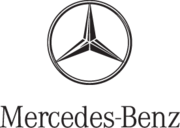 |
|
| Тип |
Подразделение Daimler AG |
|---|---|
| Год основания |
1886[источник не указан 274 дня] |
| Основатели |
Карл Бенц |
| Расположение |
|
| Ключевые фигуры |
Дитер Цетше (председатель совета директоров) |
| Отрасль |
Автомобильная промышленность |
| Продукция |
Легковые автомобили, грузовики, автобусы, двигатели |
| Материнская компания |
Daimler AG |
| Сайт |
mercedes-benz.de |
Mercedes-Benz (Мерседе́с-Бенц; немецкое произношение mɛʁˈtseːdəs ˈbɛnts) — немецкий автоконцерн, специализирующийся на выпуске легковых автомобилей премиум-класса, грузовых автомобилей, автобусов и других транспортных средств. На данный момент является дочерней компанией концерна «Даймлер АГ». Штаб-квартира находится в Штутгарте. Образована в 1871 году [источник не указан 274 дня]. В 2010 году бренд оценивался в 25,2 млрд долларов, удерживая второе место по цене компаний-производителей автомобилей[1].
Содержание
- 1 История Mercedes
- 1.1 Benz
- 1.2 Daimler
- 1.3 Объединение конкурентов
- 1.4 Mercedes-Benz в период Второй мировой войны
- 1.5 Новое начало
- 1.6 «Аденауэры»
- 1.7 Понтоны
- 1.8 SL (Sport Leicht)
- 1.9 Плавники
- 1.10 Новая эпоха
- 1.11 1970-е годы
- 1.12 1980-е
- 1.13 1990-е
- 1.14 2000-e
- 2 Рождение автомобиля
- 3 Модельный ряд
- 3.1 Легковые автомобили
- 3.1.1 Значимые автомобили
- 3.1.2 Концепт-кары
- 3.2 Автобусы
- 3.3 Фургоны
- 3.4 Грузовики
- 3.1 Легковые автомобили
- 4 Тюнинг
- 5 Mercedes-Benz Center
- 6 Журнал Mercedes
- 6.1 Mercedes-Benz Magazin
- 6.2 Mercedes-Benz Classic
- 6.3 Mercedes-Benz Transport
- 7 Mercedes-Benz TV
- 8 В сувенирной и игровой продукции
- 9 Аксессуары Mercedes-Benz
- 10 Интересные факты
- 11 См. также
- 12 Примечания
- 13 Ссылки
История Mercedes
История этой марки слагается из историй двух известных автомобильных марок — «Мерседес», выпускавшихся немецкой компанией «Даймлер-Моторен-Гезелльшафт» и «Бенц», которые строились одноименной фирмой. Обе компании вполне благополучно развивались самостоятельно, a в 1926 году слились в новый концерн «Даймлер-Бенц».
Benz
В 1886 году была создана трёхколесная самоходная повозка с бензиновым двигателем. В этом же году её создатель — Карл Бенц получил патент на это изобретение. Первый в мире трёхколесный автомобиль был запущен в серийное производство.
Через семь лет, уступив Даймлеру первенство, Карл Бенц создает свой четырёхколесный автомобиль, а в следующем году ещё более совершенная конструкция под странным названием «Велосипед» идёт в серию.
В 1901 году, вскоре после выпуска Даймлером новой модели «Мерседес-35PS» становится понятным, насколько «Бенц» отстает от прогресса. Чтобы наверстать упущенное, акционеры приглашают в компанию французского инженера Мариуса Барбару. Из-за технических разногласий Карл Бенц покидает основанную им же компанию. Вскоре стало видно, — француз не оправдал возложенных надежд. Следуя логике, что немецкие автомобили должны делаться немецкими руками, в фирму, на должность главного инженера, был приглашен Фриц Эрле. Снова не повезло. И только с приходом в компанию талантливого инженера Ганса Нибеля дела постепенно пошли в гору. В 1909 году, создав целый ряд прекрасных легковых автомобилей фирма построила самый известный гоночный автомобиль того времени «Блитцен Бенц» с мотором мощностью 200 л. с. и объёмом 21594 см3.
В послевоенные годы было создано множество новых моделей, большинство из которых с успехом выпускались до середины двадцатых годов. Всего, с момента начала производства в 1886 году и до объединения с «Даймлер-Моторен-Гезелльшафт» в 1926 г., фирма «Бенц» произвела 47555 автомобилей, включая легковые автомобили, грузовики и омнибусы.
Daimler
В 1890 году Готлиб Даймлер, в городке Бад Каннштат недалеко от Штутгарта, основал компанию своего имени — «Даймлер-Моторен-Гезелльшафт», решив выпускать, созданный четырьмя годами ранее им самим и, принимавшим активное участие, Вильгельмом Майбахом четырёхколесный автомобиль. После ряда не очень удачных попыток, которые всё же нашли своих восторженных покупателей, конструктору В. Майбаху в 1901 году удалось создать успешный образец. По настоянию консула Австро-Венгерской империи в Ницце и, по совместительству, главы представительства «Даймлер» во Франции Эмиля Еллинека автомобиль был назван в честь Maria de las Mercedes, Девы Марии Милосердной (от латинского «merces», «дары»), так же в честь которой были названы все его дети, в числе которых была небезызвестная дочь консула Мерседес, и имущество (яхты, дома, отель и казино).
Первый «Мерседес-35PS», а именно так он назывался, обладал четырёхцилиндровым мотором рабочим объёмом 5913 см3, классическим расположением основных агрегатов и красивой (по тем временам) внешностью. Через год свет увидел более совершенную конструкцию под названием «Мерседес-Симплекс». Расширился модельный ряд. Самые известные представители этой серии носили гордые имена «Мерседес-40/45PS» и «Мерседес-65PS» и двигатели объёмом 6785 см3 и, соответственно, 9235 см3, позволявшие развивать скорость до 90 км/ч.
До Первой мировой войны «Даймлер-Моторен-Гезелльшафт» успела выпустить широкий модельный ряд своих автомобилей с разными двигателями (от 1568 см3 до 9575 см3), рассчитанный на разных потребителей, включая роскошные, практически бесшумные автомобили, используя двигатели с бесклапанным газораспределением, произведённые по патенту американской компании «Найт».
Сразу после войны Пауль Даймлер начинает проводить эксперименты с компрессором, позволяющим в полтора раза повысить мощность двигателя. Пришедший на должность главного инженера в 1923 году Фердинанд Порше довёл эксперименты до логического завершения, создав в 1924 году один из самых выдающихся автомобилей мира — «Мерседес-24/100/140PS» с великолепным шасси и шестицилиндровым компрессорным мотором объёмом 6240 см3 и мощностью 100—140 л. с.
К 1926 году «Даймлер-Моторен-Гезелльшафт» произвела на всех своих заводах в общей сложности 147961 автомобиль, причём максимальная производительность была достигнута в 1918 году. Несмотря на все трудности этого последнего военного года, тогда удалось произвести 24690 автомобилей.
Объединение конкурентов
Трёхлучевая звезда Мерседес-Бенц на крышке радиатора
После слияния в 1926 году фирм Daimler и Benz новый концерн Daimler-Benz смог эффективно использовать опыт и знания конструкторов обеих компаний, во главе которых встал Фердинанд Порше. Он полностью обновил производственную программу, взяв за основу последние модели Daimler, выпускавшиеся теперь под маркой Mercedes-Benz. Первой новой разработкой Порше в 1926 году стала «компрессорная» серия К, включавшая модель 24/110/160 PS с 6-цилиндровым мотором объёмом 6240 см3. За большую мощность и скорость (до 145 км/ч) её прозвали «смертельной ловушкой», Она стала базовой для более известной серии S, состоявшей из моделей S.
В 1928 году Порше покинул Daimler-Benz, и его место занял Ганс Нибель (Hans Nibel). Под его руководством выпустили легковые Mannheim-370 («Маннхайм-370») с 6-цилиндровым мотором рабочим объёмом 3,7 л и Nurburg-500 («Нюрбург-500») с 8-цилиндровым 4,9-литровым агрегатом, базировавшиеся на последних моделях Порше.
В 1930 году появился Großer Mercedes (рус. Большой Мерседес) или Mercedes-Benz 770 с 8-цилиндровым 200-сильным мотором объёмом 7655 см3 с нагнетателем, В 1931 году фирма дебютировала в секторе малолитражных автомобилей, где её представлял весьма удачный Mercedes 170 с 6-цилиндровым мотором 1692 см3, с независимой подвеской передних колёс.
В 1933 году появились легковой Mercedes-Benz 200 и спортивный Mercedes-Benz 380 с 2,0- и 3,8-литровыми моторами, последний из них развивал 140 л.с. с нагнетателем. На базе спортивной модели в 1934 году создали Mercedes-Benz 500K с 5-литровым двигателем, ставший через 2 года основой для более известного большого «компрессорного» автомобиля Mercedes-Benz 540K. В 1934—1936 годах фирма выпустила лёгкий Mercedes-Benz 130 с 4-цилиндровым 26-сильным двигателем заднего расположения рабочим объёмом всего 1308 см3, за которым последовали родстер 150 и седан 170H.
Под техническим руководством главного конструктора Макса Зайлера (Max Sailer), сменившего Нибеля в 1935 году, были созданы популярная недорогая модель 170V с 4-цилиндровым мотором объёмом 1697 см³, первый в мире серийный легковой автомобиль с дизельным двигателем 260D (1936 год), а также новый «Большой» Mercedes-Benz 770 (1938 год) с рамой из балок овального сечения и задней пружинной подвеской, служивший нацистским лидерам.
Mercedes-Benz в период Второй мировой войны
Во время войны Daimler-Benz выпускала как грузовики, так и легковые автомобили разных классов. Однако, двухнедельная воздушная бомбардировка англо-американскими ВВС в сентябре 1944-го года превратили Daimler-Benz Aktiengesellschaft в груду руин. Разрушение крупного концерна оценивались по-разному, главный цех в Штутгарте был разрушен на 70 %, двигательный и кузовный цеха в Зинделфингене — 85 %, цех грузовиков в Гаггенау был полностью уничтожен. Бывшей фабрике Benz und Cie в Маннгейме повезло больше всех — всего 20 % разрушения, а завод дизельных двигателей Berlin-Marienfeld, купленный Daimler’ом в 1902, полностью сравнен с землёй. Когда оценки разрушения были готовы к январю 1945-го года, совет директоров постановил, что Daimler-Benz физически больше не существует[2]
Новое начало
На послевоенное восстановление разрушенных заводов потребовалось время, поэтому автомобильное производство было начато только в июне 1946 года. Для разработки новых автомобилей не было ни технической базы, ни средств, поэтому первым послевоенным автомобилем стал седан W136 — «170V». Хотя конструкция была разработана еще в середине 1930-х годов, малолитражный автомобиль с мотором всего 38 лошадиных сил стал началом новой истории марки. Уже с мая 1949-го года была проведена крупная модернизация. Двигатель был увеличен на 70 см³, (до 52 л.с.; модель «170S»), появились варианты в кузовах кабриолет и универсал (т. н. кабриолеты «А» и «B») и главное — модели с дизельными двигателями «170D».
К началу 1950-х Daimler имел крупные амбиции будущих автомобилей, однако запуск нового поколения автомобилей требовал дальнейшего развития производственной базы. Поэтому в начале 1950-х, несмотря на появление новой роскошной серии «300» (см. ниже), продолжался выпуск моделей с морально устаревшей конструкцией. Продолжалась постоянная модернизация и запуск новых моделей. Так в январе 1952-го года появилась модель с увеличенным кузовом которая получила номер W191. Но еще до этого в марте 1951-го, на машину поставили вместо 4-х цилиндрового, шестицилиндровый двигатель с мощностью 80 л.с. Вместе с новым внешним дизайном (например, расположение передних фонарей в крылья) автомобиль W187 получил новое имя «220» и занял средний сегмент между «170»-ми и «300»-ми. Он предлагался в трёх кузовах (седан и кабриолеты «А» и «B»).
Всего за девять лет (выпуск завершился в сентябре 1955-го) было построено соответственно 151042 и 18514 автомобилей «170» и «220». Благодаря этим автомобилям, Mercedes-Benz смог создать прочный фундамент, на котором компания станет ведущим автомобильным производителем в Западной Европе.
|
|
|
|
||
| W136 (1936—1939) | W191 (1949—1955) | W136 (1946—1953) |
«Аденауэры»
Флагманские автомобили W186 (слева) и его преемник W189 (справа) собирались вручную c 1951-го по 1961-й. Устаревшая конструкция не помешала вернуть марке её довоенное величие.
После успешного восстановления заводов и производства своих малолитражных автомобилей, к концу 1940-х Mercedes-Benz вновь приступил к восстановлению своего довоенного бренда как производитель роскошных автомобилей. Учитывая современные прорывы в моде автомобилестроения, в ноябре 1951-го года на Парижском автосалоне появился новый представительский лимузин W186 «300». Автомобиль, хоть и был построен в классической компоновке (отдельная рама и кузов), оснащался мощным 6-цилиндровым мотором в 2996 см³ с верхним распределительным валом.
Машина производилась в двух кузовах — седан и четырёхдверный кабриолет «D» и имела огромный успех среди крупных бизнесменов, знаменитостей и политиков. Именно последняя категория и дала автомобилю неофициальное название в честь первого федерального канцлера ФРГ, Конрада Аденауэра, который имел личный автомобиль и высоко его оценил. Так как сборка автомобиля проводилась вручную, интерьеры делались под покупателей и оснащались радио, телефоном и многими другими новшествами.
Ручная сборка автомобилей позволяла проводить непрерывные модернизации, в итоге в конце 1954-го появилась серия W186 «300b», которая получила новые тормозные барабаны и передние форточки. Год спустя её заменила «300с», оснащённая автоматической коробкой передач фирмы Borg-Warner. Но самый большой шаг вперёд был сделан в середине 1950-х, когда фирмой Bosch было сделано изобретение системы впрыска топлива. Ей была оснащена серия W188 «300Sc» c конца 1955-го года.
В январе 1952-го года появилась ещё одна серия представительского класса W188 — «300S», которая выпускалась как купе, кабриолет «А» и двухместный родстер. При помощи трёх карбюраторов Solex степень сжатия двигателя была увеличена до 7,8:1, и 150 л.с. разгоняли более лёгкие автомобили до 180 км/ч. Если сборка больших «аденауэров» шла относительно быстро (около тысячи в год, учитывая совокупные возможности заводов марки), то средний выпуск автомобилей «300S» был не более ста штук в год.
Однако, если спрос на крупные «аденауэры» продолжался, то выпуск малосерийных «300S» стал непрактичным после появления родстеров SL и аналогичных двухдверных понтонных моделей в середине 1950-х (см. ниже). Дальнейшая сборка морально устаревших автомобилей оказалась для фирмы большим бременем, поэтому в 1958-м году выпуск всех трёх кузовов W188 был прекращён после всего лишь 760 автомобилей.
Что же касается флагманских седанов и кабриолетов «D», то в августе 1957-го года была проведена основательная модернизация автомобиля, который стал именоваться как W189 — «300d». Главное внешнее отличие было в хвостовой части кузова, которая приобрела форму понтонного седана (см. ниже). Аналогично изменила форму и задняя часть крыши с увеличенным хвостовым стеклом. Боковое остекление также получило очень удобную для летнего времени возможность убрать центральную стойку. Чтобы успешно проникнуть на рынок США, автомобили могли оснащаться кондиционерами и гидро-усилителями руля, а их шины были покрашены в белый цвет. Под капотом нового «аденауэра» теперь стояла система впрыска топлива, и мотор мог выработать 180 л. с. и разогнать тяжёлый автомобиль до 165 км/ч.
Сборка «аденауэров» продолжалась до марта 1962-го года, всего было построено 8288 W186-х и 3142 W189. Благодаря этой серии Mercedes-Benz полностью восстановил свою довоенную репутацию как производитель роскошных автомобилей.
|
|
|
|
|
|
||||
| Кабриолет D W186 «300» | Купе W188 «300S» | Родстер W188 «300S» | Кабриолет А W188 «300Sс» | Седан W189 «300d» |
Понтоны
В начале 1950-х гг. у Mercedes-Benz наконец появились ресурсы и персонал, чтобы реализовать свои амбиции. Как уже отмечалось, модели «170» и «200», к началу 1950-х уже полностью устарели, а «300»-е могли себе позволить лишь элита того времени. Марке требовалась унифицированная серия автомобилей, которая была бы современная, надёжная, но при этом относительно не дорогая и простая в обслуживании.
Выход был очевиден — кузов типа монокок, но тут Mercedes-Benz сохранил классические линии колёсных арок и тем самом ввёл в автомобильную терминологию дизайн понтонного кузова. Таким был новый автомобиль W120 «180», впервые показанный в июле 1953 г. Выпуск продолжался вплоть до начала 1960-х гг. и было разработано множество моделей и модернизаций. Так, в феврале 1954 г. появился дизельный вариант «180D», а в марте 1956 г. более мощный и комфортабельный W121 «190», к которому также появилась дизельная модификация «190D» в августе 1958 г. Но самая значимой моделью был спортивный родстер «190SL», построенный на общем кузове с W121, несмотря на существенные внешние отличия. (см. описание ниже)
Первые шестицилиндровые, т. н. «крупные понтоны» появились в июне 1954 г., с моделью W180 «220a» с двигателем мощностью в 89 л. с. Как и свои младшие братья, автомобили перенесли целый ряд модификаций, с марта 1956 г. появилась аналогичная «190»-му флагманская серия «220S», которая выпускалась помимо седана, в кузовах двухдверного купе и кабриолета с мощностью двигателя в 105 л. с. Старые же «220а», теперь стали именоваться как «219» под новым номером кузова W105. Последним штрихом в истории крупных понтонов произошла в октябре 1958 г., когда появились модели с системой впрыска топлива «220SE» (Е — Einspritzmotor) для седанов, купе и кабриолетов, которые теперь стали именоваться как W128.
Выпуск крупных понтонов 220-й серии продолжался до сентября 1959 г. (седаны) и ноября 1960 г. (купе и кабриолеты). Всего было построено, соответственно, 111035 и 5371 таких автомобилей. Младшие понтоны выпускались дольше, до октября 1962 г. Всего было построено 442963 седанов W120 и W121, а также 25881 родстеров «190SL». Итого, 585250 автомобилей, масштаб, который позволил прославить марку на весь мир, так как только официально их было экспортировано в 136 стран. За время выпуска создалась прочная база для производства будущих моделей, уже в 1960 г. по анализу Daimlera сборка одного автомобиля в Зиндельфингене занимала всего 25 часов. Но автомобильный мир в конце 1950 — начале 1960-х гг. переживал бурные изменения, и чтобы сохранять конкурентоспособность в неравным бою с американскими производителями, требовались новые поколения автомобилей.
|
|
|
|
|
|
||||
| 180 W180 (1953—1961) | 190 W190 (1956—1961) | 219 W105 (1956—1959) | 220S W180 (1953—1959) | 220SE W128 (1958—1961) |
SL (Sport Leicht)
Одновременно с производством легковых автомобилей, Mercedes-Benz уделял немало внимания восстановлению своей гоночной репутации. Целое бюро Daimler’a занималось созданием легких аэродинамических кузовов. Особым успехом стал автомобиль W196 на котором Аргентинский гонщик Хуан-Мануэль Фанхио выиграл сезоны 1954 и 1955-х годов. (см. команду Мерседес в формуле 1). Сам автомобиль был построен на опыте бывших конструкторов авиадвигателей истребителя Messerschmitt Bf.109 и имел систему впрыска топлива и десмодромный привод клапанов.
В 1955-м году улучшенная версия W196S т. н. «300SLR» под номером 722, установила не побитый по сей день рекорд Милле Милья, за рулём которого сидел знаменитый английский гонщик Стирлинг Мосс. Несмотря на трагический исход в чемпионате 24 часа Ле-Мана где погиб гонщик Пьер Левег и 82 зрителя, Mercedes-Benz успешно выиграл кубок чемпионата мира в 1955-м году. Однако, после этого марка ушла из гоночного мира, на многие годы.
Но успех не мог не оставить наследие автомобилям марки. Еще в 1952-м году появилась гонка W194 «300SL», предшественница SLR-а, хотя она смогла окончить вторым и четвертым в чемпионате Милле Милья этого же года, а также участвовала в Каррера Панамерикана и Targa Florio. Кузов состоял из трубчатой рамы покрытой легким запатентованном сплавом алюминиево-магнезия «электрон» и имел облегчённый и переделанный под гоночные нужды вариант шестицилиндрового двигателя от аденаэуера. Но самый интересный элемент конструкции заключалась в форме кабины и дверей, для прочности и сохранения веса, они открывались вверх которые дали автомобилю прозвище «крыло чайки».
В 1953-м году бизнесмен Макс Гоффман, предложил Mercedes-Benz’у создать дорожную версию «300SL» для развивающегося американского рынка. Результатом стал W198 «300SL». С момента его премьеры в 1954-м году, его футуристические черты, и конечно необычные двери гарантировали полный успех. Элита США, куда поставлялись более 80 % всех автомобилей, раскупала их на аукционах. Изначально на автомобилях стояла система трёх карбюраторов типа Weber давший мощность 115 л.с. Однако вскоре, на ней была поставлена системы впрыска топлива фирмы Bosch, что повысило мощность до 215 л.с. (158 кВт) при 5800 об/мин. Это позволило разогнать легкий автомобиль до 250 км/ч.
Успех автомобиля «300SL» шокировал саму фирму. Однако, при всех его плюсах, его сложная конструкция, и долгая сборка сделало его почти недоступной по цене для рынка старого света. Но чувствуя потенциал открывшегося для марки рынка, инженеры Mercedes-Benz’a сразу принялись разрабатывать массовую модель для домашнего рынка, на базе стандартного понтона W121 «190». При этом автомобиль сохранил много деталей от 300SL, как независимую переднюю подвеску и с качающимися полуосями заднюю. В апреле 1954-го года состоялась премьера младшего брата «190SL». Автомобиль выпускался как родстер, либо со съемной жесткой крышей либо с складывающейся брезентовой. Цена на него была почти в половину от «300SL». Тем не менее, автомобиль оказался очень успешным, особенно среди покупателей — женщин.
В 1957-м году «300SL» подвергся крупной модернизации, в ходе которой он лишился своей уникальной конструкции дверей-крыши, в пользу классической схемы родстера. Причин этому было несколько, во-первых автомобиль был создан как гонка нежели как класс Гран-Туризмо в которой он неожиданно превратился. Следовательно, в плане удобства имел большие недостатки как отсутствие багажника, вентиляции (только задние треугольные форточки могли приоткрыться) и конечно же вход и выход пассажира в кабину, который, особенно женщинам, был очень неудобен. Если учитывая, что самые богатые в США жили в жарких климатических штатах как Флорида и Калифорния, то данные недостатки противоречили образу марки которая делала престижные автомобили. Вторая причина стала высокая смертность в авариях вследствие трудности для пассажира выбраться из автомобиля, особенно при перевороте. Поэтому в 1957-м году новый «300SL» превратился в родстер, который аналогично «190SL» выпускался как с брезентовой так и со съемной жесткой крышей. При этом, автомобиль получил новую, мягкую заднюю подвеску, дисковые тормоза (с 1961-го года) и впервые Mercedes-Benz на него поставил новый тип вертикальных фар, который впоследствии станет характерной чертой всех последующих моделей марки вплоть до начала 1970-х годов.
В 1963-м году завершился выпуск обоих автомобилей. Всего было выпущено 1400 автомобилей «300SL» первого поколения и 1858 второго. Понтонных «190SL» было построено 25,881. Оба автомобиля открыли для марки совершенно новый класс машин, которые отныне имели окончания SL — Sport Leicht спортивно-легкий в переводе.
|
|
|
|
||
| 300SL W198 (1954—1957) | 190SL R121 (1955—1963) | 300SL W198 (1957—1963) |
Плавники
В 1950-х годах Западная Европа выходила из разрухи и бедности — последствий Второй мировой войны. Еще в сентябре 1956 года, когда Понтоны только ещё начали выпускаться, руководство Daimler-Benz занялось разработкой нового поколения автомобилей. Главные требования были выше, чем когда-либо: безопасность и удобство пассажиров внутри, снаружи машина должна была иметь форму автомобилей итальянского стиля, переднюю же часть унаследовать от Mercedes-Benz’a. Разработка началась в 1957 году, в период, когда бесспорным лидером автомобильной промышленности была Америка. Американский внешний дизайн автомобиля переживал революцию, которая была вызвана эпохой реактивного воздушного и космического полета (отсюда характерные «крылья», которые украшали заднюю часть кузова). В последний момент ведущий инженер-дизайнер добавил эту деталь в новую конструкцию. Хотя сами крылья были намного меньше и скромнее чем их американские собратья, их форма дала характерное прозвище всему поколению автомобилей «Heckflosse» — «плавники».
В конце 1950-х начале 1960-х американская мода автомобильного дизайна диктовала свои стили «крыльев», и Mercedes-Benz W112 «300SE» не остался исключением, но более консервативный немецкий подход превратил их в небольшие, элегантные «плавники», которыми неофициально и назывались автомобили целого поколения
Производство началось в начале 1959 года. Осенью на Франкфуртском автосалоне автомобиль W111 был показан публике. Несмотря на то, что шасси было одинаковое с понтонами, внешне «плавник» выглядел совершенно иначе, имея элегантный кузов, вертикальный блок фар, и конечно же, сами плавники. Помимо этого, Mercedes-Benz опередил весь мир, запатентовав передние и задние зоны деформации, которые поглощают кинетическую энергию столкновения, и ремни безопасности. Внутри салон был намного просторнее, и при этом вся панель приборов и даже руль были обшиты мягким материалом. Площадь остекления выросла на 35 %, тем самом улучшив обзор водителю и пассажирам. Комфортабельность также улучшила независимая задняя подвеска.
W111 заменил седаны W128 и W180, с моделями «220b», «220Sb» и «220SEb» (b — никогда внешне не упоминалась, но была введена чтобы не спутать с ранними моделями). Модели отличались, помимо разных мощностей двигателя (от 95 до 120 л.с.), своей компоновкой, и «220SE» считалась неким флагманом линейки. Выпуск продолжался до лета 1965 года, когда появился преемник W108 (см. ниже). Однако за счет своей популярности выпуск модели «220S» продолжился, автомобиль получил более широкий диаметр цилиндра (увеличив мощность на 20 л.с.) и пневматическую, самовыравнивающуюся заднюю ось. Из-за более крупного объема двигателя автомобиль был переименован как «230S», и его выпуск продолжался до января 1968 года. Всего было выпущено 337.803 автомобилей такого типа.
Вслед за W111 началась разработка замены остальным понтонным автомобилям, и главным двухдверные купе и кабриолеты. При разработке внешнего вида Mercedes-Benz попробовал придать автомобилю более спортивный характер с аналогичным передним и задним оформлением от будущего SL «Пагода» (см. ниже), однако лишь задняя часть оформления дошла до купе и кабриолета, за счет чего, их «плавники» лишились хромированного подчеркивания. В марте 1961 года бесстоечные двухдверные автомобили «220SEb» произвели фурор на Женевском автосалоне.
Одновременно с работой по замене понтонных двухдверных 220-х на плавниковые, шли работы по созданию массовой бюджетной версии плавников, которая бы заменила четырёхцилиндровые седаны W120 и W121. Летом 1961 года появился автомобиль W110 в двух моделях: «190c» и «190Dc». Как и прежде, автомобили были почти одинаковы с W111, но имели более скромное передние оформление (на 14,5 см короче). Но автомобиль был более экономичен, особенно дизельная «190D», которая стала любимой многих таксистов. На базе W110-го строились универсалы, кареты скорой помощи и т.д. Интересно заметить, что за счет одинаковой конструкции с W111, во множестве модернизаций за время выпуска, Mercedes-Benz ставил более дорогие агрегаты флагманского седана на W110, например регулировку спинок кресел, вентиляцию, внешний хромированный декор, но главное двигатели. В 1965 году, при запуске нового поколения двигателей, «190»-е превратились в «220» и «220D». Но главным стала модель «230», которая возникла путем поставки шестицилиндрового двигателя от W111 «230S» в кузов W110. В январе 1968 года Mercedes-Benz прекратил её производство, выпустив к тому времени 628.282 автомобиля.
Последний штрих истории плавников был сделан в том же 1961 году. Как отмечалось выше, Mercedes-Benz завершил выпуск не только понтонов, но и высшую лигу автомобилей ручной сборки W189 «Аденауэр» «300». Работа над заменой лимузина высшего класса только началась, а завершение выпуска устаревшего рамного лимузина образовало нишу в модельном ряду. Mercedes-Benz решил проблему простейшим способом, поставив крупный трёхлитровый двигатель в обычный седан W111. Результатом стал автомобиль с намного улучшенными динамическими характеристиками. Добавив пневматическую подвеску, автоматическую коробку передач, роскошный интерьер и удвоив количество хромированной внешней обшивки, Mercedes воссоздал роскошь лимузина в обычном седане. Однако, зная, что многие из высших эшелонов покупателей могут не принять данную «халтурность», Mercedes-Benz решил дальше оторвать флагманскую модель «300SE» от основной линейки, и даже выделил отдельный заводский индекс W112. А в 1963 году появилась модель с удлинённой колесной базой «300SEL». Как и ожидалось, не все положительно отреагировали на замену автомобиля ручной сборки массовым автомобилем в комплектации люкс. Тем не менее, за короткий период его выпуска (по 1965 год) было выпущено 5.202 «300SE» и 1.546 «300SEL». Разбив табу преемственности, в марте 1962 года Mercedes-Benz пошёл на следующий логический шаг и поставил тот же мотор на двухдверные плавники. Такой W112 «300SE» отличался от W111 «220SE» по аналогичным признакам седанов (больше внешнего хрома, обшивка панели приборов из корня орехового дерева и т. д.). Всего по 1968 год было выпущено 3.12
|
|
|
|
|
|
||||
| 220 W111 (1959—1968) | 250SE W111 (1961—1971) | 300SE W112 (1961—1965) | 300SE W112 (1961—1967) | 190 W110 (1961—1968) |
К началу 1960-х мода на плавники уже успела уйти из автомобильного дизайна, но обновление автомобильного парка продолжалась, и летом 1963 года настал черед замены спортивной серии SL. До конца 1962 года продолжался одновременно массовый выпуск четырёхцилиндровых родстеров W121 «190SL» и ручная сборка роскошных автомобилей гран туризмо W198 «300SL». Аналогично тому, как W111 и W112 объединили разные седаны 220-й и 300-й серий, новый автомобиль W113 объединил оба класса SL. Разработка автомобиля шла по тому же пути, глубокая модернизация понтонного кузова. Но при этом на ней уже стоял не четырёх-, а шестицилиндровый двигатель. Имея простой компактный кузов, независимую подвеску и конечно же, возможность снять либо твердую, либо брезентовую крышу, новый родстер «230SL» быстро стал популярной машиной, особенно среди женщин. Именно необычная форма крыши и дала ему прозвище «Пагода» во время его премьеры. Впоследствии автомобиль дважды модернизировался задними дисковыми тормозами и более мощными двигателями «250SL» (1967) и «280SL» (1968—71). Всего было выпущено 48.912 таких автомобилей
Следующий 1964 год наконец решил проблему с заменой Аденауэров. Как уже отмечалось, автомобиль W112 «300SE», хоть и был оснащен на порядок лучше, чем стандартные плавники, он все-таки оставался массовым автомобилем, и был временным решением для замены W189. Настоящий преемник Аденауэра, лимузин W100 был почти 5,5 метра в длину, имел пневматическую подвеску, квадратный кузов и внутри мог быть оснащен любыми деталями комфорта, вплоть до телевизора. Но главным стал его двигатель: старый трёхлитровый уже не годился для автомобиля массой в три тонны, да и после серии W112 он уже успел опуститься из эксклюзивности в массы, и Mercedes-Benz вернул в свой ряд первый V-образный восьмицилиндровый двигатель. Мотор M100 объемом 6,3 литра, имея 250 л.с., мог разогнать огромный автомобиль до 205 км/ч, тем самом сделав его вторым быстрым автомобилем ФРГ (после Порше 911). Модель «600» могла выпускаться, помимо стандартного лимузина, в комплектации удлинённого (на 74 см) «Пульман» или как полукабриолета «Ландоле», которые закупались главами стран для парадных целей, а также Ватиканом как Папамобиль. В целом автомобиль стал настолько успешным, что его сборка продолжалась до 1981 года (было выпущено 2.677 автомобилей).
Новая эпоха
600-й завершил обновление всего модельного ряда. Годы выпуска этих автомобилей как раз совпали с расцветом ФРГ как новой экономической силой Западной Европы, что говорит и о масштабах производства и о экспортном успехе автомобилей. К середине 1960-х Mercedes-Benz твердо стоял как лидер немецкого автопрома. Разумеется, плавниковая эпоха не завершилась с запуском 600-го, но их возможность унифицировать модельный ряд позволил сэкономить огромное количество материальных и людских ресурсов.
Понтонами и SL Mercedes сумел за 10 лет вынести себя из довоенного 170-го в производителя лучших европейских автомобилей, модели экспортировались во многие страны мира и закупались как знаменитостями, так и политиками. Но к концу 1950-х образ современных автомобилей как и западного общества резко менялся и Mercedes стал авангардом этой эпохе. В 1959-м году пошло новое семейство представительского класса W111 получивших элегантные несущие кузова с вертикальными блоками фар, огромный багажный отсек и независимую подвеску всех колёс (модели 220, 220S, 220SE, 230S, 250SE, 280SE и 280SE 3.5). Они продемонстрировали высочайший технический уровень автомобилей этой марки. Главным символом новой эпохе квадратный кузов но с четким американским влиянием ввиду «плавников» на задних крыльях, у автомобиля также имелись версия купе и кабриолет. Мода на плавники также перешли на автомобили среднего класса W110 в 1961-м году. В 1961-м году Mercedes выпускает роскошную версию, основанную на 111-м 300SE W112, также имевшую версии купе и кабриолета.
Но мода на плавники ушла так же быстро, как и пришла, а Mercedes продолжал вводить новые и более роскошные модели. В 1963 году появились две новые модели. Первой стала SL «Пагода» с уникальной крышей (её средняя часть была ниже боковин). Автомобиль выпускался в трёх сериях: 230SL, 250SL и 280SL. А в конце 1963-го появился лимузин Mercedes-Benz W100 600. Автомобиль имел 6,3-литровый двигатель V8 мощностью 250 л.с., автоматическую 4-ступенчатую коробку передач, и воздушную подвеску колёс. Главное, что у автомобиля почти не было конкурентов, и не только в престиже, но, несмотря на огромные размеры, он мог развивать максимальную скорость до 205 км/ч. Выпускались также удлиненные версии Pullman (включая шестидверные варианты) и полукабриолеты — ландоле.
|
|
|
|
|
|||
| W113 (1963—1971) | W100 (1963—1981) | W108 (1965—1972) | W109 (1965—1972) |
На Франкфуртском автосалоне 1965 года была впервые показана гамма моделей так называемого S-класса (W108) — самых престижных (после лимузина 600) автомобилей фирмы. В него вошли модели 250S и 250SE с 6-цилиндровыми моторами в 150 и 170 л.с., по своим техническим параметрам превосходящие конкурентов. Со временем они получили моторы в 2,8 л, а с 1968 года: 3,5- и 4,5-литровые двигатели V8. Самой мощной и комфортабельной моделью этой серии стала удлинённая W109 300SEL, включая флагман 300SEL 6.3 с 6,3-литровым двигателем от 600-го, развивавшая максимальную скорость 220 км/ч. С этого момента серия S стала символом технических достижений компании Mercedes-Benz.
В 1968-м году появились новые модели среднего класса W114 и W115, отличавшиеся набором двигателей. На последних (230, 250 и 280) стояли шестицилиндровые моторы, на первых (200, 220 и 240) четырёхцилиндровые. Широкую популярность также получили дизельные комплектации этих моделей. Автомобиль выпускался в версии купе, универсала и удлиненного седана. Особенностью серии был тот факт, что её кузов был полностью разработан «с нуля», в отличие от предыдущих, которые в той или иной форме были позаимствованы у прежних моделей.
|
|
|
|
|
|
||||
| W114 (1968—1975) | W115 (1968—1975) | C115 (1968—1972) | V114 (1968—1975) | S114 (1968—1975) |
1970-е годы
Если марка смогла к концу 1950-х годов занять нишу в послевоенной Европе, то к концу 1960-х о ней знал весь мир, как и масштаб производства так и качество автомобилей. В начале 1970-х Mercedes принял новую систему классификации автомобилей где приставку W пополнили R (родстер), С (купе), S (универсал) и V (длинная база). Также появился новый стандарт стайлинга который стал более мужским и харизматическим давший новым автомобилям более элегантный, но тем не менее строгий и спортивный очерк.
Первой новинкой десятилетия был новый SL R107 который в 1971-м году сменил Пагоду. Успех автомобиля можно охарактеризовать тем, что он выпускался 18 лет (вплоть до 1989-го года). Хотя и были начинающие модели с шестицилиндровыми двигателями (, 280SL и 300SL) но по всем критериям R107 был восьмеркой (V8), которая успешно завоевала американский рынок моделями 350SL, 380SL, 420SL, 450SL, 500SL и 560SL. Последняя модель вообще не была доступна для Европы.
В 1972-м году на смену 108-му пришло новое поколения S-класса W116, автомобиль имел первую в мире систему ABS а также гидропневматическую подвеску, как и трёхступенчатую АККП. Как и его предшественник, он имел две базы, короткую и длинную (V116). Модельный ряд также в основном состоял из «восьмерок» 350SE/SEL и 450SE/SEL. Но помимо «шестерки» 280S и 280SE/SEL, была также и дизельная модель 300SD с короткой базой (для североамериканского рынка), а флагманом стал 450SEL 6.9 с огромным 6,9 литровым двигателем V8.
Если у всех S-классов были купе, то W116 был исключением, и для замены уже устаревшего С111 в 1972-м году пришла новая модель C107 SLC которая была разработана на базе R107. В отличие от родстера у купе была твердая крыша и увеличенный салон для заднего сиденья.
|
|
|
|
|
|||
| R107 SL (1971—1989) | C107 SLC (1972—1981) | W116 SE (1972—1980) | V116 450SEL 6.9 (1972—1980) |
1973-й год для фирмы стал самым суровым испытанием, начавшийся нефтяной кризис серьёзно снизил продажу автомобилей, особенно с крупными двигателями. Но благодаря серии W114/W115 и особенно усилиям, которые Mercedes приложил в рамках качества и в разработках более экономичных двигателей, уже к середине 1970-х когда многие конкуренты разорились, а Мерседес устоял и в 1975-м году был готов внедрить замену для массового автомобиля W114/W115.
Новая машина W123, оказалась одна из самых надежных всей марки. Выпускалась также версия универсала (с 1976-го года), купе и лимузина (с 1977-го). Главной славой автомобиля была её простота и экономичность, благодаря чему даже по сей день, можно нередко увидеть в многих странах третьего мира мятые но рабочие 123-е Мерседесы.
С 1978-го на Мерседес, первым в мире стал штатно устанавливать антиблокировочную систему. Первой машиной, в базовую комплектацию которой вошло ABS, стал W116[3].
|
|
|
|
|
|||
| W123 (1975—1985) | S123 (1976—1985) | C123 (1977—1985) | V123 (1977—1985) |
1980-е
Если Mercedes-Benz был лидером европейского рынка в 1970-ые, то в 1980-е годы этой уверенности не было. Отчасти события 1973-го года изменили облик среднего покупателя, который уже желал от автомобиля не только роскоши и комфорта, но и надежности и экономичности. Поэтому, несмотря на успех 123-й модели, у Мерседеса были серьёзные конкуренты.
Но даже в таких условиях Мерседес не стал отступать от своих принципов, и в 1979-м году запустил свой новый S-класс W126, успех которого можно сравнить с огромным количеством новшеств, принесённый им в автомобильный мир. В один миг его предшественник устарел на целое поколение. У нового автомобиля был революционный дизайн: благодаря знаменитому итальянскому инженеру Брунно Сакко впервые упор был сделан на аэродинамический очерк. Всего было выпущено около 840 тысяч автомобилей — рекорд, не побитый ни одним S-классом с тех пор, также как и рекорд продолжительности производства — 12 лет. Новые флагманские модели S-класса 500SEL и 560SEL позволили, наконец, завершить выпуск тяжелого лимузина W100.
В отличие от W116-го, W126-й с 1981-го года пополнил свой модельный ряд новыми купе C126, которые заменили C107 SLC. Но эпоха спортивного купе все-таки сказалась на внешнем виде новой машины. Бесстоечный автомобиль оказался не менее успешным, чем седан, особенно версии с мощными двигателями 500SEC и 560SEC.
|
|
|
|
|
|||
| W126 (1979—1991) | V126 (1979—1991) | V126 Pullman (1979—1991) | C126 (1981—1992) |
Но успехом нового S-класса марки было не достаточно и в начале 1980-х она открывает для себя два совершенно новых рынка. Первой из них — внедорожник W460 Geländewagen. Полноприводный автомобиль родился благодаря заказу Иранского Шаха Мохаммед Реза Пехлеви, который был акционером Daimler-Benz. При ловком маркетинге, Mercedes превратил военный автомобиль в гражданский внедорожник, который славился своей высокой проходимостью и надежностью.
Mercedes в конце 1970-х получил мощный вызов от своего главного конкурента BMW и его успеха с 3-й серией, который быстро перехватил маятник массового автомобиля. У Mercedes’a был единственный выход, и в 1982-м году состоялась премьера компактного седана W201 190. Автомобиль, несмотря на его скромные размеры, имел отличное спортивное оформление, благодаря тому же Брунно Сакко, экономичный ряд двигателей (1,8-2,6 с мощностью 75-185 л.с.) и больше всего, по цене был доступен более широкой группе людей. Об успехе автомобиля говорят цифры: всего за 11 лет было выпущено 1,8 миллион автомобилей. Машина, прозванная «Baby Benz» полностью вернула конкурентоспособность марки.
|
|
|
|
|
|||
| W201 190 (1982—1993) | W201 190 (1982—1993) | W460 Geländewagen (1979—1991) | W460 Geländewagen (1979—1991) |
Успех 190-й модели был таков, что он сумел полностью вытеснить W123-й автомобиль которой также к началу 1980-х морально устарел, и в 1984-м году появился W124. Автомобиль, работа того же Брунно Стакко, в очередной раз подчеркнула возможность марки создавать стильные и современные автомобили но при этом делать их прочными и надежными. Новый ряд выпускался в четырёх версиях: седан, универсал (S124), купе (C124) и кабриолет (A124). Но если W123-й был работягой, то W124-й добавил элегантность к этому качеству. Также в конце 1980-х появились множество тюнинговых фирм как Brabus, AMG, Carlsson и других, поэтому ради эксперимента в 1989-м году Mercedes вместе с Porsche создает спортивную спецсерию 500E с 5-ти литровым двигателям V8. Всего было выпущено свыше 2,7 млн автомобилей W124, включая порядка 10 тысяч 500-х.
|
|
|
|
|
|||
| W124 (1984—1995) | S124 (1984—1996) | C124 (1987—1996) | A124 (1987—1997) |
1990-е
В 1989-м году накануне нового десятилетия наступает черед замены успевшего стать легендарным R107 SL. На смену ему приходит новый Mercedes-Benz R129. Автомобиль, которому пришлось наверстать пробел в целое поколение, со своей задачей справился. Имея современный гоночный вид, R129 быстро вернул компанию в рынок спортивных автомобилей.
|
|
|
|
||
| R129 SL (1989—2001) | W461 Geländewagen (1991—по настоящее время — военный автомобиль) | W463 Geländewagen (1990-) |
В период 1990-91 годы Mercedes обновляет свой Geländewagen моделями W461 и W463. Первая модель фактически осталась полноприводным внедорожником, который выпускался мелкой серией, но последняя модель стала уже городским вседорожником, который на заказ мог иметь самые разнообразные опции, вплоть до бронированного корпуса. Производство этого автомобиля продолжается по сей день.
В 1991-м году Mercedes демонстрирует новый S-класс W140, автомобиль огромный по своим размерам, ввел марку в компьютерную эру. Но главное то, что он был первым на котором установлен двигатель V12, и не случайно этот флагман назывался 600SEL, в честь легендарного лимузина, который по многим габаритам уже уступал новому W140-му. Двигатель V12 также в 1992-м году поставлен на R129 (600SL) и новым купе С140 600SEC.
|
|
|
|
||
| W140 (1991—1998) | V140 (1991—1998) | C140 (1992—1998) |
В 1993-м году происходит коренное изменения именной системы автомобилей. Если посмотреть историю, то главным по классификации был объём двигателя и когда кузов выпускался с одним или двумя двигателями система себя оправдывала. Но уже к 1980-м годам когда на одном и том же кузове предлагались вплоть до десяти двигателей, система себя выработала. Яркий пример модель W201 которая называлась 190, по двигатель 1,9 л был всего лишь начинающим и не самым массовым, но чтобы не «смущать» автомобили W123 и W124 приходилось например 201-е с 2,5 литровыми двигателями называть 190E 2.5. Также было с флагманскими S-классами например на автомобиль V116 с 6,9 литровым мотором M100 был 450SEL 6.9 чтобы не подорвать престиж лимузина W100 600.
1993-й год положил конец путаницы: теперь Mercedes разбросал свои автомобили по классам, каждый класс отвечал той или иной форме кузова, а двигатель уже представлялся как опция. В целом система уже за многие годы сложилась, например автомобили Sonderklasse (особый класс), так и стали S-классом. Также случилось с автомобилями Sport Leicht (Легкий спортивный) — SL-класс; Geländewagen (внедорожник) — G-класс. Сложность стала с автомобилями W124 и новой замене W201-му. Дело в том, что если все остальные автомобили уже имели ту или иную классификацию, то W124-й и его предшественники оставались «базовыми». Сыграла роль особенность того, что лишь мелкая часть 124-х имели карбюраторные двигатели, многие так и числились 300E, поэтому бывший Einspritzmotor (впрыск топлива) стал теперь Exekutivklasse (бизнес классом), что совпало с тем, что после прихода W201-го автомобиль стал менее массовым и более ограниченным среднему кругу людей. Присвоение нового Е-класса совпало также с капитальным косметическим обновлением автомобиля.
Остался лишь новый преемник W201-го — W202-й. Это уже не было дешевой альтернативой E-классу, а наоборот массовым автомобилем для широкой публики. Не случайно Mercedes выпускает его в версии универсал — S202. Но чтобы привлечь покупателей, Mercedes-Benz делает огромную ставку на качество и новый Comfortklasse был первым, который помимо огромного выбора двигателей предлагался в разных линиях исполнения, отличаясь внешним и внутренним стайлингом.
|
|
|
|
|
|||
| W202 (1993—2000) | S202 (1996—2001) | W210 (1995—2002) | S210 (1996—2003) |
В 1995-м году Mercedes демонстрирует новый E-класс W210. Автомобиль был первым на котором марка применила новый стандарт стайлинига в форме четырёх фар. Но главным плюсом автомобиля было то, что большая часть двигателей были дизельные с новой технологией Common Rail. У автомобиля также как и у C-класса была версия универсала (S210) и разные линии исполнения.
В середине 90-х марка в корне меняет свою политику к новым автомобилям. Если начиная ещё 1950-х годов все автомобили создавались во имя высшего качества имея современнейшие технологии, то все это изменилось. Верх компании взяли бухгалтеры для которых важнее было экономия и доступность. Это сказалось напрямую на качестве автомобилей. Первым решением бухгалтеров было расширения гаммы автомобилей, и в 1996-97-м гг появились три новых класса.
Первый из них: SLK-класс модель R170. SLK — Sport-Leicht-Kurz, (спортивно-легко-короткий), иными словами был младшим братом «тяжелого» SL. Компактный родстер имел первый в истории Мерседеса цельнометаллический верх, за 25 секунд автоматически убираемый в багажник. Автомобиль имел особый успех продаж покупателям прекрасного пола. Второй новинкой стал новый вседорожник M-класса W163, который частично производился в США как часть программы глобализации Mercedes’a. В отличие от квадратного G-wagen’a, ML мог успешно конкурировать с другими внедорожниками американского рынка.
Третьей новинкой стал новый компактный A-класс W168, который окончательно сделал Мерседесы доступные всем слоям среднего класса и быстро стал успешным среди Европейских покупателей. Автомобиль имел отличные данные по экономии топлива, и несмотря на мелкие внешние габариты, вполне вместительной салон. Но репутация автомобиля была сильно подорвана когда при на лосином тесте при скорости 37 км/ч[источник не указан 417 дней] автомобиль перевернулся. Чтобы не подорвать свой престиж, компании пришлось назад вернуть более 130 тысяч автомобилей и поставить на них ESP. В 2001 году был запущен вариант V168 с длинной базой, а всего было выпущено 1.8 млн таких автомобилей.
|
|
|
|
||
| R170 SLK-класс (1996—2004) | W168 A-класс (1997—2004) | W163 М-класс (1997—2005) |
Одновременно в 1996-м году Mercedes решил дополнительно рационализировать свою систему классификации. Первой «жертвой» стал купе S-класса, CL-класс (Comfort Leicht — Легкий комфорт), который как раз совпал с косметическим обновлением C140. Но дальше в 1996-м году на замену купе и кабриолета E-класса (C124 и A124) появляется CLK-класс (Comfort Leicht Kurz — легкий комфорт укороченный) а с ней модель W208. Но хотя внешне новые купе и кабриолет были стилизованны под W210-й Е-класс, на деле обе имели кузов W202-ого С-класса как основу.
В 1999-м году случается ещё одно историческое для Mercedes’a событие, он покупает тюнинговую фирму AMG которая итак была официальным тюнером ещё с 1992-го года, и за это время выпустила целый ряд спортивных автомобилей, включая 190E 3.5 AMG (92-93), C36 AMG (1993—1996), E60 AMG (1993—1995), E36 AMG (1993—1997), SL60 AMG (1993—1995) и др. С тех пор для многие классы имели версии AMG как дорогие альтернативы для тех, кто хотел более резкой спортивной езды. Одновременно AMG помогает создать первую версию Gran Turismo на основе купе С208 CLK. Результат — гоночный автомобиль Mercedes-Benz CLK GTR который был доступен покупателям (очень богатым покупателям) имевший 6,9-литровый V12 мощностью 612 л.с. и развивал максимальную скорость более 320 км/ч.
|
|
|
|
||
| C208 (1997—2002) | A208 (1998—2002) | CLK GTR (1997—1999) |
Mercedes завершает десятилетие пуском двух новых автомобилей S- и CL-класса, разъединённых в 1998-м году. Модель W220 смогла полностью воплотить новый идиом компактности и экономии. Автомобиль был на почти на 300 кг легче и на 120 мм короче своего предшественника, но при этом, внутренний объём удалось увеличить за счёт применения более компактных приборов и их рационализации. Двигательный ряд также был в целом слабее W140-х особенно флагман S600, но при этом они были намного меньший расход топлива и были гораздо более экологичными. Профиль нового CL-класса С215 был похож на седан, но внешне на купе применили целый ряд деталей чтобы отличить автомобили, включая модный по тем временам четырёхфарный перед, который вписался как «старший брат» CLK. Оба автомобиля продемонстрировали ещё один стандарт будущих моделей марки XXI-го века — насыщенность электроникой.
|
|
|
|
||
| W220 (1998—2005) | V220 (1998—2005) | С215 (1998—2006) |
Последний новинкой 1990-х стал новый С-класс W203 который внешне по стилизации много позаимствовал от W220-го S-класса, в том числе в плане компактности дизайна (внешне уменьшенный, внутри увеличенный). Помимо универсала, автомобиль также имел версию 3-х дверного лифтбэка (CL203). Как и его предшественник были доступны несколько разных линий исполнения, и огромный набор двигателей от самых экономичных дизелей Common Rail до спортивных восьмёрок AMG.
|
|
|
|
||
| W203 (2000—2007) | S203(2000—2007) | CL203 (2001—2007) |
2000-e
За десять лет Mercedes-Benz вдвое расширил свой модельный ряд (если в 1993 году имелось всего пять классов автомобилей, то в 1999 их было уже десять). Но при этом постоянной поиск дешевых средств сыграл на фундаментальной особенности марки — качестве. Сложные приборы применённые на автомобилях образца второй половины 90-х часто ломались и к началу нового тысячелетия репутация марки некогда авангардом автомобильного мира, резко упала. Особенно это сказалось на традиционных покупателях Mercedes’a верхних классов и элиты, для которых например W220 был просто увеличенный E-класс нежели представительский автомобиль.
Первой моделью нового тысячелетия стала долгожданная замена SL-класса R230 в 2001 году. Этот автомобиль, как и SLK имел складывающейся в багажник верх. Самой удачной моделью стала версия SL55 AMG с 5,5 литровым двигателем V8 с нагнетателем мощностью почти 500 л.с., обеспечив автомобиль характеристиками: разгон (0-100 км/ч) 4,5 с; а максимальная скорость при снятии ограничителя могла достигать 300 км/ч. Машина несколько лет держала рекорд как самый быстрый автомобиль с АКПП, и это при том, что SL55 уступал модели SL65 AMG с V12. В 2008 году автомобиль получает капитальное обновление оформления передней части, новую версию AMG SL63, а также на базе машины безопасности Формулы 1 создается т. н. спецсерия «чёрная серия» SL65 AMG.
|
|
|
|
||
| R230 (2001—2008) | R230 (2008-) | «чёрная серия» (2008-) |
В середине 2002 года вышел новый Е-класс W211. В отличие W210 автомобиль был больше внешне и внутренне (особенно если принять во внимание, что он построен по той же компактной схеме как и W220 и W203) и намного престижнее, полностью вписавшийся в определение бизнес-класс. Например, роскошные детали, такие как кожаный салон и деревянная отделка интерьера (ранее дорогая опция) на W211 была «в стандарте». Как и его предшественник автомобиль выпускался как в форме седана, так и в форме универсала, последнего самого крупного за всю историю марки.
|
|
|
|
| W211 (2002-2008) | S211 (2002-) |
В мае 2002 года состоялась премьера нового CLK-класса W209. Автомобиль ещё сильнее принял роль спортивного купе (а также кабриолета) и младшего брата CL например внешне звезда переместилась на центр решетки. Как и у его предшественника, кузов был позаимствован у W203 C-класса, но стилизован под W211 Е-класс. Если W208 прославился своей спецсерией CLK-GTR, то у W209-го их было две. AMG в 2003-м году выпустил спец-серию из 100 автомобилей CLK-DTM которая была основана на гоночной ДТМ-версии, а в 2007-м году появилась т. н. чёрная серия CLK63 AMG, основой для которой послужила машина безопасности Формулы 1.
|
|
|
|
|
|||
| C209 (2002-) | A209 (2002-) | CLK DTM AMG (2005—2006) | «Чёрная серия» (2007-) |
В середине 2000-х Мерседес выпускает около десяти новых моделей, включая замены для введенных в середине 1990-х. В 2004 году появляется новый A-класс W169. Если его предшественник оставил глубокий шрам на истории и репутации марки, то в этот раз Mercedes-Benz не позволил истории повториться. Ввиду появления многих других компактных автомобилей как конкурентов, Mercedes дал этому типу автомобиля свои главные черты — качество и надежность. В 2004 году также состоялась премьера «дамского» родстера R171 SLK-класс, который был немного больше своего предшественника. А в 2005 году М-класс был обновлен новой моделью W164.
|
|
|
|
|
|||
| W169 (2004-) | C169 (2004-) | R171 (2004-) | W164 (2005-) |
Одновременно Mercedes-Benz продолжает запускать новые автомобили. Взяв за основу компактный характер А-класса и увеличив габариты в 2005 году, компания получает два новых класса. Первый минивэн B-класса T245, который Мерседес прозвал как «компакт спорт турер». Второй, крупный кроссовер R-класса W251, прозванный «гран спорт турер» предназначен преимущественно для американского рынка. Последний новинкой стало разработанное на базе W211 Е-класса купе, бывшее единственным четырёхдверным. Модель С219 CLS-класса (CLS — Comfort Leicht Sonder или «особый легкий комфорт») создает иллюзию спортивного купе, оставаясь при этом седаном.
|
|
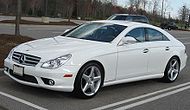 |
|
|
|||
| Т245 B-класс (2005-) | C219 CLS-класс (2004-) | W251 R-класс (2005-) | V251 R-класс (2005-) |
В 2005-м году наступает черед запуска новых моделей S и CL классов ввиду автомобилей W221 и C216. Автомобили, продемонстрировали новый идиом стайлинга марки, включает в себя элементы «ретро» как широкие колёсные арки и более крупные объёмы, дав салону ещё не виданные S-классом габариты. Автомобиль буквально «напихан» самой новейшей технологией и аппаратурой. Флагман серии уже не 600-е модели а S65 и CL65 AMG с мощным двигателям V12.
|
|
|
|
||
| W221 (2005-) | V221 (2005-) | C216 (2006-) |
После обновления S-класса наступает черед C-класса и в начале 2007-го года состоялась премьера нового W204, автомобиль по традиции был стилизован как малая версия S-класса, но и тут качество сборки отличилось. Как и предыдущие поколения, на выбор предлагался седан и универсал. Но три линии исполнения, которые раньше были заметны лишь на опытный глаз, стали сильно отличаться на вкус покупателя. Стандартный Classic, роскошный Elegance (отличившийся более роскошным кожаным салоном и технологией) и спортивный Avantgarde который можно легко отличить по расположенной на центре решетки звезде. В 2008-м году ряд пополнился новым CLC-классом (CLC — Comfort-Leicht-Coupe или легкое комфортное купе). Несмотря на то, что кузов остался прежним — CL203, внешний стайлинг был обновлен под стандарт 204-х.
|
|
|
|
|
|||
| W204 Classic (2007-) | W204 Avantegarde (2007-) | S204 (2007-) | CL203 (2008-) |
Во второй половине 2000-х компания внедряет два новых класса внедорожников. Первая модель внедорожника GL-класса (X164) является удлинённая версия W164-го М-класса. Автомобиль в одно время предназначался для замены Geländewagen’a но по причинам успеха последнего от идеи отказались и автомобиль далее увеличили в размерах (GL — Geländewagen Lang, удлинённый внедорожник), сделав его трёхрядным (вместительность от семи до девяти человек). А в 2008-м году появился, разработанной на базе универсала S204-го С-класса, среднеразмеоный внедорожник GLK-класса (X204). GLK — Geländewagen-Leicht-Kurz то есть укороченный легкий внедорожник.
Мерседес неоднократно пытался войти в почти закрытый мир Гран туризмо, но до 2004-го года его успехи были ограниченными. Но когда в 2000-м году Daimler купил 40 % акций английской компании McLaren, появилась уникальная возможность. McLaren, занимающейся преимущественно Формулой-1, впредь делала успешные GT такие, как McLaren F1. После покупки конструкторы Mercedes-Benz’a и McLaren’a объединились над новым проектом, для которого последние разработали мощнейший двигатель V8 с нагнетателем мощностью 617 л.с. В 2004-м году Суперкар Mercedes-Benz SLR McLaren был готов. Автомобиль С199 был назван в честь легендарного победителя 1955-го мирового чемпионата спортивных автомобилей W196 300SLR. Всего к 2009-му году запланировано выпустить 3500 автомобилей. Причем автомобиль постоянно дорабатывался версией 722 (мощность 641 л.с. назван в честь гоночного номера автомобиля-победителя W196 300SLR) и 722 GT (671 л.с.). Планируется завершить серию 75 автомобилями SLR Stirling Moss, названный в честь гонщика-победителя Стирлинга Мосса, которые будут иметь двери формы «чайка», как были на 300SLR’е.
|
|
|
|
|
|||
| X164 GL-класс (2006-) | X204 GLK-класс (2008-) | C199 SLR (2004—2007) | R199 SLR (2007—2009) |
Мерседес закончил десятилетия пуском нового Е-класса W212 в начале 2009-го года. С новым седаном, на место CLK-класса пришёл и Е-купе (C207) как часть Е-класса (который разработан на базе W204-го С-класса). А в августе появился и универсал S212. Кабриолет A207 будет запущен в 2010-м году. Сама новая семья Е-классов достигла огромных успехов по экономическим и экологическим показателям. На смену открывающим модельный ряд бензинным двигателям с нагнетателями пришли двигатели с новым типом непосредственного впрыска топлива (CGI — Stratified (Charged Gasoline Injection)) с двойным турбонаддувом, и все за исключением флагманских 8-ми цилиндровых моделей, носят значок BlueEfficiency.
|
|
|
|
|
|||
| C207 E-купе (2009-) | W212 E-седан (2009-) | A107 E-кабриолет (2010-) | S212 E-универсал (2009-) |
Рождение автомобиля
- 1883, 1 октября — Карл Бенц основал компанию «Бенц и Ко. Райнише Газмоторен-Фабрик, Манхайм» в форме открытого торгового общества вместе с бизнесменом Максом Каспаром Розе и коммерсантом Фридрихом Вильгельмом Эсслингером.
- 1883, 16 и 23 декабря — Готлиб Даймлер защищает свой «Газовый двигатель с зажиганием от горячей трубки» патентом DRP No. 28022. Также он получает патент DRP No. 28243 на систему «Регулирование скорости двигателя с помощью выпускного клапана» Эти два патента — основа для первого быстроходного двигателя внутреннего сгорания.
- 1885, 29 августа — Даймлер регистрирует Reitwagen («верховая повозка») с «газовым или бензиновым двигателем» как патент DRP No. 36423. «Reitwagen» — всемирный первый цикл двигателя.
- 1886, 29 января — Для своей трёхколесной моторной коляски Карл Бенц получает патент DRP No. 37435 — «свидетельство о рождении» автомобиля.
- 1886 — Карета с мотором Даймлера
В отличие от запатентованной моторной коляски Бенца, первый автомобиль Даймлера был обычной каретой с трёхрычажным управлением — обычная карета, но без лошадей.
- 1888, август — Берта Бенц с её двумя сыновьями Евгением и Ричардом отправляется в первое самое длинное путешествие в автомобильной истории. Она использует запатентованный автомобиль Бенц и проезжает от Mannheim до Pforzheim.
- 1888, 29 сентября — После того, как Даймлер лицензирует пакет для США, изготовитель фортепиано Вильям Стейнвей основывает «Daimler Motor Company» на Long Island в Нью-Йорк
- 1889 — Готлиб Даймлер представляет новый двухцилиндровый V двигатель, поставляющий 1.5 л.с. при 600 об/мин.
- 1889 — Автомобиль Даймлера со стальными колёсами.
Дальнейшее развитие реализовали Даймлер и Майбах благодаря установке стальных колёс и двухцилиндрового V-двигателя.
- 1890, весна — Вильгельм Майбах строит первый 4-цилиндровый, четырёхтактный двигатель. Машина весит 153 кг, поставляет 5 л.с. при 620 об/мин.
- 1890, 28 ноября — Нотариальным сертификатом Stuttgart, был официально зарегистрирован Daimler-Motoren-Gesellschaft (DMG).
- 1892, октябрь — Вильгельм Майбах и Готтлиб Даймлер разрабатывают «Феникс»(Phoenix), который позже будет установлен на легковых машинах, суднах и аэропланах.
- 1893, 26 мая — Британский бизнесмен Фредерик Ричард Симмс открывает «Daimler Motor Syndicate Ltd.» в Лондоне. Хотя он первоначально не производит машины и двигатели, создание знаменует начало Британской автомобильной промышленности.
Карл Бенц получает патент DRP No. 73515 для двойного стержня управления и начинает делать четырёхколесными автомобили «Виктория».
Вильхельм Майбах разрабатывает карбюратор сопла инжекции, предшественника современного карбюратора.
- 1894 — Бенц патентует «Velo-Motorwagen» («Velociped»), первую серию автомобилей в мире.
- 1894, 22 июля — Проезд автомобилей между Парижем и Руаном стал первой гонкой. Стартовал 21 участник , 15 доезжают до конца, включая девять машин с лицензированными двигателями Daimler Panhard-Levassor и 3-hp Бенц «Vis-#-Vis.»
- 1895, 18 марта — Daimler-Motoren-Gesellschaft доставляет в Кронштадт первый в мире грузовик с двухцилиндровым двигателем, мощностью 4 л.с.
- 1897, лето — Daimler-Motoren-Gesellschaft представляет «Phönix». Это первый тип машин с двигателями в передней части.
- 1897, 16 июня — Первое моторизированное такси, Daimler «Виктория» с пометкой «такси», поставляется транспортному предпринимателю в Штутгарт. Фридрих Гринер запускает всемирную первую моторизованную компанию такси.
- Бенц & Ко. разрабатывает первый цилиндр для двигателей, которые Бенц назвал «contra engine» поскольку цилиндры установлены противоположно друг другу.
- Австро-венгерский бизнесмен и дипломат Эмиль Еллинек делает поставку первой машины Daimler под именем своей дочери Мерседес. Елинек также продаёт машины Daimler и продолжает закупать машины с более мощными двигателями от Daimler-Motoren-Gesellschaft.
- 1898, 1 октября — Gesellschaft поставляет первый 4-цилиндровый двигатель для машины Daimler Phönix.
Модельный ряд
Легковые автомобили
Нынешняя классификация легковых автомобилей разработана в середине 90-х годов. Каждый класс (нем Klasse) обозначает тип кузова например: SL — Sport Leicht (Спорт лёгкий, иными словами — родстер); CLK — Comfort-Leicht-Kurz (Комфорт лёгкий короткий — купе среднего размера); G — Geländewagen (Внедорожник) и т. п. На 2008-й год Mercedes-Benz выпускает следующие автомобили:
- А-класс
- B-класс
- C-класс
- CL-класс
- CLC-класс
- CLK-класс
- CLS-класс
- E-класс
- G-класс
- GL-класс
- GLK-класс
- M-класс
- R-класс
- S-класс
- SL-класс
- SLK-класс
- SLR McLaren
- Mercedes-Benz SLS
- Viano
Значимые автомобили
- 1928: SSK легендарный гоночный автомобиль
- 1930: 770 «Grosser Mercedes» торжественный и церемониальный автомобиль
- 1934: 500 K
- 1936: 260 D Первый дизельный автомобиль в мире
- 1938: W195 победитель рекордов скорости
- 1939: T80 должен был установить рекорд скорости на земле
- 1953: «Ponton» Модели
- 1954: 300SL «Gullwing»
- 1959: «Fintail» модели
- 1960: 220SE Кабриолет
- 1963: 600 «Grand Mercedes»
- 1963: Mercedes-Benz 230SL «Pagoda»
- 1965: Mercedes-Benz S-Class
- 1966: 300SEL
- 1969: C111 experimental vehicle
- 1972: Mercedes-Benz W107 350SL
- 1974: 450SEL
- 1974: 240D
- 1975: 280
- 1976: 300D
- 1979: 500SEL и G-Class
- 1983: 190E 2.3-16
- 1986: Первый ‘E-Класс’
- 1991: 600SEL
- 1993: Первый ‘C-Класс’
- 1995: Первый Mercedes-Benz тюнингованный AMG
- 1995: Mercedes-Benz SL73 AMG Самый большой двигатель Mercedes-Benz, 7.3 л V12
- 1996: Mercedes-Benz SL60 AMG очень редкий 6.0л V8, 408 л.с., разгон до «сотни» за 5.1 с
- 1996: Mercedes-Benz RENNtech E7.4RS, самый быстрый дорожный седан
- 1997: Mercedes-Benz M-Class
- 1998: Mercedes-Benz CLK GTR
- 2004: Mercedes-Benz CLK DTM AMG
- 2004: Mercedes-Benz SLR McLaren
- 2004: Mercedes-Benz CLS
- 2007: E320, GL320 Bluetec, ML320 Bluetec, R320 Bluetec
Концепт-кары
- Mercedes-Benz C111 — спорткар с плавником на корме
- Mercedes-Benz Auto 2000 — 4-дверный седан
- Mercedes-Benz NAFA — микроавтомобиль
- Mercedes-Benz C112 — концептуальный спорткар
- Mercedes-Benz F100 — концептуальный минивен, показан в 1991
- Mercedes-Benz F200 Imagination — 2-дверное купе, показанное в 1996 на Парижском автосалоне
- Mercedes-Benz F300 Life Jet — 3-колёсный автомобиль/мотоцикл показанный в 1997 во Франкфуртском автосалоне
- Mercedes-Benz Vario Research Car — 4 автомобиля в одном
- Mercedes-Benz Vision SLR — прототип Mercedes-Benz SLR McLaren, показанный в 1999 на Североамериканском автосалоне
- Mercedes-Benz Vision SLA — открытая версия Vision SLR, показанная в 2000 на Североамериканском автосалоне
- Mercedes-Benz F400 Carving — 2-местный родстер, показанный в 2002 на Токийском автосалоне
- Mercedes-Benz Vision GST — минивэн, прототип R-класса, представленный в 2002 на Североамериканском автосалоне
- Mercedes-Benz F500 Mind — 4-дверный седан, показанный в 2003 на Токийском автосалоне
- Mercedes-Benz F600 Hygenius — компактный автомобиль на топливных элементах, показанный в 2005 на Токийском автосалоне
- Mercedes-Benz Bionic — автомобиль с низким коэффициентом аэродинамического сопротивления, показанный в 2005 на симпозиуме инноваций DaimlerChrysler в Вашингтоне, в основу которого легла тропическая рыбка
- Mercedes-Benz Ocean Drive — 4-дверный кабриолет, на базе S600
- Mercedes-Benz F700 — большой престижный 4-местный седан с экспериментальным экономичным бензино-дизельным двигателем, показанный в 2007 году во Франкфуртском автосалоне
- Mercedes-Benz Vision GLK — прототип GLK-класса с двигателем BLUETEC, показанный в 2008 на Североамериканском автосалоне
- Mercedes-Benz ConceptFASCINATION — трёхдверный хетчбек, представлен публике на Парижском автосалоне в 2008 году.
- Mercedes-Benz BlueZero — серия из трёх концепт-каров (BlueZero E-Cell, BlueZero E-Plus Cell и BlueZero F-Cell), отражающая подход марки к экологически чистым автомобилям. Серия представлена публике на Североамериканском автосалоне в 2009.
- Mercedes-Benz F-CELL Roadster — концепт-кар по мотивам Benz Patent Motorwagen 1886 года
- Mercedes-Benz ESF 2009 — концепт, построенный на базе Mercedes-Benz S400 Hybrid. Представляет собой экспериментальный автомобиль повышенной безопасности.
- Mercedes-Benz F800 Style — концепт, представляющий нити развития «экологичного Мерседеса» — дизельный гибрид и с водородной установкой.
Автобусы
Mercedes-Benz также производит автобусы, преимущественно для Европы и Азии.
Первым заводом, построенным вне Германии после Второй мировой, был завод в Аргентине. На заводе первоначально делали грузовики, многие из которых впоследствии были модифицированы в автобусы, обычно называемые Colectivo. Сегодня на заводе собирают автобусы, грузовые автомобили и Sprinter Van.
Модельный ряд автобусов Mercedes-Benz включает все современные классы автобусов:
- мини-автобусы: Sprinter, Vario, Medio;
- городские модели: Cito, Citaro, Conecto (модификации C,G,O), Capacity;
- пригородные: Integro (серии H, L), Citaro (модификации U, LU, GU, MU), Conecto (модификации U, H, E);
- туристические: Tourino, Travego (модификации RH, RHD, L, M), Tourismo (RHD, SHD), Intouro (RH, RHD).
Фургоны
Мерседес производит широкую гамму фургонов. На сегодняшний день выпускаются:
- Mercedes-Benz Vito — Легкий фургон основанный на базе Mercedes-Benz Viano с грузоподъёмностью около 1 тонны
- Mercedes-Benz Sprinter — среднеразмерный фургон грузоподъёмностью от 2 до 6 тонн (в США и Канаде выпускается под маркой Dodge с названием Freightliner Sprinter Vito. Совместное производство.)
- Sprinter 414/416CDI Скорая Помощь
- Sprinter 316CDI light Скорая Помощь
- Mercedes-Benz Vario — Тяжёлый фургон с грузоподъёмностью сравнимой с малотоннажными грузовиками (7,5 тонн)
Предыдущие модели:
- Mercedes-Benz TN или T1 — Среднеразмерный фургон, предшественник Sprinter
- Mercedes-Benz T2 — Тяжёлый фургон
- Все предыдущие модели на Немецкой Вики
Грузовики
На данный момент Мерседес предлагает следующую гамму грузовых автомобилей:
- Mercedes-Benz Atego — малотоннажная серия грузовиков (грузоподъёмность 7-16 тонн)
- Mercedes-Benz Axor — среднетоннажная серия грузовиков (грузоподъёмность 18-26 тонн), может комплектоваться седельным устройством для полуприцепов
- Mercedes-Benz Actros — многотоннажная серия грузовиков и тягачей полуприцепов (грузоподъёмность 18-50 тонн)
- Mercedes-Benz Econic — низкорамная версия Axor для мусоровозов или узкоспециализированного применения
- Mercedes-Benz Unimog — универсальный грузовик для специального использования (имеется широкая гамма дополнительного навесного оборудования) и транспортировки в экстремальных условиях
- Mercedes-Benz Zetros — грузовик для работы в условиях экстремального бездорожья
- 1828L (F581) — передвижной центр чрезвычайных ситуаций
- 1517L — передвижной центр чрезвычайных ситуаций
Тюнинг
Автомобили Мерседес популярны среди требовательных покупателей, и поэтому несколько компаний занимаются настройкой и доводкой автомобилей этой марки, добавляя больше мощности и комфорта бренду.
- AMG — тюнинговое подразделение Мерседес, специализирующееся на высокомощных версиях автомобилей Мерседес. Двигатели AMG построены вручную, готовые двигатели получают ярлык с подписью инженера, построившего двигатель. AMG полностью принадлежит Мерседесу с 1999 года.
- BRABUS — тюнинговое подразделение, специализирующееся в первую очередь на автомобилях марки Mercedes-Benz, а также других, выпускаемых концерном Daimler AG, автомобилях марки Maybach и Smart.
BRABUS предлагает как простые тюнинг-программы для популярных и недорогих моделей Mercedes-Benz, низкопрофильные покрышки, спойлеры, комплекты аэродинамических обвесов, спойлеры из карбона, кованые диски собственного дизайна, и более серьёзные модернизации, связанные с глубоким вмешательством в техническую начинку автомобилей. Однако, большинство клиентов платят именно за полный тюнинг автомобиля и глубокую модернизацию двигателя, благодаря чему BRABUS и стал известен. Компания строит свои двигатели на базе заводских мерседесовских, переделывая почти все детали.
Mercedes-Benz Center
Музей Mercedes-Benz
Mercedes-Benz Center — большой комплекс учреждений, самое значимое из которых — Музей Mercedes-Benz — автомобильный музей, расположенный в Штутгарте, Германия. В комплекс также входит штаб-квартира Mercedes-Benz. Также к нему можно отнести Мерседес-Бенц-Арена являющееся домашним стадионом футбольного клуба Штутгарт. Штутгарт является родиной марки Mercedes-Benz и штаб-квартиры Daimler AG. Здание, которое стоит сразу за главными воротами фабрики Daimler в Штутгарте-Унтертюркхайме, было разработано компанией UNStudio. Общими очертаниями здание высотой 47,5 м снаружи и внутри напоминает переплетающиеся ленты молекулы ДНК: словно говоря о «фамильных чертах» в новых моделях. Музей открылся 19 мая 2006 года[4].
Впервые музей Mercedes-Benz был открыт в 1936 году в честь 50-летнего юбилея изобретения автомобиля. По прошествии 25 лет музей был расширен и переехал в новое здание на территории завода в Унтертюркхайме. 100-летний юбилей дал толчок к последнему крупному обновлению коллекции[5]
В 2009 году, спустя 3 года после открытия, за свою архитектуру музей получил премию Гуго Гэринга. Этой премией, присуждаемой раз в три года, награждаются образцовые здания в Баден-Вюртемберге.[6].
Журнал Mercedes
Обложка Mercedes-Benz Magazin № 1 за 2008 год
Mercedes-Benz Magazin
Первый номер журнала на русском языке вышел в июле 2002 года. Журнал стал 19 национальным изданием концерна Daimler AG. Журнал знакомит читателей со всеми новейшими моделями и технологиями знаменитой марки. С 2003 года журнал выходит 6 раз в год. В феврале 2004 года во время проведения 5-й церемонии награждения премиями «Автомобильный журналист года» журнал Mercedes стал лучшим корпоративным изданием.
Mercedes-Benz Classic
Первый номер вышел в свет в 2004 г. и выходит раз в год в качестве приложения к журналу Mercedes Magazin. На страницах журнала читатель знакомится с историей марки, автомобилей.
Mercedes-Benz Transport
Журнал посвящен коммерческой технике марки: грузовикам, малотоннажным автомобилям, специальной технике, послепродажному обслуживанию и аксессуарам. Издание знакомит читателей с новой продукцией и с услугами и особенностями эксплуатации коммерческих автомобилей.
Журнал «Mercedes-Benz Transport» выходит на русском языке 4 раза в год.
Mercedes-Benz TV
12 июля 2007 года Mercedes-Benz запустил вещание собственного интернет-телевидения [1]. Премьерный показ состоялся с открытия Берлинской недели моды Mercedes-Benz[7]. Интернет-ТВ вещает на двух языках — немецкий и английский. Ведущая — Таня Бютлер. 15 ноября 2008 стартовал обновленный сервис.[8]
В сувенирной и игровой продукции
Модели в различных масштабах и уровне детализации выпускаются многими фирмами, такими как AUTOArt, Minichamps, Altaya и др. Также во Франции с 1 августа 2007 года выходит журнальная серия, целиком посвященная автомобилям марки — La légende MERCEDES-BENZ (рус. Легенда Mercedes-Benz).
Компьютерные игры с автомобилями Mercedes-Benz:
- Mercedes-Benz Truck racing — гонки на грузовиках
- Mercedes-Benz World Racing — гоночная аркада с большим числом легковых автомобилей марки
- Mercedes-Benz CLC Dream Test Drive — промо-игра, созданная в поддержку Mercedes-Benz CLC-класса
Аксессуары Mercedes-Benz
Компания Mercedes-Benz занимается производством различных аксессуаров со своим наименованием, таких как канцелярские предметы, брелоки и прочее.
Интересные факты
- 9 февраля 1998 года на президента Грузии Эдуарда Шеварнадзе было совершено покушение, когда тот ехал по Тбилиси на автомобиле «Мерседес S600». Бронированный автомобиль спас жизнь президенту, несмотря на то, что автомобиль был обстрелян автоматными очередями, а также выдержал попадание из гранатомета. Основную силу удара принял на себя 12-цилиндровый двигатель.[9][10]
- В фильме Миллионер из трущоб компания Mercedes-Benz потребовала, чтобы её логотипы были убраны из сцен, где действие происходит в трущобах.
- Трёхлучевая звезда на логотипе Мерседес-Бенц, разработанном в 1909 году, символизирует успех марки на суше, в воде и в воздухе. Это объясняется тем, что владелец марки компания Даймлер производила помимо автомобилей судовые и авиационные двигатели. Также трёхлучевая звезда означает триединство автомобиля «Мерседес» для водителя, пассажира и механика.
- В Вёрт-на-Рейне находится, один из крупнейших в мире, завод по производству и сборке грузовиков (3 млн. м², 80 000 единиц/год).[11]
См. также
| Mercedes-Benz на Викискладе? |
- Мерседес-Бенц (автогоночная команда)
- Автобусы Мерседес-Бенц
- Maybach
- Smart
- AMG
- BRABUS
Примечания
- ↑ Список мировых брендов 2010 года
- ↑ Mercedes-Benz Ponton Overview and Production Data © www.mbzponton.org
- ↑ ABS — 30 лет на страже жизни // За рулём : журнал. — М., 2008. — В. 30 апреля.
- ↑ Обзор нового музея Mercedes-Benz (англ.). eMercedesBenz (28 апреля 2006). Архивировано из первоисточника 24 августа 2011. Проверено 6 декабря 2009.
- ↑ Дмитрий Фёдоров Спираль времени. DRIVE.RU (26 июня 2009). Архивировано из первоисточника 24 августа 2011. Проверено 6 декабря 2009.
- ↑ Музей Mercedes-Benz получает премию Гуго Гэринга. Mercedes-Benz. Архивировано из первоисточника 24 августа 2011. Проверено 6 декабря 2009.
- ↑ Интернет-телевидение от Mercedes-Benz
- ↑ (англ.) Mercedes-Benz To Launch New-And-Improved Mercedes-Benz TV 2.0
- ↑ Все о бронеавтомобилях в работе, случаи нападений на бронеавтомобили
- ↑ Нодар Броладзе. Кто охотится на президента. Независимая газета (6 ноября 1999 года). Архивировано из первоисточника 24 августа 2011. Проверено 12 августа 2010.
- ↑ Суперсооружения. Mercedes Overhaul.
Ссылки
- Mercedes-Benz TV (англ.)
- Новости и пресс-релизы в мире Mercedes-Benz (англ.)
- Самый дорогой Mercedes-Benz проданный с аукциона
- Подборка креативной рекламы Mercedes-Benz
| |
|
|---|---|
| Легковые автомобили | Maybach · Mercedes-Benz · Mercedes-AMG · Smart |
| Грузовики | BharatBenz · Detroit Diesel · Freightliner · Master Motors · Mercedes-Benz · Mitsubishi Fuso Truck and Bus Corporation · Sterling trucks · Western Star |
| Автобусы | Master Motors · Mercedes-Benz Türk · Orion · Setra/EvoBus · Thomas Built Buses |
| Фургоны | Mercedes-Benz |
| Принадлежат | Mitsubishi Fuso Truck and Bus Corporation (85%) · Master Motors (80%) · Automotive Fuel Cell Cooperation (50.1%) · Beijing Benz (50%) · Tognum AG (50.0%) · EADS (22.41%) · КАМАЗ (10%) · Tesla Motors (10%) · Tata Motors (7%) |
| Партнёры | Bosch • Mobil |
| Легковые автомобили Mercedes-Benz с 1945 года по настоящее время | |||||||||||||||||||||||||||||||||||||||||||||||||||||||||||||||||
|---|---|---|---|---|---|---|---|---|---|---|---|---|---|---|---|---|---|---|---|---|---|---|---|---|---|---|---|---|---|---|---|---|---|---|---|---|---|---|---|---|---|---|---|---|---|---|---|---|---|---|---|---|---|---|---|---|---|---|---|---|---|---|---|---|---|
| Tип | Класс | 1940-е | 1950-е | 1960-е | 1970-е | 1980-е | 1990-е | 2000-е | 2010-е | ||||||||||||||||||||||||||||||||||||||||||||||||||||||||
| 6 | 7 | 8 | 9 | 0 | 1 | 2 | 3 | 4 | 5 | 6 | 7 | 8 | 9 | 0 | 1 | 2 | 3 | 4 | 5 | 6 | 7 | 8 | 9 | 0 | 1 | 2 | 3 | 4 | 5 | 6 | 7 | 8 | 9 | 0 | 1 | 2 | 3 | 4 | 5 | 6 | 7 | 8 | 9 | 0 | 1 | 2 | 3 | 4 | 5 | 6 | 7 | 8 | 9 | 0 | 1 | 2 | 3 | 4 | 5 | 6 | 7 | 8 | 9 | 0 | 1 |
| Малый класс (B) | A | A (W168) | A (W169) | ||||||||||||||||||||||||||||||||||||||||||||||||||||||||||||||
| Минивэн | B | B (T245) | |||||||||||||||||||||||||||||||||||||||||||||||||||||||||||||||
| Средний класс (D) | CLC | C (CL203) | CLC (CL203-2) | ||||||||||||||||||||||||||||||||||||||||||||||||||||||||||||||
| C | 190 (W201) | C (W202) | C (W203) | C (W204) | |||||||||||||||||||||||||||||||||||||||||||||||||||||||||||||
| CLK | CLK (W208) | CLK (W209) | |||||||||||||||||||||||||||||||||||||||||||||||||||||||||||||||
| Бизнес-класс (E) | E | 170 (W136) |
180 — 190 (W120/W121) |
190 — 230 (W110) |
200 — 280E (W114/W115) |
200 — 300D (W123) |
200 — 500E / E (W124) |
E (W210) | E (W211) | E (W212) | |||||||||||||||||||||||||||||||||||||||||||||||||||||||
| E Coupé | 250C — 280CE (W114) | 230C — 300CD (C123) | 230CE — 320CE / E Coupé (C124/A124) | E Coupé (W207) | |||||||||||||||||||||||||||||||||||||||||||||||||||||||||||||
| CLS | CLS (C219) | CLS (C218) | |||||||||||||||||||||||||||||||||||||||||||||||||||||||||||||||
| Представительский класс (F) | S | 220 (W187) | 219 (W105) | 220b — 220SEb (W111) | |||||||||||||||||||||||||||||||||||||||||||||||||||||||||||||
| 220a/S (W180)/ 220SE (W128) |
300SE (W112) | S (W220) | S (W221) | ||||||||||||||||||||||||||||||||||||||||||||||||||||||||||||||
| CL | 300S/300Sc (W188) | CL (C215) | CL (C216) | ||||||||||||||||||||||||||||||||||||||||||||||||||||||||||||||
| Лимузин | — | 300 (W186/W189) | 600 (W100) | Maybach 57 (W240) и Maybach 62 (V240) | |||||||||||||||||||||||||||||||||||||||||||||||||||||||||||||
| Родстер | SLK | SLK (R170) | SLK (R171) | SLK (R172) | |||||||||||||||||||||||||||||||||||||||||||||||||||||||||||||
| SL | 190 SL (R121) | 230 SL — 280 SL (W113) | 280 SL — 560 SL (R107) | 280 SL — 600 SL / SL (R129) | SL (R230) | ||||||||||||||||||||||||||||||||||||||||||||||||||||||||||||
| 300 SL (W198) | 280 SLC — 500 SLC (C107) | ||||||||||||||||||||||||||||||||||||||||||||||||||||||||||||||||
| Гран Туризмо | SLR | CLK GTR | SLR (C199) | SLS (C197) | |||||||||||||||||||||||||||||||||||||||||||||||||||||||||||||
| Минивэн | R | 170S (W191) | R (W251) | ||||||||||||||||||||||||||||||||||||||||||||||||||||||||||||||
| Кроссовер | GLK | GLK (X204) | |||||||||||||||||||||||||||||||||||||||||||||||||||||||||||||||
| M | ML (W163) | ML (W164) | |||||||||||||||||||||||||||||||||||||||||||||||||||||||||||||||
| GL | GL (X164) | ||||||||||||||||||||||||||||||||||||||||||||||||||||||||||||||||
| Внедорожник | G | G (W460) | G (W461) | ||||||||||||||||||||||||||||||||||||||||||||||||||||||||||||||
| G (W463) | |||||||||||||||||||||||||||||||||||||||||||||||||||||||||||||||||
| Комби | — | Vaneo (W414) | |||||||||||||||||||||||||||||||||||||||||||||||||||||||||||||||
| Микроавтобус | Viano/ Vito | L 206 | MB 100 | V / Vito (W638) | Viano / Vito II (W639) | ||||||||||||||||||||||||||||||||||||||||||||||||||||||||||||
| Sprinter | T1 | Sprinter (W901-905) | Sprinter (W906) | ||||||||||||||||||||||||||||||||||||||||||||||||||||||||||||||
| Vario | L319 | T2 | T2 (2.Gen.) | Vario (W670) |
Всего найдено: 22
Подскажите, пожалуйста, как пишется «шестисотый мерседес» в предложении: Он подарил ей _шестисотый_мерседес_ Спасибо.
Ответ справочной службы русского языка
Корректно: шестисотый «мерседес» и (в бытовом употреблении) шестисотый мерседес.
Здравствуйте! Подскажите, пожалуйста, как правильно согласовывать по роду прилагательные и глаголы с названиями иностранных марок автомобилей? Например: новый Nissan Teana или новая Nissan Teana; проехал Skoda Rapid или проехала Skoda Rapid? Спасибо.
Ответ справочной службы русского языка
Если марку и модель автомобиля можно отнести к одному грамматическому роду, то согласование, как правило, не испытывает колебаний: бюджетная «Шкода-Фабиа», надежный «УАЗ-Патриот», раздолбанный «Мерседес-Спринтер», переднеприводная «Лада-Калина». Если название марки и название модели относятся к разному грамматическому роду, то можно сказать: новый «Ниссан-Теана» и новая «Ниссан-Теана», проехал «Шкода-Рапид» и проехала «Шкода-Рапид».
Как правильно пишутся названия зарубежных автомобилей (Ford, Форд или «форд»)?
Ответ справочной службы русского языка
Вот основные правила.
Справочники рекомендуют писать названия марок автомобилей в кавычках с прописной буквы: автомобили «Волга», «Вольво», «Ниссан», «Шкода», а названия самих автомобилей как технических изделий – со строчной буквы в кавычках (кроме названий, совпадающих с собственными именами – личными и географическими). Например: «кадиллак», «москвич», «тойота», «ниссан», но: «Волга», «Ока» (совпадают с именами собственными, поэтому пишутся с большой буквы). Исключения: «жигули», «мерседес» (совпадают с именами собственными, но пишутся со строчной). Однако на практике различить, в каком случае наименование представляет собой название марки автомобиля, а в каком – наименование технического изделия, часто представляется затруднительным: Всем автомобилям он предпочитает «Тойоту» / «тойоту». В спорных случаях решение о написании с прописной или строчной буквы принимает автор текста.
Названия, написанные латиницей, в кавычки не заключаются: автомобили Toyota Yaris, Peugeot 306, Daewoo Matiz, Škoda Fabia, Lada Priora.
Неоднословные названия (марка и модель автомобиля), написанные кириллицей, пишутся через дефис, при этом все части наименования пишутся с прописной буквы: «Лада-Приора», «Тойота-Королла», «Рено-Меган», «Ниссан-Теана», «Хёндай-Гетц», «Ниссан-Альмера-Классик», «Сузуки-Гранд-Витара». Но: «Фольксваген-жук» (перекличка с нарицательным существительным).
Аббревиатурные названия пишутся без кавычек: ЗИЛ, ВАЗ, КамАЗ.
В бытовом употреблении названия средств передвижения пишутся без кавычек, например: Приехал на стареньком москвиче (на роскошном кадиллаке). Без кавычек пишутся также разговорные названия машин с уменьшительно-ласкательными суффиксами, напр.: москвичок, фордик, уазик.
Здравствуйте! Подскажите, пожалуйста, как правильно оформляются названия марок машин, отечественных и зарубежных (прописная или строчная, кавычки? в т.ч. в таких случаях, как: автомобили марки ВАЗ. Благодарю Вас
Ответ справочной службы русского языка
Справочники рекомендуют писать названия марок автомобилей в кавычках с прописной буквы: автомобили «Волга», «Вольво», «Ниссан», «Шкода», а названия самих автомобилей как технических изделий – со строчной буквы в кавычках (кроме названий, совпадающих с собственными именами – личными и географическими). Например: «кадиллак», «москвич», «тойота», «ниссан», но: «Волга», «Ока» (совпадают с именами собственными, поэтому пишутся с большой буквы). Исключения: «жигули», «мерседес» (совпадают с именами собственными, но пишутся со строчной). Однако на практике различить, в каком случае наименование представляет собой название марки автомобиля, а в каком – наименование технического изделия, часто представляется затруднительным: Всем автомобилям он предпочитает «Тойоту» / «тойоту». В спорных случаях решение о написании с прописной или строчной буквы принимает автор текста.
Названия, написанные латиницей, в кавычки не заключаются: автомобили Toyota Yaris, Peugeot 306, Daewoo Matiz, Škoda Fabia, Lada Priora.
Неоднословные названия (марка и модель автомобиля), написанные кириллицей, пишутся через дефис, при этом все части наименования пишутся с прописной буквы: «Лада-Приора», «Тойота-Королла», «Рено-Меган», «Ниссан-Теана», «Хёндай-Гетц», «Ниссан-Альмера-Классик», «Сузуки-Гранд-Витара». Но: «Фольксваген-жук» (перекличка с нарицательным существительным).
Аббревиатурные названия пишутся без кавычек: ЗИЛ, ВАЗ, КамАЗ.
В бытовом употреблении названия средств передвижения пишутся без кавычек, например: Приехал на стареньком москвиче (на роскошном кадиллаке). Без кавычек пишутся также разговорные названия машин с уменьшительно-ласкательными суффиксами, напр.: москвичок, фордик, уазик.
Как правильно произносится название машины «мерседес«: МЕ или МЭ? Спасибо.
Ответ справочной службы русского языка
Согласный М произносится мягко.
правильно ли: «мерседес«, джип, «Запорожец», «газик»
Ответ справочной службы русского языка
Правильно: «мерседес», «запорожец», джип, газик. В бытовом употреблении возможно написание без кавычек и слов мерседес, запорожец.
как правильно писать марки автомобилей — с прописной или строчной, в кавычках или нет
Ответ справочной службы русского языка
Приводим рекомендации из рубрики «Письмовник» нашего портала:
Справочники рекомендуют писать названия марок автомобилей в кавычках с прописной буквы: автомобили «Волга», «Вольво», «Ниссан», «Шкода», а названия самих автомобилей как технических изделий – со строчной буквы в кавычках (кроме названий, совпадающих с собственными именами – личными и географическими). Например: «кадиллак», «москвич», «тойота», «ниссан», но: «Волга», «Ока» (совпадают с именами собственными, поэтому пишутся с большой буквы). Исключения: «жигули», «мерседес» (совпадают с именами собственными, но пишутся со строчной). Однако на практике различить, в каком случае наименование представляет собой название марки автомобиля, а в каком – наименование технического изделия, часто представляется затруднительным: Всем автомобилям он предпочитает «Тойоту» / «тойоту». В спорных случаях решение о написании с прописной или строчной буквы принимает автор текста.
Названия, написанные латиницей, в кавычки не заключаются: автомобили Toyota Yaris, Peugeot 306, Daewoo Matiz, Škoda Fabia, Lada Priora.
Неоднословные названия (марка и модель автомобиля), написанные кириллицей, пишутся через дефис, при этом все части наименования пишутся с прописной буквы: «Лада-Приора», «Тойота-Королла», «Рено-Меган», «Ниссан-Теана», «Хёндай-Гетц», «Ниссан-Альмера-Классик», «Сузуки-Гранд-Витара». Но: «Фольксваген-жук» (перекличка с нарицательным существительным).
Аббревиатурные названия пишутся без кавычек: ЗИЛ, ВАЗ, КамАЗ.
В бытовом употреблении названия средств передвижения пишутся без кавычек, например: Приехал на стареньком москвиче (на роскошном кадиллаке). Без кавычек пишутся также разговорные названия машин с уменьшительно-ласкательными суффиксами, напр.: москвичок, фордик, уазик.
Здравствуйте!
У нас возник спор. Обьясните пожалуйста, почему машину Мерседес все называют в мужском роде(белый мерседес — а не белая, мой — а не моя)? Причем везде: на экране, протоколе, в жизни?
Как известно, Мерседес — довольно популярное женское имя .Создатель машины Готтлиб Даймлер так назвал в честь своей дочери.
Ни в каких языках это имя мужским не называется. Или было какое то специальное постановление ,обязывающее женское имя применительно к автомашине считать мужским?
Ведь не говорят же; МОЙ ЛАДА, МОЙ ВОЛГА, ШКОДА, ЧАЙКА и пр.
Спасибо заранее.
Владимир.
Ответ справочной службы русского языка
Дело в том, что слово мерседес формально — существительное второго школьного склонения, это существительное изменяется по падежам, подобно словам дом, стол. В русском языке склоняемые слова, оканчивающиеся на твердый согласный, принадлежат мужскому роду. Поэтому отнесение «мерседеса» к мужскому роду — это не что иное, как действие грамматической аналогии.
Заметьте, если бы в русском языке слово мерседес не склонялось, решить вопрос о его родовой принадлежности было бы сложнее (например, имя Мерседес не склоняется; мы относим это слово к женскому роду лишь потому, что знаем: это имя женское; у нас нет собственно грамматических оснований для определения рода).
Обратите внимание: в рубрике «Письмовник» на нашем портале размещена статья, посвященная грамматическому роду существительных.
http://gramota.ru/spravka/letters/?rub=gender
Хотелось бы узнать, как правильно в тексте указывать марку машины, например ниссан. В кавычках или без, с маленькой или большой буквы?
Ответ справочной службы русского языка
Справочники рекомендуют писать названия марок автомобилей в кавычках с прописной буквы: автомобили «Волга», «Вольво», «Ниссан», «Шкода», а названия самих автомобилей как технических изделий – со строчной буквы в кавычках (кроме названий, совпадающих с собственными именами – личными и географическими). Например: «кадиллак», «шкода», «тойота», «ниссан», но: «Волга», «Ока» (совпадают с именами собственными, поэтому пишутся с большой буквы). Исключения: «жигули», «мерседес» (совпадают с именами собственными, но пишутся со строчной). Однако на практике различить, в каком случае наименование представляет собой название марки автомобиля, а в каком – наименование технического изделия, часто представляется затруднительным: Всем автомобилям он предпочитает «Тойоту» / «тойоту». В спорных случаях окончательное решение о написании с прописной или строчной буквы принимает автор текста.
То и дело сталкиваешься с названиями автомобилей. Как их писать? Ни один из справочников и учебников (в т.ч. Розенталь) не дает однозначного ответа. Форд или форд? «Форд» или «форд»? А как, к примеру, писать форд эксплорер 517 JP?
Спасибо
С уважением А.Н.
Ответ справочной службы русского языка
Справочники рекомендуют писать названия марок автомобилей в кавычках с прописной буквы: автомобили «Волга», «Вольво», «Ниссан», «Шкода», а названия самих автомобилей как технических изделий – со строчной буквы в кавычках (кроме названий, совпадающих с собственными именами – личными и географическими). Например: «кадиллак», «москвич», «тойота», «ниссан», но: «Волга», «Ока» (совпадают с именами собственными, поэтому пишутся с большой буквы). Исключения: «жигули», «мерседес» (совпадают с именами собственными, но пишутся со строчной). Однако на практике различить, в каком случае наименование представляет собой название марки автомобиля, а в каком – наименование технического изделия, часто представляется затруднительным: Всем автомобилям он предпочитает «Тойоту» / «тойоту». В спорных случаях решение о написании с прописной или строчной буквы принимает автор текста.
Названия, написанные латиницей, в кавычки не заключаются: автомобили Toyota Yaris, Peugeot 306, Daewoo Matiz, Škoda Fabia, Lada Priora.
Неоднословные названия (марка и модель автомобиля), написанные кириллицей, пишутся через дефис, при этом все части наименования пишутся с прописной буквы: «Лада-Приора», «Тойота-Королла», «Рено-Меган», «Ниссан-Теана», «Хёндай-Гетц», «Ниссан-Альмера-Классик», «Сузуки-Гранд-Витара». Но: «Фольксваген-жук» (перекличка с нарицательным существительным).
Аббревиатурные названия пишутся без кавычек: ЗИЛ, ВАЗ, КамАЗ.
В бытовом употреблении названия средств передвижения пишутся без кавычек, например: Приехал на стареньком москвиче (на роскошном кадиллаке). Без кавычек пишутся также разговорные названия машин с уменьшительно-ласкательными суффиксами, напр.: москвичок, фордик, уазик.
См.:
Подскажите, пожалуйста, как правильно писать слово тойота – в кавычках или без кавычек, с прописной или со строчной буквы?
slavyanka
Ответ справочной службы русского языка
Справочники рекомендуют писать названия марок автомобилей в кавычках с прописной буквы: автомобили «Волга», «Вольво», «Ниссан», «Шкода» «Тойота», а названия самих автомобилей как технических изделий – со строчной буквы в кавычках (кроме названий, совпадающих с собственными именами – личными и географическими). Например: «кадиллак», «москвич», «тойота», «ниссан», но: «Волга», «Ока» (совпадают с именами собственными, поэтому пишутся с большой буквы). Исключения: «жигули», «мерседес» (совпадают с именами собственными, но пишутся со строчной). Однако на практике различить, в каком случае наименование представляет собой название марки автомобиля, а в каком – наименование технического изделия, часто представляется затруднительным: Всем автомобилям он предпочитает «Тойоту» / «тойоту». В спорных случаях решение о написании с прописной или строчной буквы принимает автор текста.
Как правильно — «черный мерседЕс» или «черная мерсЕдес«?
Ответ справочной службы русского языка
Об автомобиле верно: черный мерседес.
Как склоняются названия автомобилей?
К примеру, «Лит Айс».
Ответ справочной службы русского языка
Приведенный вариант лучше не склонять. В остальных случаях возможно: на мерседесе, на москвиче.
ПРи написании брендов, в частности названий машин, латиницей мы не ставим кавычки: например, приехал на Mazd’e, но, если кириллицей «Мазда» — в словарях дается такое написание — в кавычках со строчной буквы: «мерседес«, «волга», «жигули». Как правильно? А если ГАЗ-25? Как правильно: ЗиС или ЗИС, ЗиЛ или ЗИЛ? (дается и такое и такое написание). То же с названиями фирм: если латиница, то часто дается без кавычек, если кириллица — в кавычках. Как правильно?
Ответ справочной службы русского языка
Об употреблении кавычек в собственных наименованиях см. в «Письмовнике».
Пожалуйста, развейте сомнения: продолжает ли действовать правило, по которому названия марок советских (и, соответственно, российских) автомобилей пишутся с прописной буквы и заключаются в кавычки, а названия марок иностранных автомобилей пишутся в кавычках со строчной – «кадиллак», «джип», «мерседес»? Как следует писать название марки с указанием модели? Например, «форд-Эскорт», «тойота-Лэндкрузер»?
Ответ справочной службы русского языка
Нет, такого правила сейчас никто не придерживается. О нормах, действующих в современном русском письме, см. ответ № 224934 .





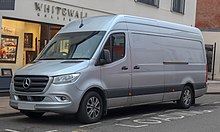



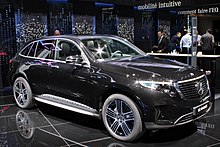

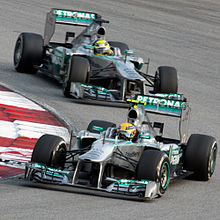
![1909–1916[note2 1]](https://upload.wikimedia.org/wikipedia/commons/thumb/6/6f/Mercedes_brand_logo_1909.png/100px-Mercedes_brand_logo_1909.png)
![1909–1916[note2 1]](https://upload.wikimedia.org/wikipedia/commons/thumb/2/2a/Mercedes_benz_logo_1909.png/100px-Mercedes_benz_logo_1909.png)
![1916–1926[note2 1]](https://upload.wikimedia.org/wikipedia/commons/thumb/e/e3/Mercedes_benz_logo_1916.png/100px-Mercedes_benz_logo_1916.png)



